


Rail presents an opportunity for global electrification LEARN MORE Sustainable mobility services with E-scooters READ NOW Switching to life with EVs hinges on charging infrastructure LEARN MORE Will hackers gain access to drivers’ data via EVs? READ NOW FORMULA E: THROUGH ELECTRIFICATION OVERTAKING CLIMATE CHANGE
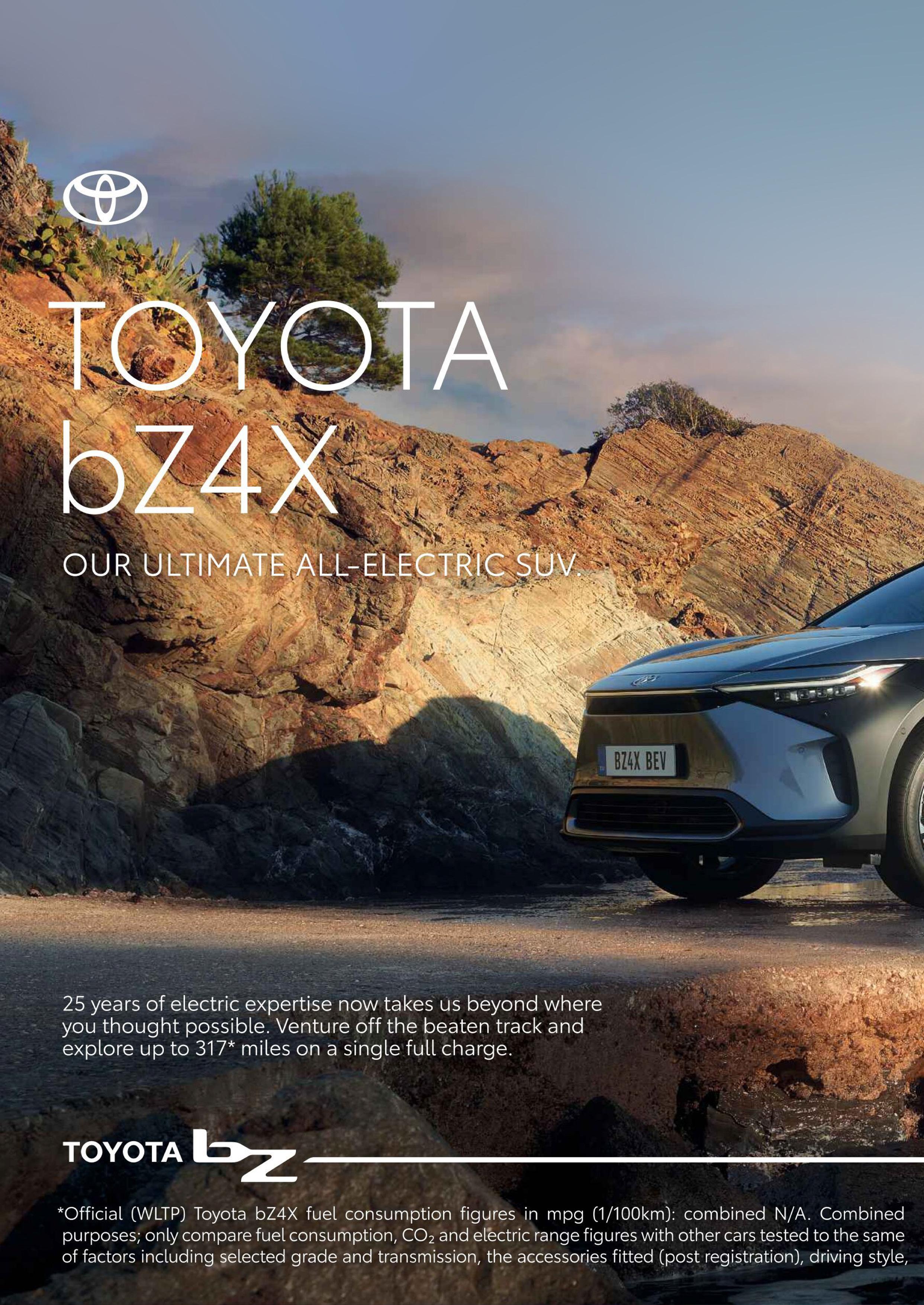

EDITOR-IN-CHIEF TOM SWALLOW MANAGING EDITOR NEIL PERRY
CHIEF CONTENT OFFICER SCOTT BIRCH
CHIEF DESIGN OFFICER MATT JOHNSON

GRAPHIC DESIGNER SAM HUBBARD VIDEO PRODUCTION MANAGER KIERAN WAITE
PROJECT DIRECTOR THOMAS LIVERMORE MARKETING MANAGER KAYLEIGH SHOOTER CEO GLEN WHITE
CATCH THE LATEST UPDATES AND RECEIVE EV NEW INSIGHTS
SUBSCRIBE
WELCOME
A new year and lots more room for innovation. 2023 is going to be another big year in the history of sustainability and electrification.
Formula E will return its 9th season with its most powerful, efficient car yet. This will create new and exciting opportunities that will be echoed throughout the automotive industry and be leveraged by manufacturers of the latest and greatest EVs.
I’m also excited to see what the future holds for aviation and other, somewhat ‘underrated’, forms of electric transport, specifically how both hydrogen and electric may work alongside each other to bridge the gap between range anxiety and sustainability success.
TOM SWALLOW EDITOR-IN-CHIEF
 tom.swallow@bizclikmedia.com
tom.swallow@bizclikmedia.com
EVMAGAZINE.COM [Jan 2023] 5
NEW YEARS' EVOLUTION EV MAGAZINE IS PUBLISHED BY © 2023 | ALL RIGHTS RESERVED
As we look back on 2022, and forward to 2023, the electrification journey has only just begun.


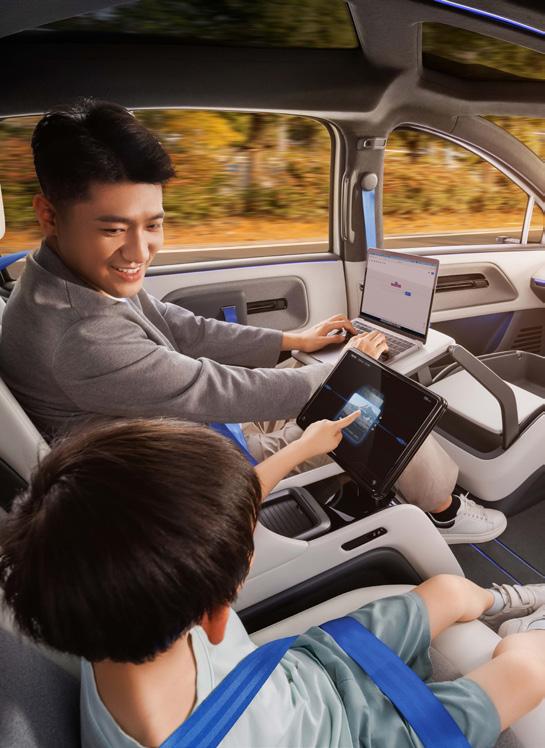






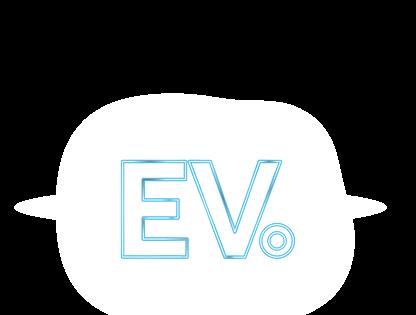
JAN 2023 UP FRONT 08 BIG PICTURE Autonomy will prevail in 2023 010 EXPLAINED EV battery cooling: Why is it so important? 012 EV IN FOCUS Marrying ultra-premium quality and sustainability in a single EV 016 INTERVIEW Hazim Nada CEO of AEHRA 020 DIGEST 6 [Jan 2023] EVMAGAZINE.COM 016 012 RIVIAN Sustainable electric vechile adventure drive by procurement 042 08 102

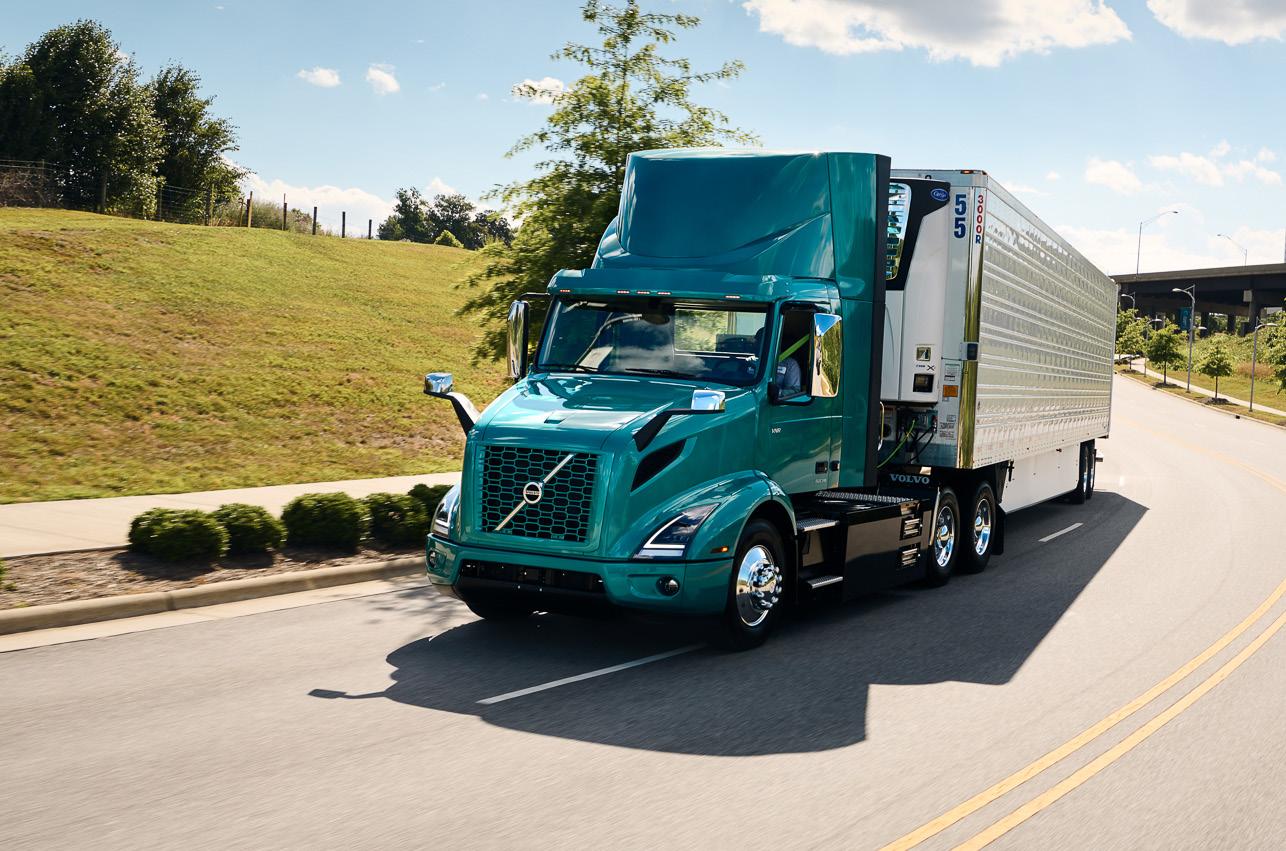


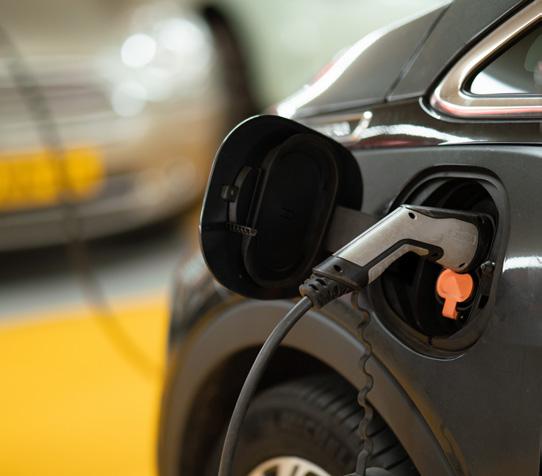

FEATURES 024 COVER STORY Formula E: Overtaking climate change through electrification 034 CONNECTED CAR Will hackers gain acces to drivers’ data via EVs? 060 CHARGING & INFRASTRUCTURE Switching to life with EVs hinges on charging infrastructure 068 FLEET & COMMERCIAL Rail presents an opportunity for global electrification 076 MOBILITY Sustainable mobility services with E-scooters 086 TOP TEN Companies electrifying commercial vehicles 102 EV MAGAZINE LIVE Join us for an EVening like no other discussing 'The Future of EV' — live streamed from The London Transport Museum EVMAGAZINE.COM [Jan 2023] 7 024 86 068 076 060 034
UP FRONT
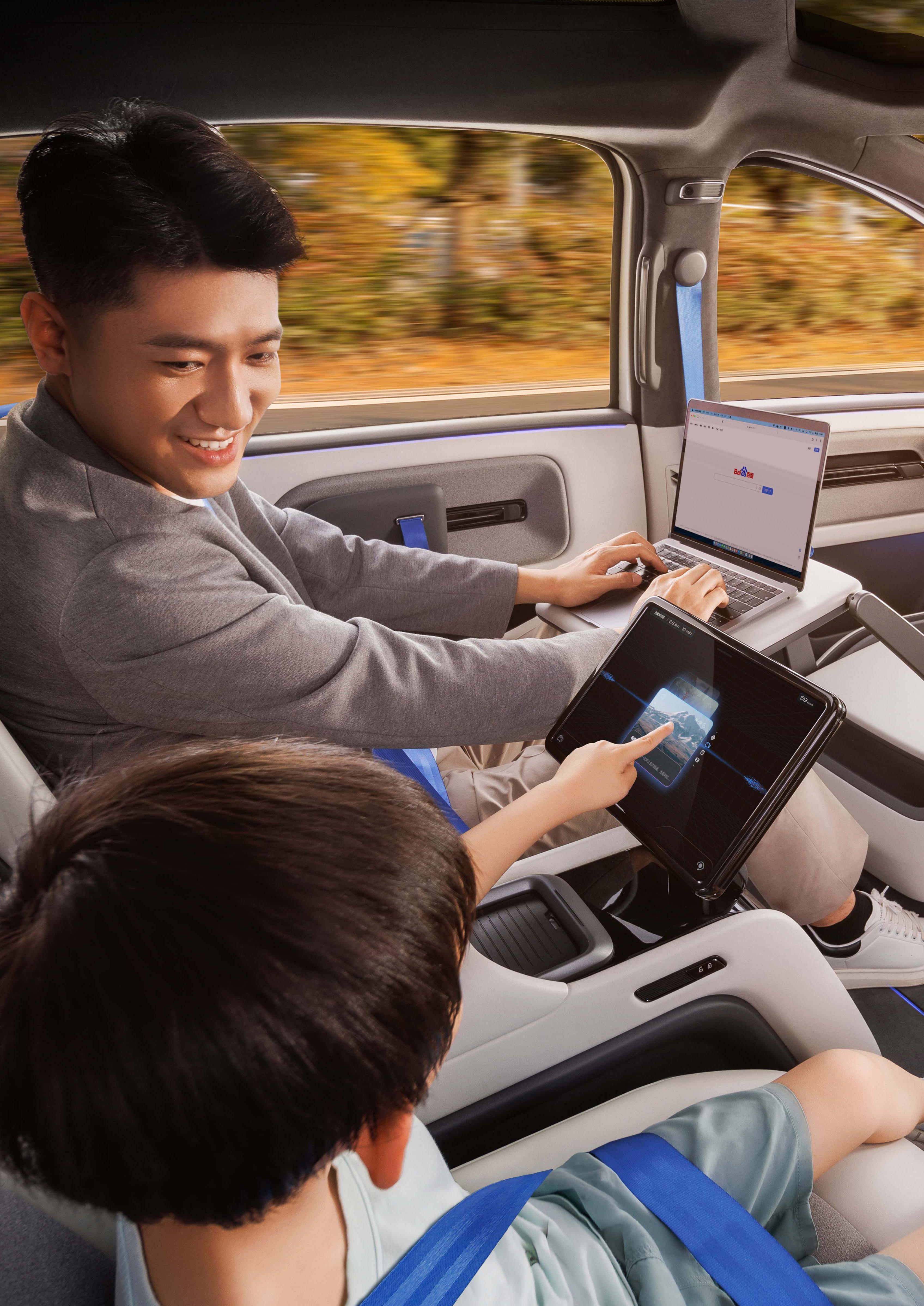
PREVAIL
AUTONOMY WILL PREVAIL IN 2023
Autonomy is looking ever-more likely as we enter a new year of electrification innovation and triumph. While technology firms race to be the first to full automation, it seems they are one step closer to achieving it.
Announced in mid-2022 at the company’s Baidu World 2022 technology conference, Baidu’s Apollo RT6 is an autonomous taxi concept that could revolutionise mobility for the future to come, and the company believes the car will be operational in 2023. It will achieve Level 4 autonomy— the closest possible solution that still gives the driver the power to override the EV. aspects, keep people and cargo safe.
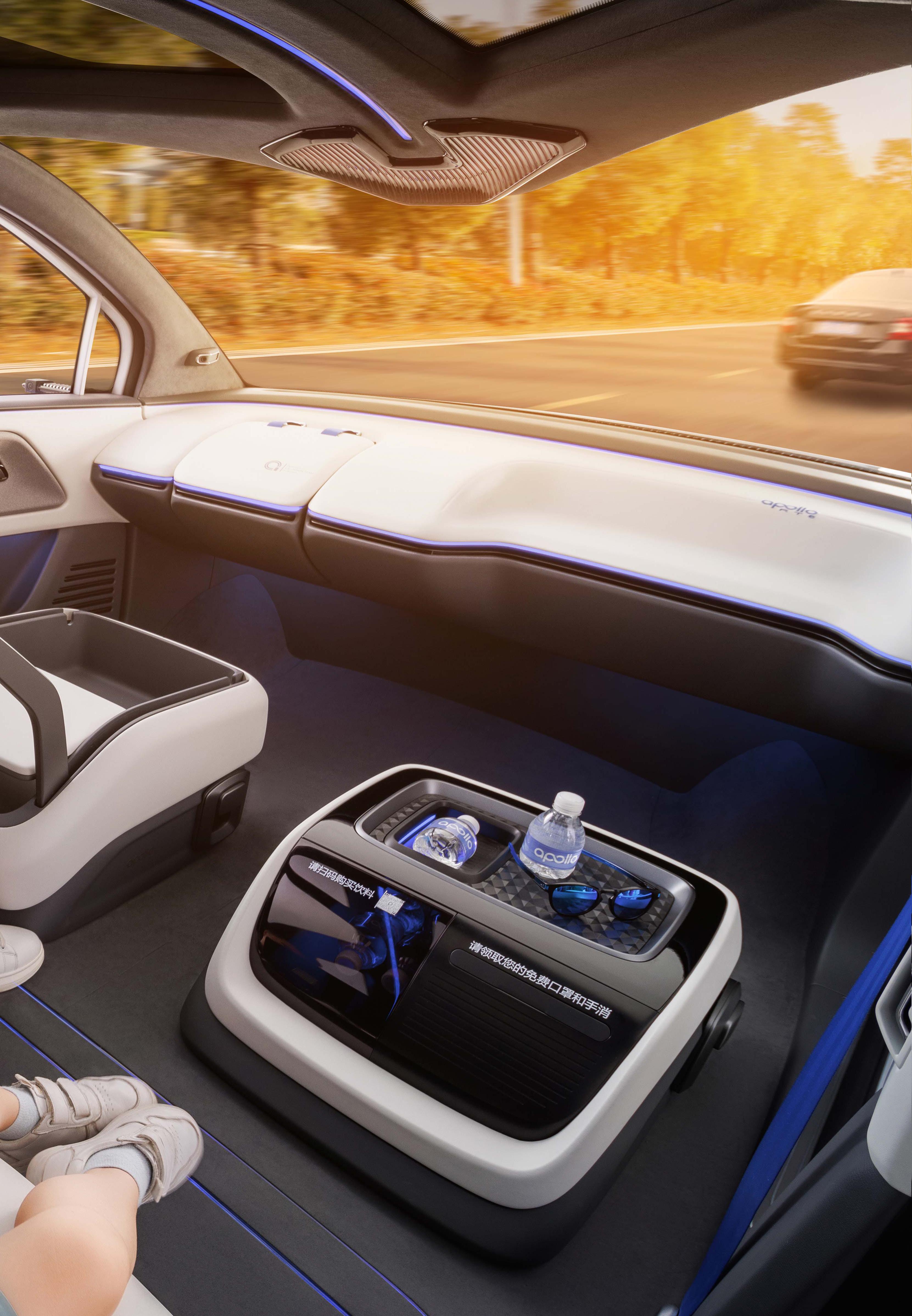
FRONT
INTERVIEW | DIGEST
BIG PICTURE | EXPLAINED | EV IN FOCUS |
EVMAGAZINE.COM [Jan 2023] 9
EV BATTERY COOLING: WHY IS IT SO IMPORTANT?
It’s no new concept. Heating and cooling create a fine balance between efficiency and inefficiency, determining the optimal conditions for maximum power output, and will also affect the longevity of an electric vehicle’s (EV’s) battery.
Cooling in an internal combustion engine (ICE) is a critical process, as well as in EVs—although a more advanced system can manage it more effectively. Now that cars are becoming more digital, adopting artificial intelligence (AI) to manage the processes that are integral for upholding their specifications, temperature is easier to manage.
Understanding the different cooling system types gives more appreciation to the solutions that are now more commonly used in EVs.
First, there’s air cooling, which, unsurprisingly, uses air to cool the battery. This can be either active or passive, meaning the car either draws air from outside or in the cabin (passive), or will
be supported by a heating, ventilation, and air conditioning (HVAC) system (active). Often, the latter solution uses no more than 1kW of cooling and can also be used to heat or cool the cabin. The components that power the EV, such as the HVAC system, motor, inverter, and battery, are optimised by a battery thermal management system (BTMS).
The alternative option—one that is used in the majority of EVs—is liquid cooling. This is the process of using liquid coolant, either water, a refrigerant, or ethylene glycol, to reduce the temperature of the battery.
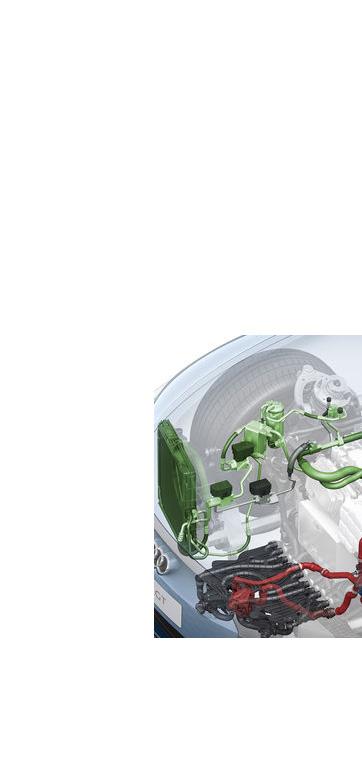
10 [Jan 2023] EVMAGAZINE.COM
The coolant liquid passes through tubes and cooling plates to distribute the cooling properties safely among the electrical components, carrying the residual heat to another component of the car, like a radiator or heat exchanger.

TEMPERATURE AFFECTS EV FUNCTION AND CHARGING
EV batteries are capable of operating in relatively extreme temperatures. The case of heating and cooling is to optimise its
During use, thermal management systems are pretty robust, but they can also be susceptible to ageing components, corrosion, leakage, and blockages. While the concept of heating and cooling is almost the same for every EV, each company has their own take on how best to apply it to their cars.
EXPLAINED
EVMAGAZINE.COM [Jan 2023] 11
AEHRA MARRYING ULTRA-PREMIUM QUALITY AND SUSTAINABILITY IN A SINGLE EV

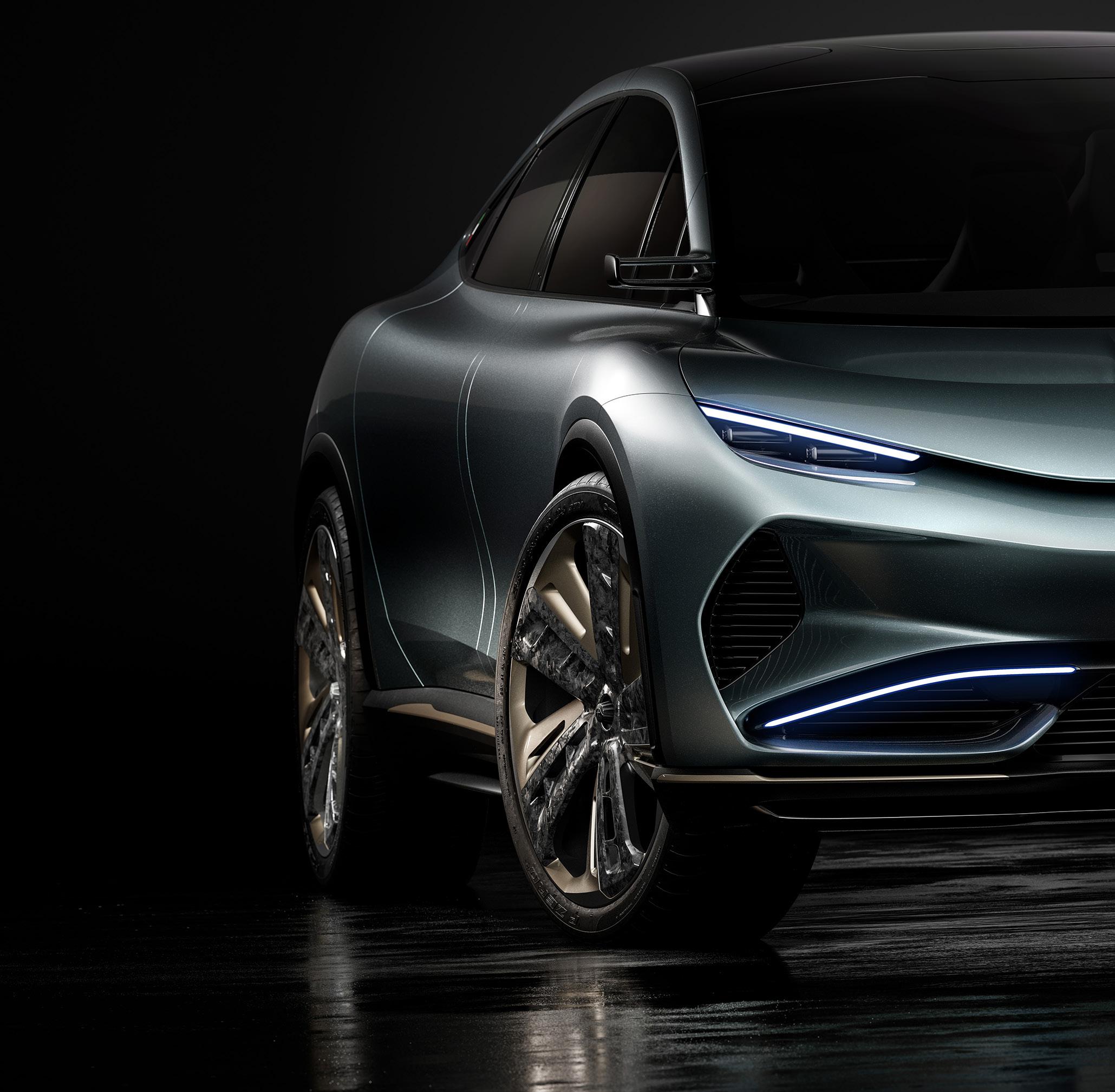
The AEHRA SUV is the brainchild of both an idealistic leader and designers with decades of experience in the automotive industry. Filippo Perini, Chief Design Officer at AEHRA, and Head of Design Alessandro Serra, come from backgrounds of prestige, having worked for high-end car makers Lamborghini and Genesis, as well as the company Italdesign—to name a few.
The latest challenge faced by these prestigious designers saw them throwing out the rule book as they focused on a design that would reinvent the style and function of the EV.
The AEHRA SUV takes the experience of the two designers and the initial vision of

Nada, and amalgamates them into an EV inspired by supercar design with an elegant, sustainable focus.
The car is compressed at the front to allow more space for the driver and passengers, who gain ample room to relax in the 3m long vehicle. Stretching the wheelbase of the car gives the car a stance like no other on the market while creating a more pleasurable experience throughout. This was achieved through in-depth analysis of highly-sought-after cars and their silhouettes to establish the current trends in automotive design, which allowed the team to gain a fresh perspective on what the vehicle should look like.
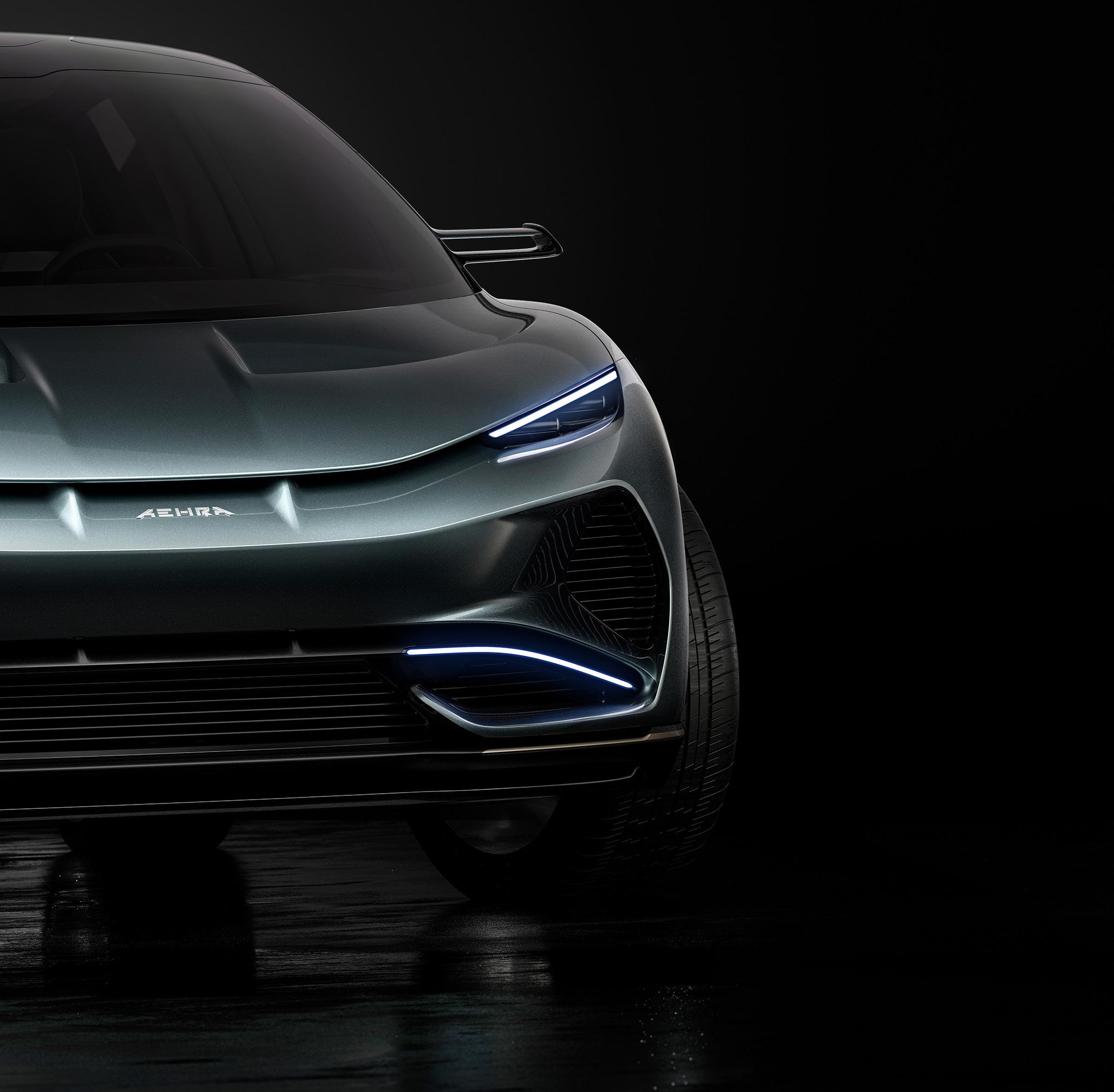
EV IN FOCUS EVMAGAZINE.COM [Jan 2023] 13
As a startup, the emphasis has been on sustainability but also the cost of development. Looking at the project as an open brief, however, allows the designers to come up with something that fulfils the purpose of an EV of the future—despite the blockage faced as professionals that are used to working with constraints.

“We were starting literally from a clean sheet,” says Perini. “The first thing we did was create our own package, because we know exactly how to do it. To have something that is 95% functional.”
“We imposed on ourselves the limitations and the timeframe to create a car, not just a concept.”
As mentioned by Serra, the team is not so concerned with the replication of its ideas, but would in fact take pride in the progress the car has led to in changing the development mindset of other manufacturers.
“It may be refused, copied, we don’t know. But it fills us with pride to say that we’ve pushed some limits,” Serra explains.
THE EV WITH HOPES TO SHAKE THINGS UP
Beyond its impressive, elegant design, the AEHRA SUV is set to be unrivalled in the automotive industry. One of its greatest features can be found under the paintwork. The EV uses carbon fibre SMC, which leverages an abundant material in the land of highspeed automobile manufacturing.
Using recycled carbon fibre not only reduces the weight of the vehicle—making it 50% lighter and 10% more air efficient—but also allows the vehicle to be recycled up to five times.
"THE FIRST THING WE DID WAS CREATE OUR OWN PACKAGE, BECAUSE WE KNOW EXACTLY HOW TO DO IT"
The car boasts an expected range of up to 497 miles (800km) per charge, using a 120kW/h battery and achieving power between 550kW-600kW.
As built into the vehicle, the team brings forth a new experience with a cabin that’s capable of seating four NBA players comfortably while allowing the owner to enjoy a unique driving experience. Perini believes that the AEHRA SUV is a car to be enjoyed and brings new life to the EV industry, revalling the excitement of the sound, speed, and performance of fossilfuel-powered vehicles.

14 [Jan 2023] EVMAGAZINE.COM
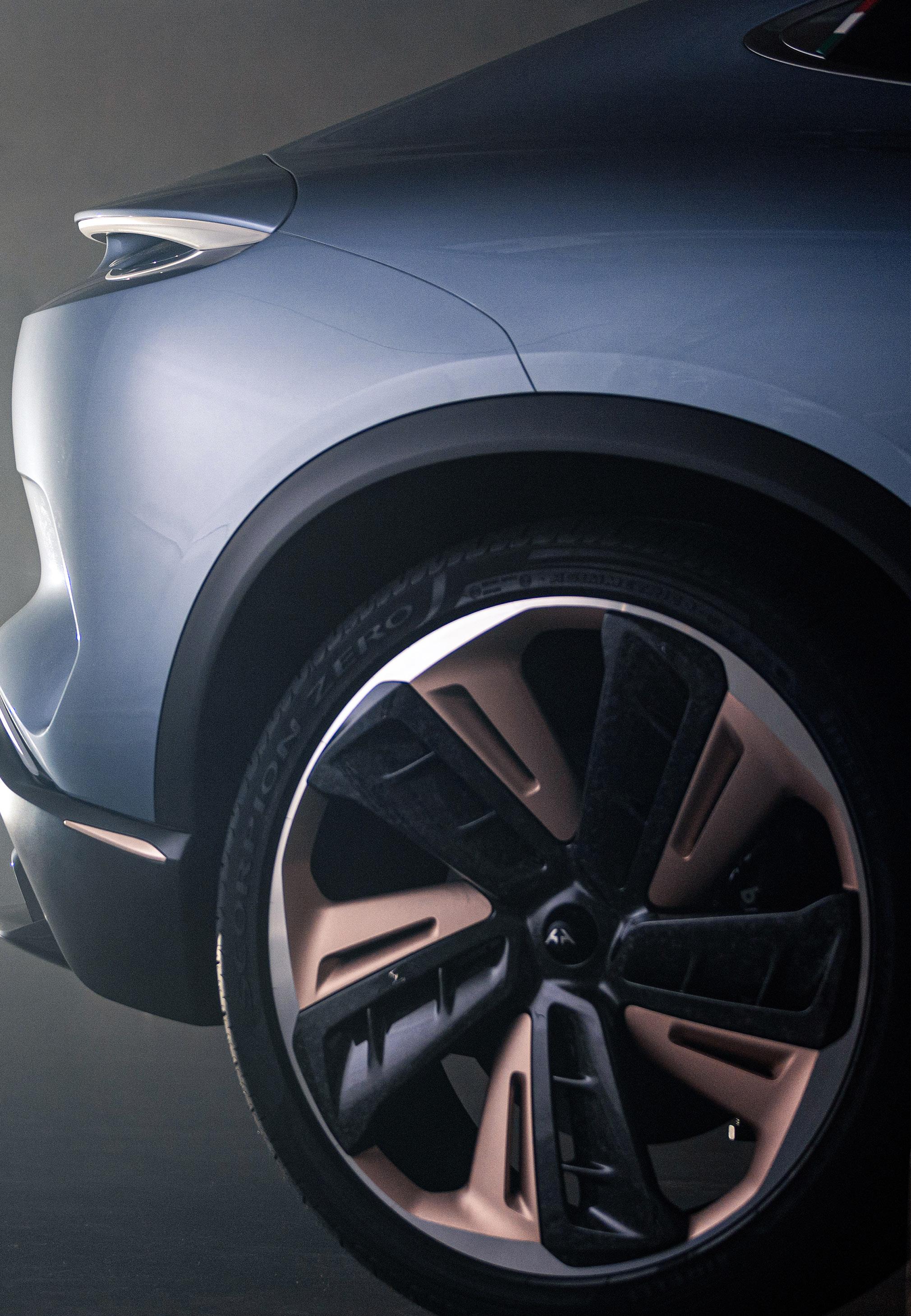

HAZIM NADA
At EV Magazine, we were blessed with witnessing a groundbreaking new vehicle design, which represents a new perspective for the automotive industry.
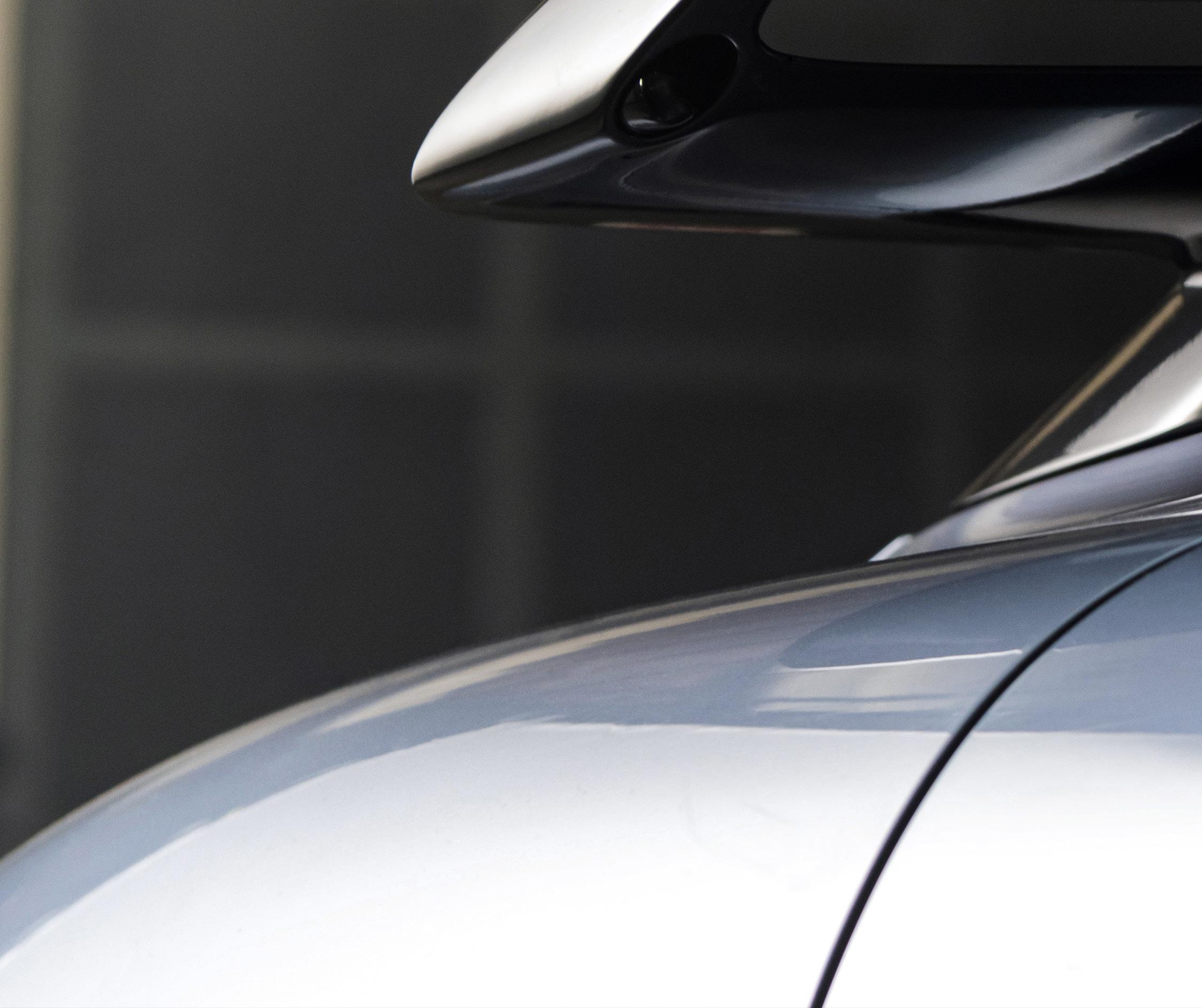
After the unveiling of the AEHRA SUV—and speaking to the company’s Founder and CEO Hazim Nada—we learned that there was more to the story than just innovation. The team underwent a project with the aim of not only making a product that’s sustainable by design, but that also defies all conventions of traditional car manufacturing to get to the finished automobile.
Directly from the company’s home city of Milan, we gained insight into the foundations of the business, which will compete with automotive firms to occupy the ultrapremium EV sector.
DESIGNING A PRODUCTION-STAGE EV THAT DEFIES CONVENTION
Why is sustainability so important to you as an individual?
“Well, electrification has proven that what
we had until today is obsolete. When you're able to churn out far more power than the internal combustion engine has for over a century with systems that are nearly three times more efficient, it already tells you that this is the future. There are issues to address that are still open, and they’re being addressed bit by bit, but the future is already set in that sense.
I come from the crude markets, having been engaged in the crude trade for many, many years. During the last phase of my career in the crude market, I was directly seeing the result of the transition.
In fact, some of the trades that I existed in, I would not have done so because the flows of crude were already established from place to place. The historical destinations of crude were no longer working because demand was shifting.
The more I got involved in the crude business, the more I was really sinking into it. It's an activity that takes over your entire life. In the 10-to-15 years that I was actively engaged in crude, I hardly ever had
INTERVIEW:
EXCLUSIVE
16 [Jan 2023] EVMAGAZINE.COM
Hazim Nada, Founder and CEO of AEHRA, explains the process leading to the design of a world-first electric vehicle (EV) that defies automotive norms
A RACE TRACK

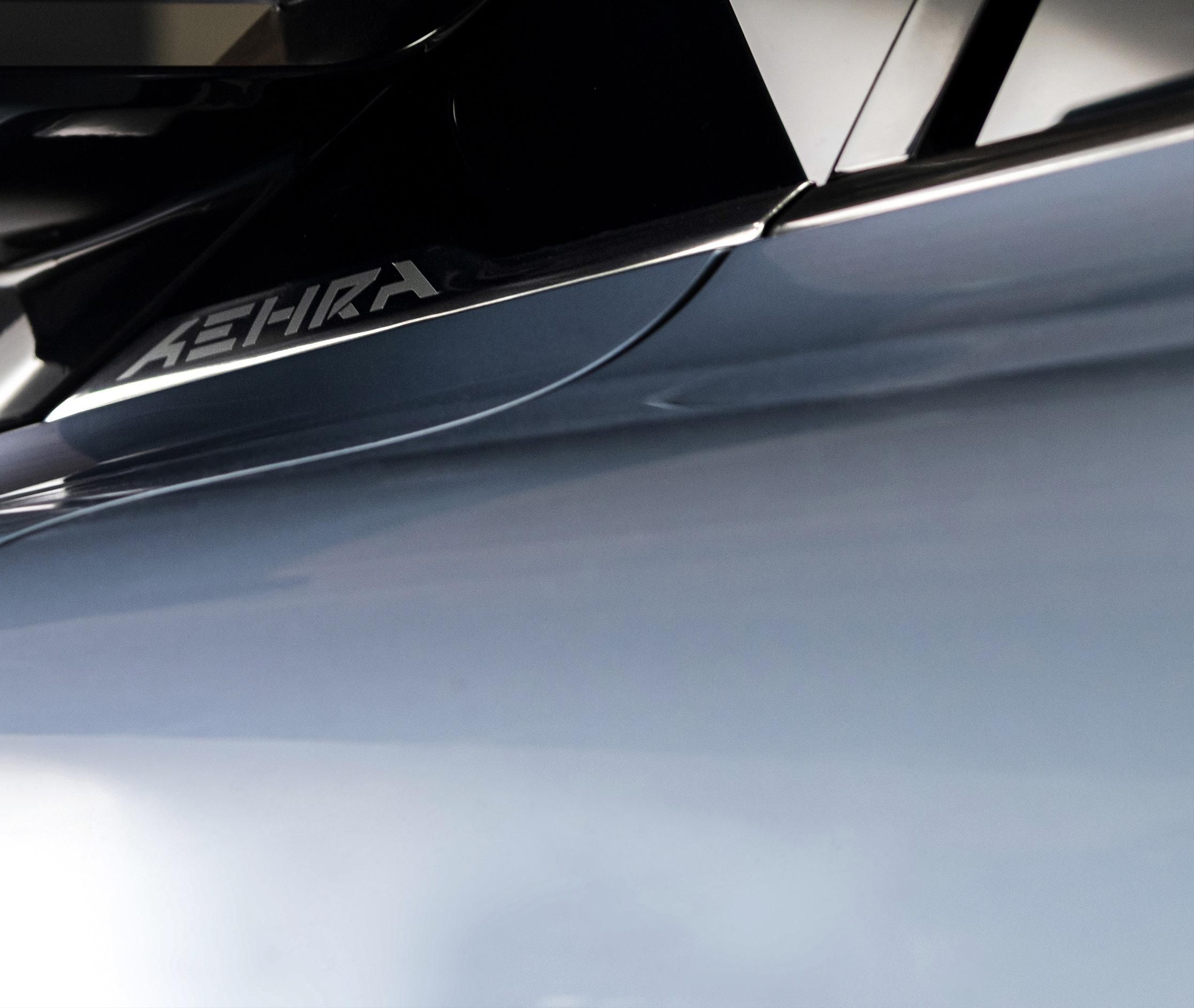
INTERVIEW
"WE MET AT
WITH OUR CHILDREN AND THE FIRST THING HE TOLD ME WAS, YOU'RE CRAZY"
a moment where I could really say I disconnected from the activity.

It's a profitable business, and you can make a very good living out of it, but it closes your vision entirely. You're stuck in that crude system. It became a bit of a prison. In the beginning, you're happy because you're making profits; you're engaged in a constant flow of commodities, you're supplying countries across the globe. You feel like you're doing something that's worth it.
But, as you go through that first phase and you become accustomed to the profits and lifestyle, you start to feel the other elements that you're missing. Moving away from oil and into electricity freed me from something that I know has to give way to something of greater impact. This is really what fascinated me about the shift.”
"ALL THE STAFF ESPOUSE THE SAME IDEA"
How did you get the designers (Filippo Perini and Alessandro Serra) of the AEHRA SUV on board?

“It took quite some time to convince the designers. We met at a race track with our children and the first thing he told me was, ‘You're crazy. What are you trying to do here?’
I kept hammering, hammering, hammering. At one point, he said, ‘Okay, I think there is a reason to do this, but we cannot have a short nose. We need to have a long nose. And the reason for this is we need to go to the Alto Classica—the event for traditional, classic cars.
And he took me to watch the Diabolic F-type Jaguar, a very old Jaguar. He's like, ‘Look how beautiful it is!’. But I had to say, ‘Sorry, I really don't like it’.
Shifting his classic mindset to really espouse the main idea was the nicest part. It was challenging, but when it happened, when he married that concept and he started expressing it, that was very satisfying.”
What is it about AEHRA's culture that allows the company to succeed in challenging the norm?
“We have titles, but everybody is focused on bringing the main idea to product. So we see that all the staff espouse the same idea, which is the key determining factor, because once you translate belief into passion, the process carries itself.
I think that's the key differentiator that we have. For me, the key milestone was when I saw Filippo espouse this idea, because I saw the way it translated into the wider development of the car.”
INTERVIEW
EVMAGAZINE.COM [Jan 2023] 19

AUTOMOTIVE GIANTS LIKE AUDI, MERCEDES, AND VOLKSWAGEN HAVE BEEN USING HEMP FOR VARIOUS COMPONENTS IN THEIR CARS. APTERA IS ALSO GOING DOWN THIS ROUTE TO MANUFACTURE ULTRALIGHT COMPONENTS FOR ITS RECENTLY RELEASED GAMMA EV—ADDING TO ITS INCREDIBLY LOW DRAG COEFFICIENT, EXPECTED TO BE 0.13 DID YOU KNOW “I'M VERY EXCITED ABOUT GEN 3 BECAUSE IT IS REALLY THE PINNACLE OF WHAT YOU CAN ACHIEVE IN TERMS OF A SUSTAINABLE RACING CAR” JULIA PALLÉ, SUSTAINABILITY DIRECTOR, FORMULA E 20 [Jan 2023] EVMAGAZINE.COM
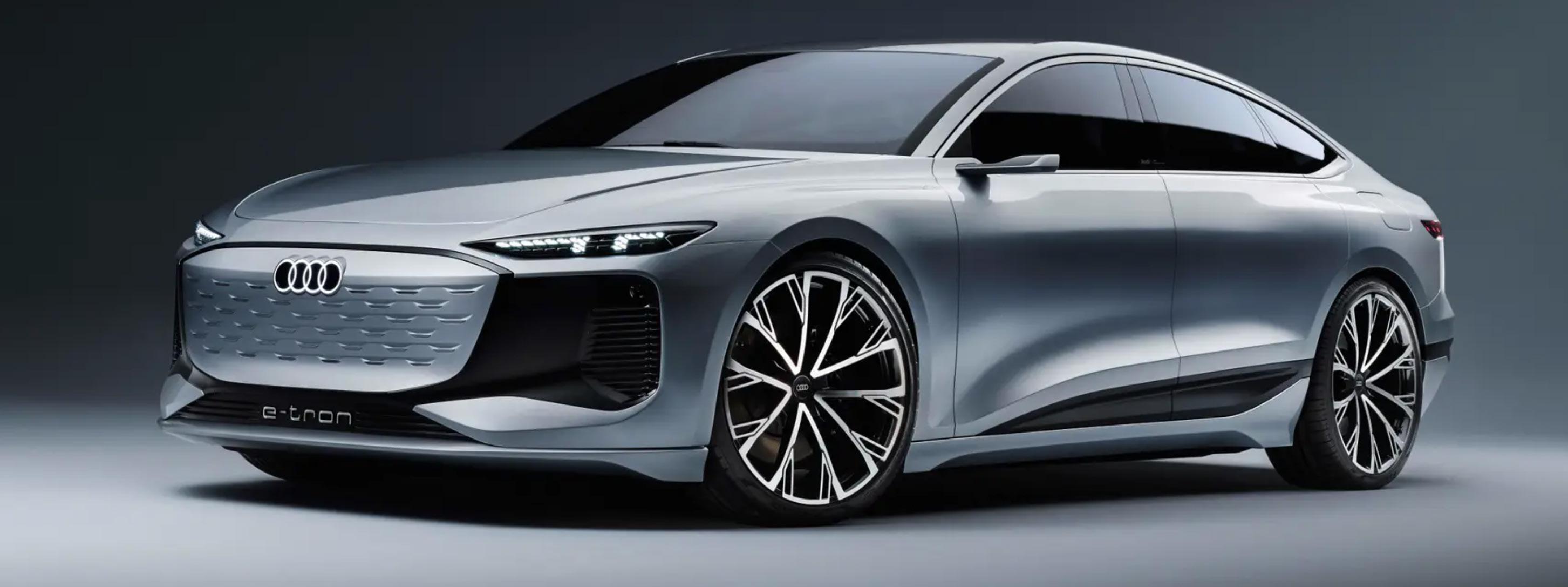


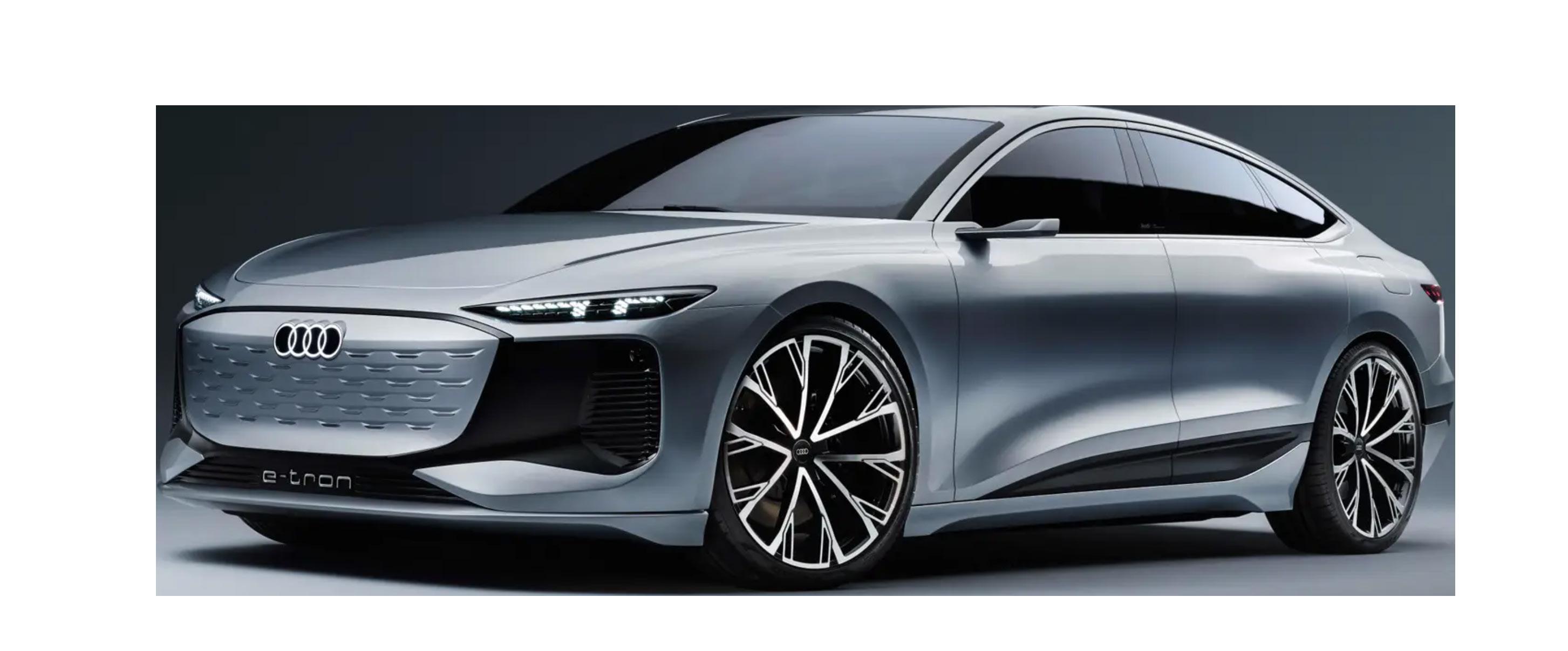
BENEFIT OF ELECTRIFYING MOBILITY SERVICES IS THAT IT WILL PAVE THE WAY FOR THE USE OF CLEAN RENEWABLE ENERGY IN THE FUTURE” LAKRUWANI HERATH-CULLEY, EXTERNAL COMMUNICATIONS AND GOVERNMENT AFFAIRS LEAD, SIEMENS DIGEST EVs TO LOOK OUT FOR IN 1 AUDI A6 E-TRON 2 BMW I5 3 KIA EV9 4 POLESTAR 4 2023
“THE
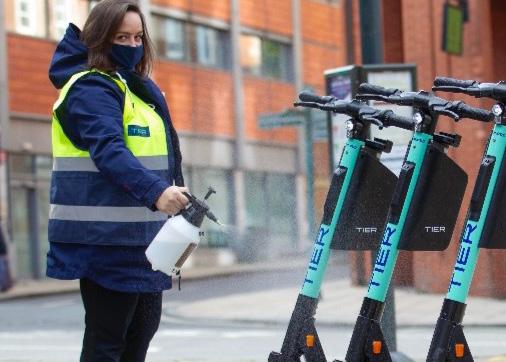

HOW MUCH DO YOU CHARGE? One of the main selling points of EVs was the running cost. As fuel prices skyrocket—due to a few major disruptions to the industry—EVs are the most cost-effective options for drivers. “THE KEY INDUSTRY TRENDS AT THE MOMENT ARE ABOUT CREATING A SERVICE THAT IS ABLE TO SUPPORT OPERATIONS IN THE LONG-TERM” JESS HALL, HEAD OF CITIES UKI, TIER MOBILITY FIAT VOLKSWAGEN CHEVROLET TESLA MODEL Y HYUNDAI TESLA MODEL 3 0.0388 US$ 0.0368 US$ 0.0364 US$ 0.0352 US$ 0.0332 US$ 0.0308 US$ US$ PER MILE
UNDERSTANDING EVs: DRAG COEFFICIENT
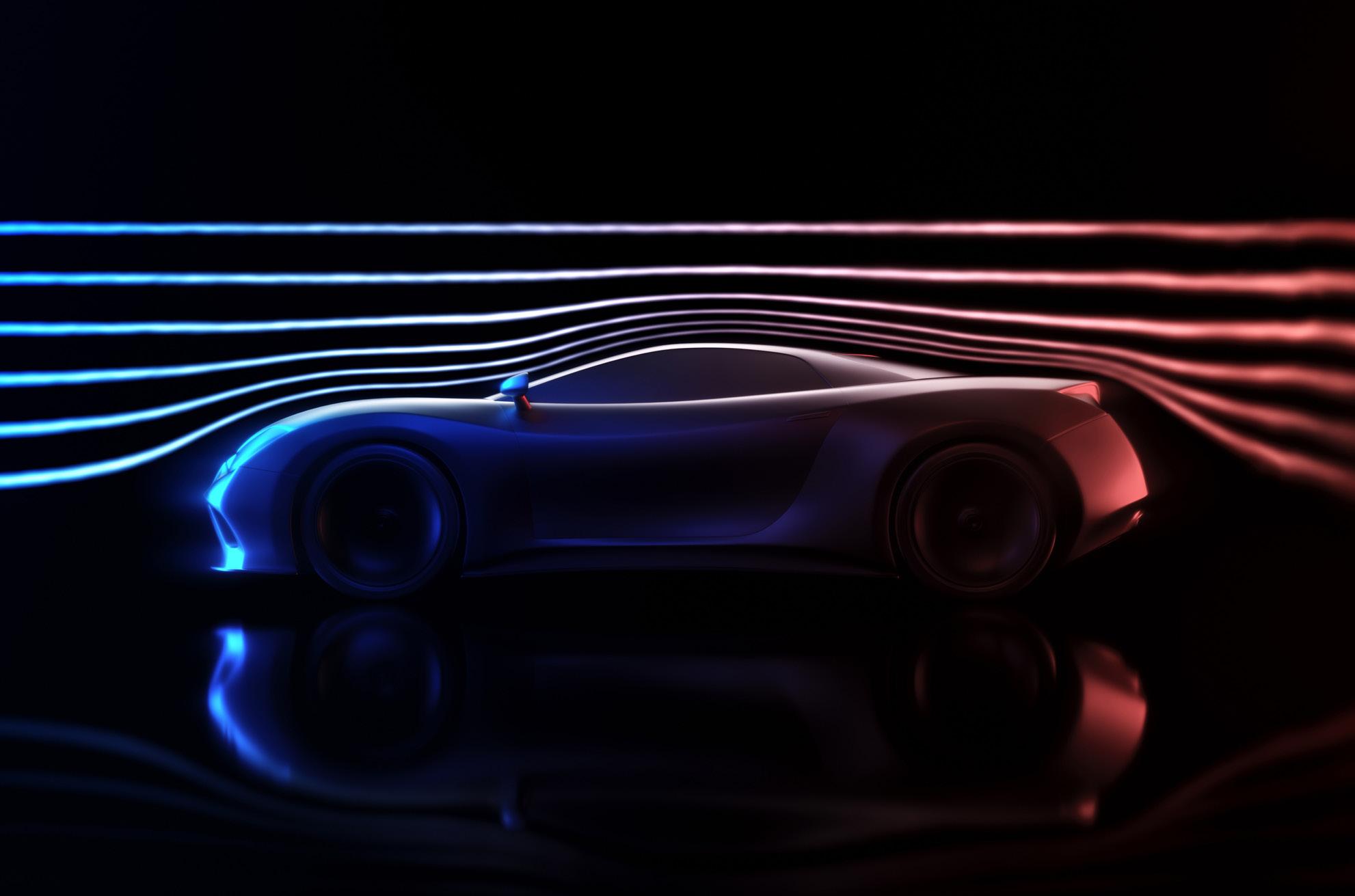
When looking into some of the most efficient cars on the planet, there is something they have in common: a low drag coefficient.
Not only does this mean they’ve been strategically designed and tested to the hilt, but the cars are as close as possible to the lowest level of resistance a car can have while on the road.
Though this was previously achieved by cars that were low slung, with spoilers forcing air in the optimal directions, many of the latest cars are getting much better at this.
The Tesla Model S is recorded at 0.208, which, to put it into perspective, is higher than the optimal shape that achieves 0.045. Nevertheless, the car and its sister Model X (recorded at 0.25) have very efficient shapes.
And these are just some of the EVs that top the chart. The RS e-tron GT records 0.24, Lucid Air Sapphire achieves 0.197, and the Lightyear 0 is set to reach 0.175.
DIGEST
EVMAGAZINE.COM [Jan 2023] 23
FORMULA THROUGH

OVERTAKING
24 [Jan 2023] EVMAGAZINE.COM
ELECTRIFICATION
FORMULA E:
 BY TOM SWALLOW
BY TOM SWALLOW
ELECTRIFICATION OVERTAKING CLIMATE CHANGE
EVMAGAZINE.COM [Jan 2023] 25 COVER STORY
Every year, motorsport continues to evolve, which is a challenge, but also an opportunity, for many reasons.
But there is one that stands out as one of the pioneering forces of climate change action among racing teams, social impact through interaction with communities across the globe, and innovation that allows the electric vehicle (EV) to grow exponentially in such a short period.
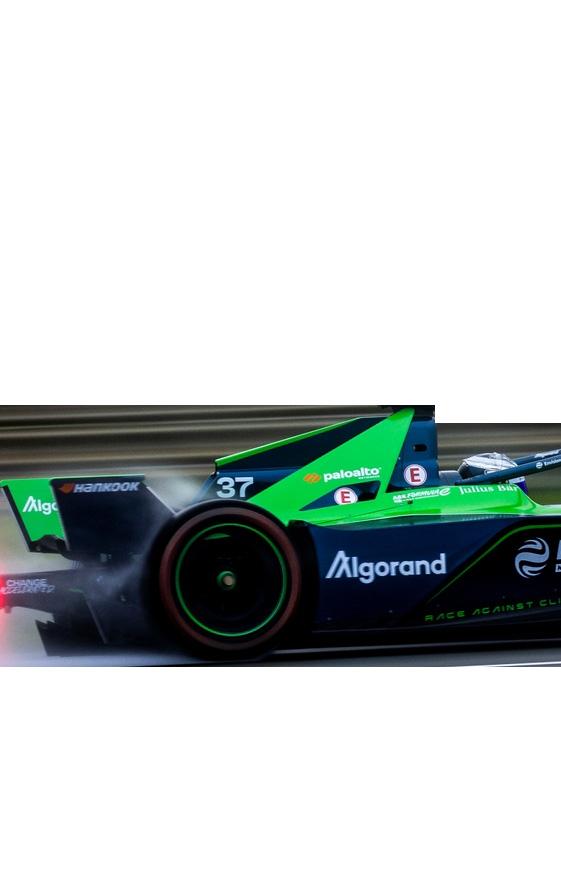
That motorsport is Formula E and it showcases the sheer excitement around electrification and the performance that can be achieved through collaboration on such a critical cause. Many partners join the FIA Formula E World Championship for different purposes under the same umbrella; to achieve the same overall outcome.
During season 8 of the globally-renowned, electrified motorsport, I was able to get behind the scenes at the London E-Prix—a double header that made it clear just how versatile EVs really are.
IT STARTS WITH EV—THE CHOSEN CHARIOT OF FORMULA E
With so many businesses and advocates coming together, the Formula E car is definitely the star of the show. Slowly but surely, the organisation has created a vehicle

ENVISION RACING
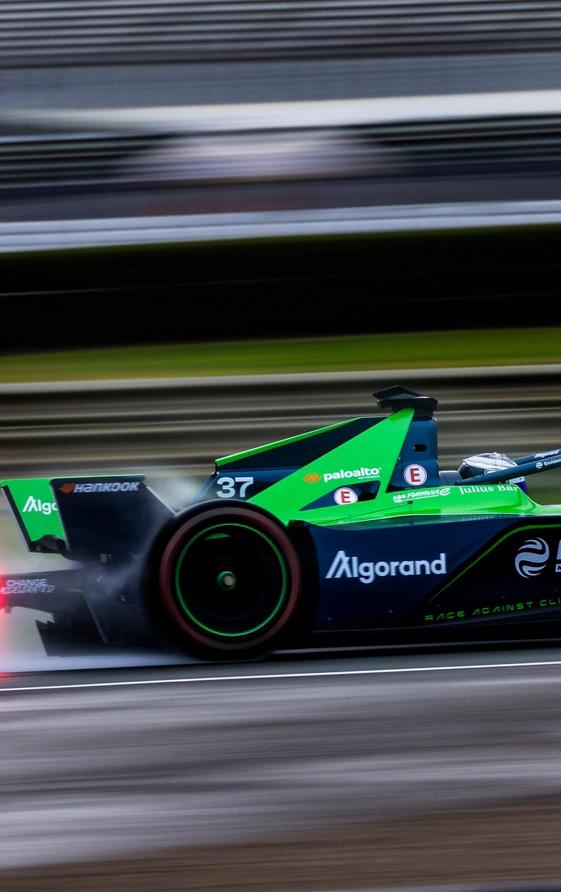
A new year and similar challenges. Formula E continues to develop climate advocacy and encourage social impact in its next season of EV motorsport
26 [Jan 2023] EVMAGAZINE.COM
that leverages the best of electric propulsion and other industry technologies and components.
The previous generation Formula E car has seen much of the world and was used as a tool to entice organisations and fans to join the movement. But, the 9th season begins mid-January and is bringing a muchanticipated EV into the spotlight.

Generation 3 of the Formula E car is characterised as being faster, lighter, smaller, and more nimble than any of its predecessors, but the EV is a tool to showcase how the teams’ engineers work together to get the most out of a more sustainable, in fact, incredible machine.

“The reality is that electric vehicles are already in the mass market solution and on our streets. From the regulatory perspective, all governments, the United Nations, and all

“THE REALITY IS THAT ELECTRIC VEHICLES ARE ALREADY IN THE MASS MARKET SOLUTION AND ON OUR STREETS”
DS PENSKE WATCH EVMAGAZINE.COM [Jan 2023] 27 COVER STORY
JU LIA PALLÉ, SUSTAINABILITY DIRECTOR, FORMULA E
SEASON 9: RACE CAL ENDER 2023 14 JAN 25 FEB 06 MAY 15 JUL MEXICO CITY CAPE TOWN MONACO JAKARTA JAKARTA PORTLAND ROME ROME DIRIYAH DIRIYAH HYDERABAD SAO PAULO BERLIN BERLIN LONDON LONDON ROUND 1 ROUND 5 ROUND 9 ROUND 13 ROUND 2 ROUND 6 ROUND 10 ROUND 14 ROUND 3 ROUND 7 ROUND 11 ROUND 15 ROUND 4 ROUND 8 ROUND 12 ROUND 16 27 JAN 25 MAR 03 JUN 16 JUL 28 JAN 22 APR 04 JUN 29 JUL 11 FEB 23 APR 24 JUN 30 JUL
car manufacturers are switching to electric vehicle production as the one and only solution,” says Julia Pallé, Sustainability Director at Formula E.
“I'm very excited about Gen 3 because it is really the pinnacle of what you can achieve in terms of a sustainable racing car. This is really the maximum you can get in terms of technology performance and sustainability in electric racing.”
A NEW ERA FOR FORMUL A E RACING


The drivers have been questioned about the car since its unveiling at the Season 8 Monaco E-Prix and, since then, the car has undergone rigorous testing to get to its current specifications.
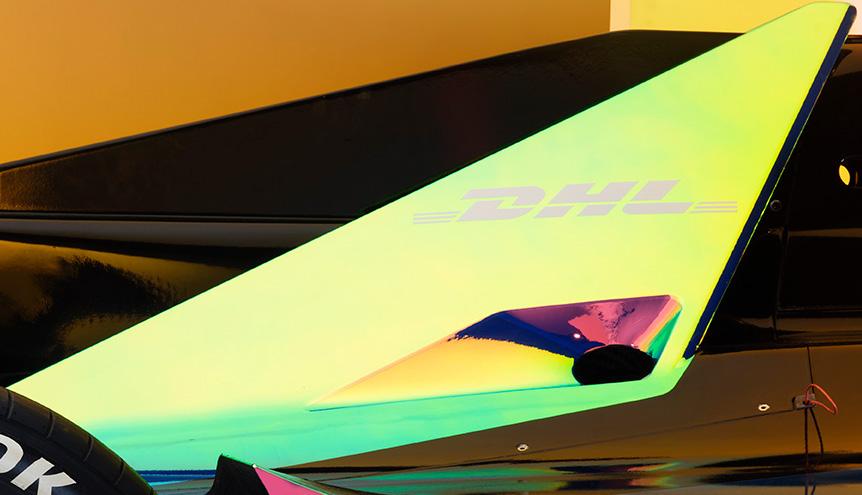
Nevertheless, the teams will be working with this electrified powerhouse to determine the best possible setup of the vehicle for their drivers and the conditions they will be racing in.
As the Gen 3 car has a split all-wheel drive power system, it achieves a total regenerative power of 600kW, comprising a 250kW motor at the front wheels and a 350kW at the back. More than 40% of the car’s power will be produced by regenerative braking and Formula E is also introducing charging into the mix.
The championship's new tyre partner Hankook will provide the rubber for the occasion, sporting 26% sustainably-sourced materials.
GEN 3
Season 9 (22-23) International 470hp (expected) +200mph 350kWh 9 WATCH EVMAGAZINE.COM [Jan 2023] 29 COVER STORY
PARTNERSHIPS ENABLE THE RACE TO ELECTRIFICATION
While Formula E has come to our attention in recent years, many fans have been following the electric motorsport since it began. It is almost a decade old and during that time, brought together many partner organisations to adapt and overcome electrification challenges to learn lessons that can be applied to the wider industrial transformation.
From the tyres to the charging points, Formula E prides itself on removing barriers through innovation and collaboration with some of the leading organisations in the automotive and technology industries.

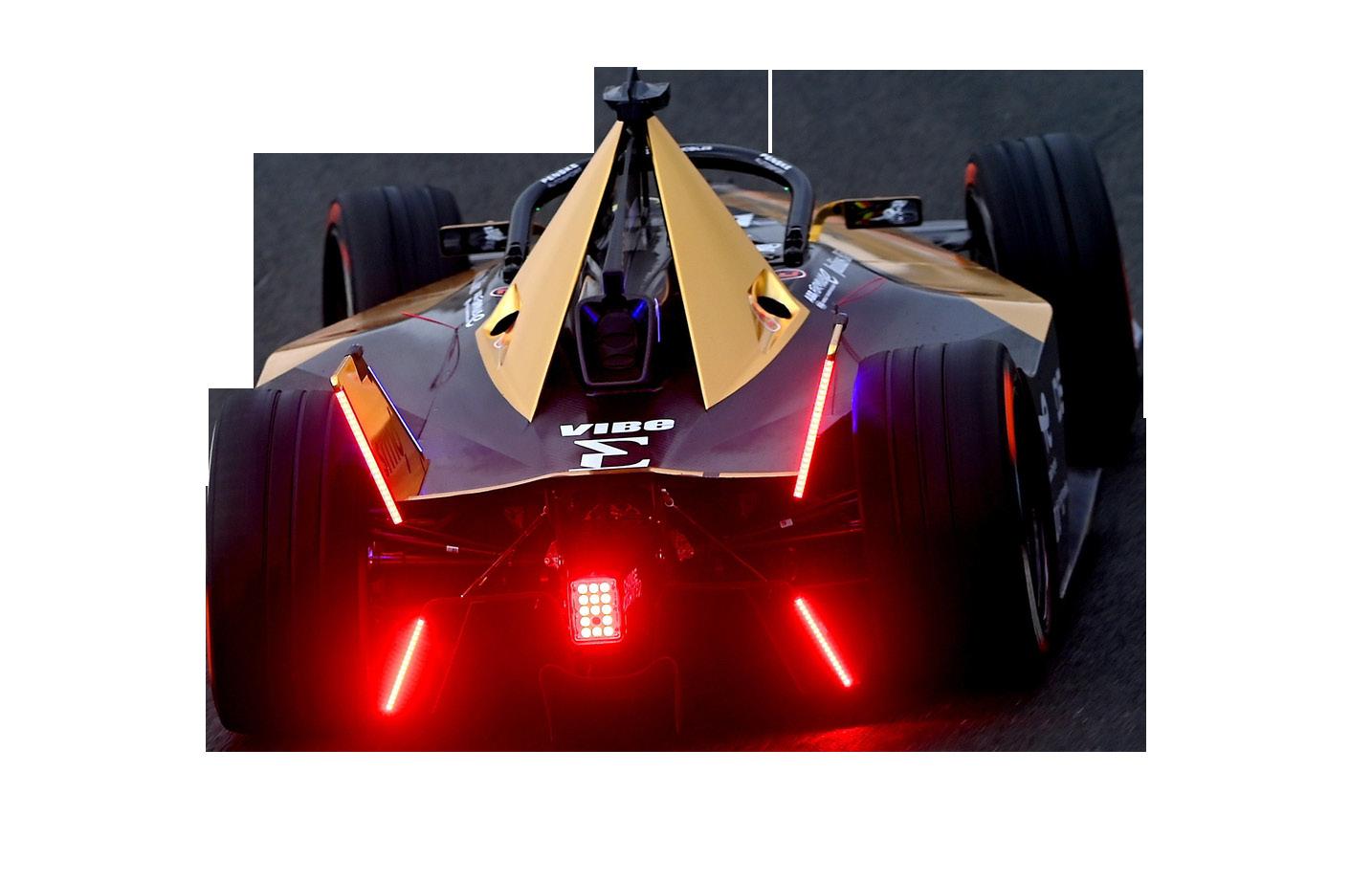
The official partner ABB is an influential force in electric mobility. Not only does it bring its technical expertise to the pits, but it
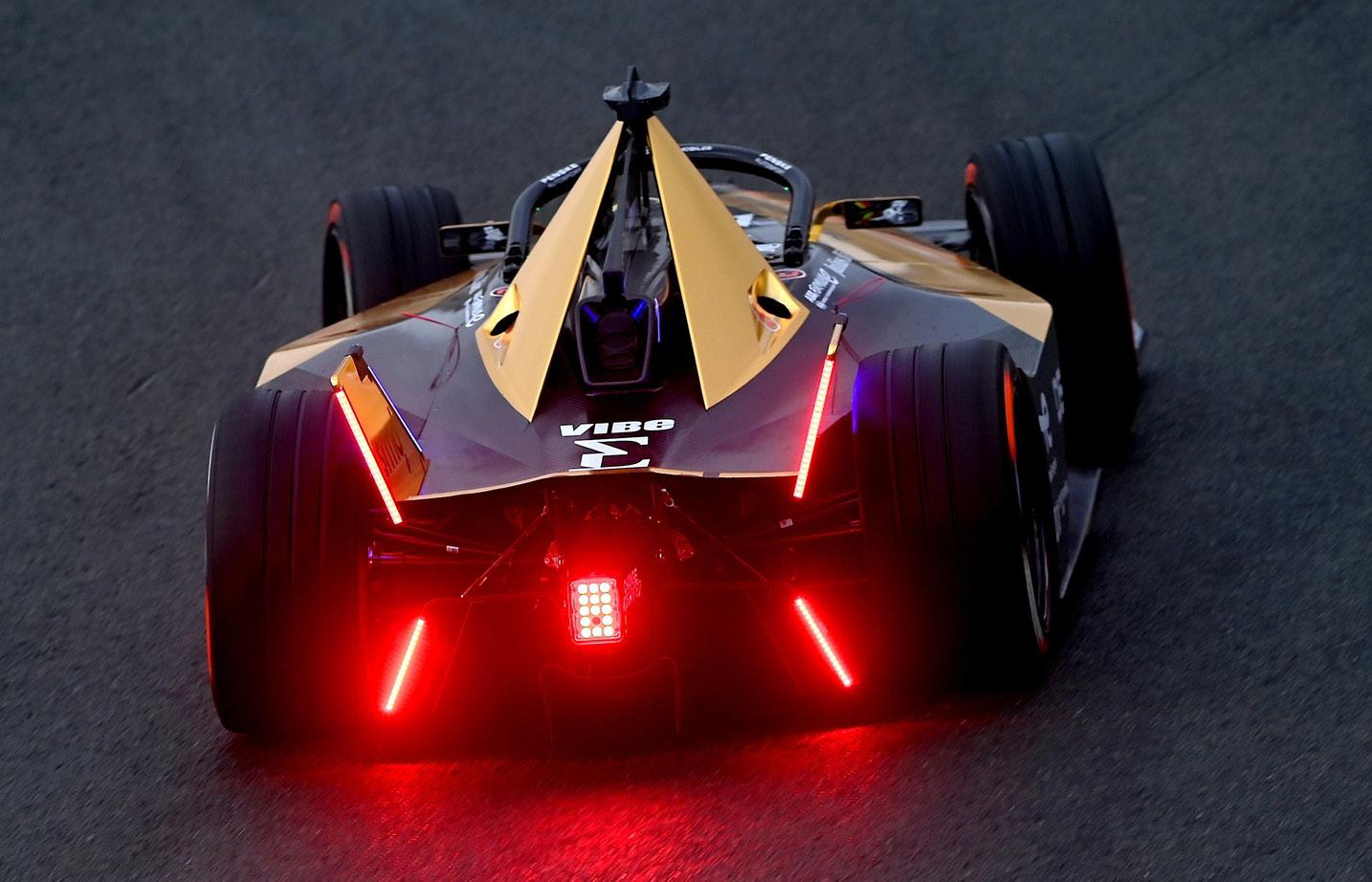
GENERATING A LOT OF DATA, LIKE MOST RACE CARS, BUT FORMULA E BEING USING AN ELECTRIC CAR IN THE FIRST PLACE, MEANS WE ARE GENERATING HUGE AMOUNTS OF DATA ALREADY”
“WE'RE
DIRECTOR, FORMULA E
JU LIA PALLÉ, SUSTAINABILITY
takes away lessons in charging and mobility infrastructure that can be applied at home, on business premises, and across cities to decarbonise transport.
Further to ABB’s contribution to motorsport, the teams and their sponsors are heavily involved, allowing them to show how they leverage data in a bid to be the fastest on the track and the most effective in decarbonising their operations.
“The technology around electric vehicles, mostly in the formula cars, is about software, which is extremely important because the EVs that we purchase and drive are very much based on the software,” says Pallé.
“This is really the heart of technology. What is interesting is that the technology developed in the garage from the software perspective
is also transferred into the everyday car that you and I are driving recently.

In fact, seeing the teams working behind the scenes to prepare for the race tells us just how important data is in achieving success across all facets of each event and how it can be applied to wider industry.
ABB: A PRIMARY PARTNER AND CRITICAL ENABLER OF SUSTAINA BLE RACING

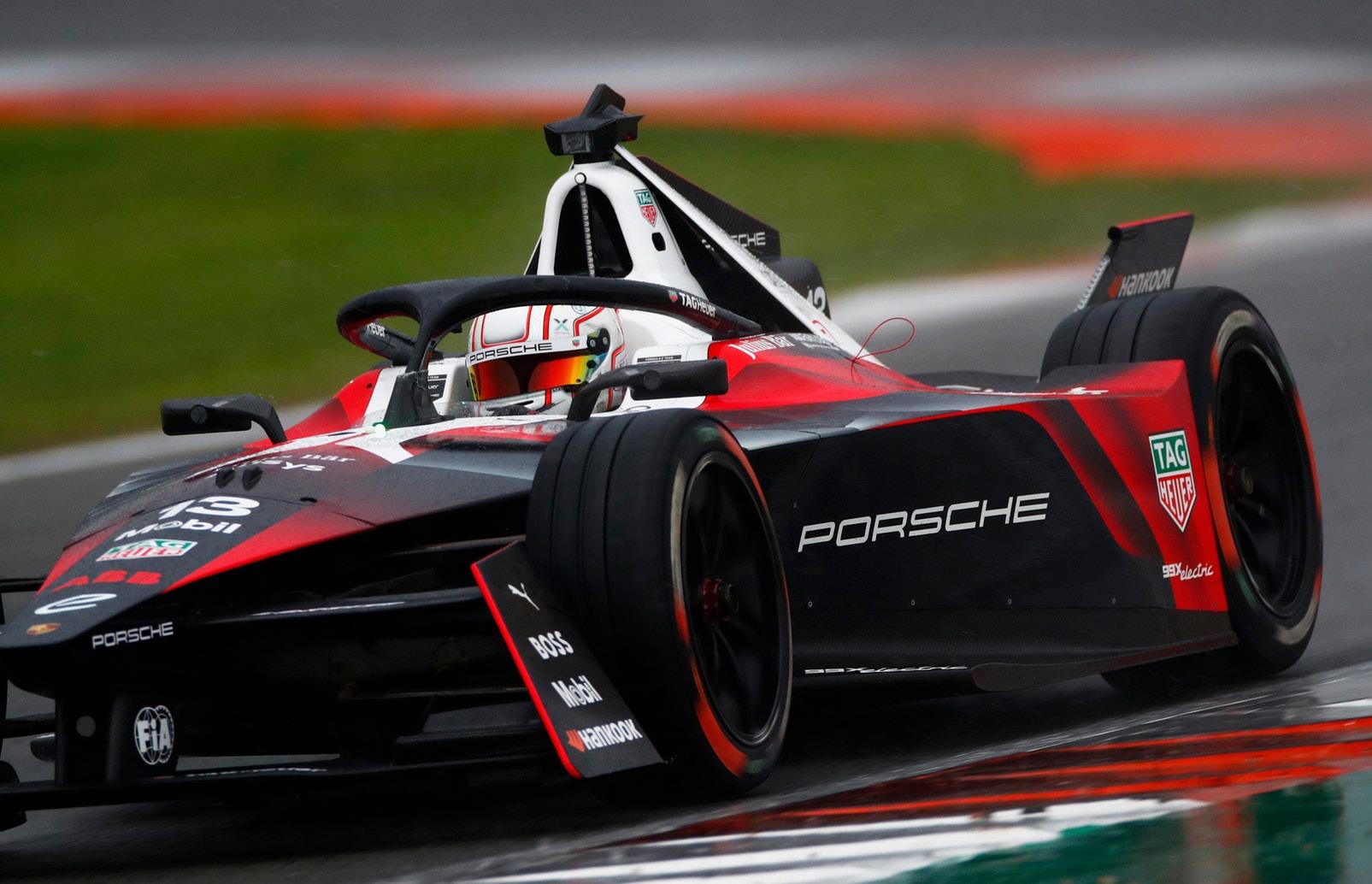
The key comments of Formula E are batteries and charging. Without these, even the most aesthetically pleasing, aerodynamically sound EVs wouldn’t make it out of the pits.
This is the same for electric cars in the real-
 TAG HEUER PORSCHE
TAG HEUER PORSCHE
EVMAGAZINE.COM [Jan 2023] 31 COVER STORY
WATCH
SEASON 9 CHARGING...
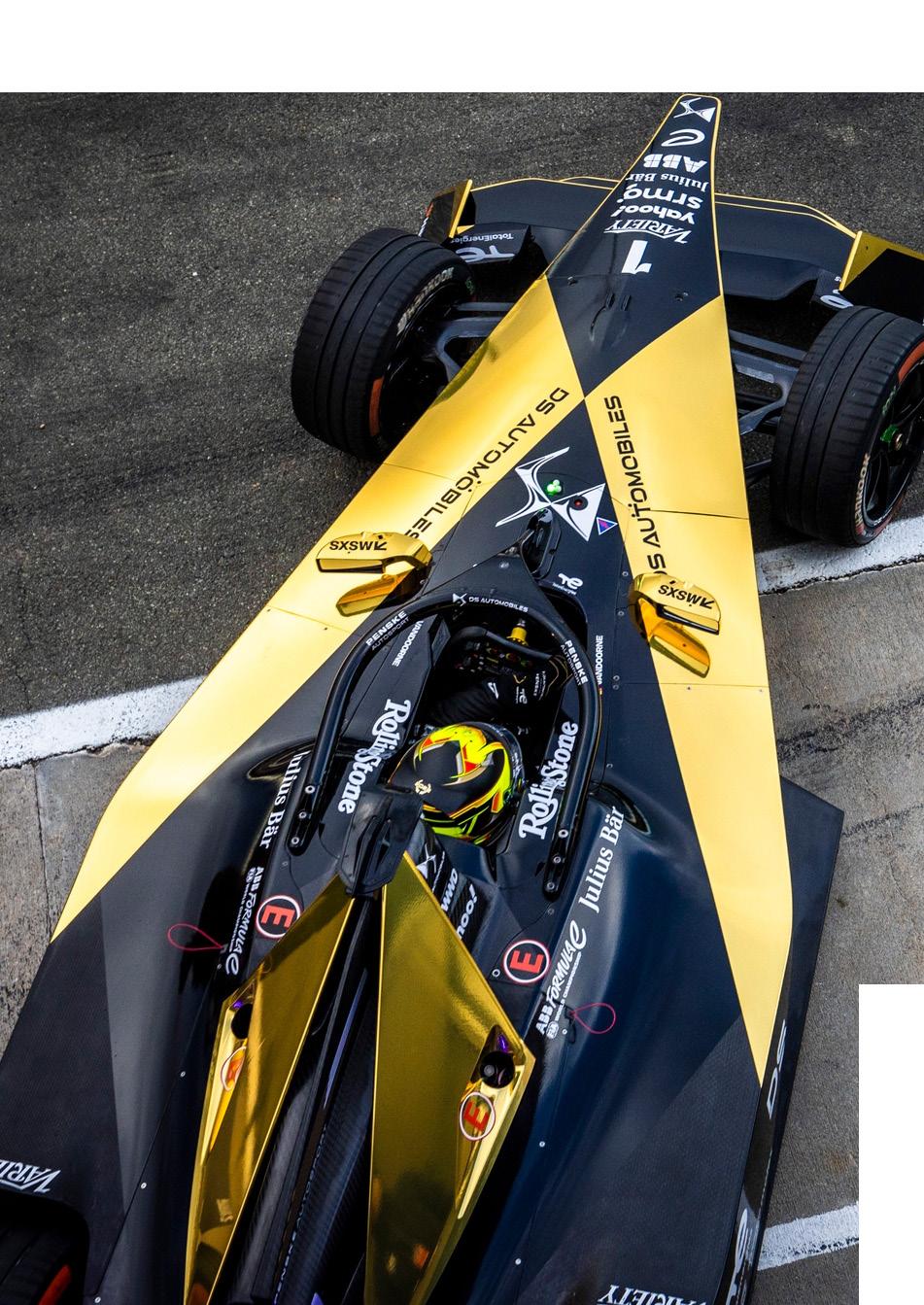

ENVIS ION RACING
Delving behind the scenes at Envision Racing, we learnt more about the Formula E racing team—backed by a Chinese multinational energy corporation—and its use of sophisticated technology to leverage racing data trackside, and in the workshop.
The company continues to expand its use of data to enable further progress in managing its performance on the racetrack, as well as backend support to allow the team to work faster and more efficiently.
We carried out an exclusive interview with the man leveraging this partnership:
• Sylvain Filippi, Managing Director and CTO of Envision Racing
After much anticipation, EV Magazine was able to get behind the scenes at the Envision Racing Team workshop at the Silverstone Racetrack, UK, to learn more about how Genpact supports the team’s data strategy, giving the team its own competitive edge in the sustainable racing championship.
After visiting Envision Racing at its workshop at the Silverstone Race Track, UK, Silvain Filippi, Managing Director and CTO of Envision Racing, expressed the importance and challenges that EVs present from a data perspective.
“We're generating a lot of data, like most race cars, but formula E being using an electric car in the first place, means we are generating huge amounts of data already,” says Filippi.
“And then the format of the racing means we have very little time between the free practice sessions, qualifying, and the race, which means we have a lot of data and very little time to look at it so clearly.”
EV’S PLACE IN A SUSTAINABLE LEGACY
There are a few underlying issues that Formula E hopes to resolve through its influential position and a widespread group of engineers and leaders from its partner companies. Since the dawn of the race, the FIA has been an advocate for climate and social justice, which drives its sustainability legacy agenda.
If electrification wasn’t enough on its own, Formula E is responsible for various projects around the world to create lasting impacts in its host cities. From smart city applications to social impact projects, the FIA is committed to leaving venues behind in a much more ecofriendly position, and more socially responsible.
“Smart cities are going to use electric vehicles powered by renewable energy in a connected network, but also by integrating AI technology,” says Pallé.
“It's a global and holistic solution that we're looking at, which is why Formula E races in cities—because mobility and transport accounts for a third of global emissions and mostly impacts cities.”
Season 8 closed in Seoul, Korea in 2022, and the next will begin in Mexico City on the 14th January 2023. The next year of racing will see more sustainable innovation taking place, the introduction of new partners, including Hankook tyres, and further lasting effects from the global racing championship.
EVMAGAZINE.COM [Jan 2023] 33 COVER STORY
WILL HACKERS GAIN ACCESS TO

DRIVERS’ DATA VIA EVs? 34 [Jan 2023] EVMAGAZINE.COM

CONNECTED CAR
You wouldn’t just hand someone unrestricted access to your mobile phone, would you? Nor would you be willing to hand over your keys to a stranger who plans on taking them from you.
The electric vehicle (EV) threat landscape is now mimicking that of any other technology device, thanks to their inclusion in the digital ecosystem. While this is not necessarily a problem that is unique to EVs, it seems that more electric cars are implementing technology solutions and allowing drivers to connect with more than just their phones, opening up the attack vector landscape.
Nevertheless, with the dawn of smart EV charging, hackers are on the lookout for easy ways to steal as more drivers entrust their cars to pay for electricity—a feature unique to EVs.
The use of fintech apps has provided consumers with unforeseen levels of convenience and, as EVs enter into the digital ecosystem, they too hold the power to leverage these apps. Like any other devices these days, hackers are able to connect with cars from a distance and don’t have to race to catch their target in a Fast-
and-Furious-like fashion (there are also no predator drones involved in the making of a suitable car-hacking environment).
EVS CAN BE TARGETED FOR FINANCIAL INFORMATION
Although it would seem that EVs are just as good a target as mobile phones or laptops, they are unlikely to pique the interest of those after a quick cash job.
“Hackers looking for a quick cash pay-out don’t tend to target vehicles, unless they plan to steal the car itself, as it doesn’t normally give them access to personal financial data,” says Andy Barratt, UK Managing Director of Cyber Security Consultancy, Coalfire.
One of the key words within this comment from Barratt is ‘data’. Now gold dust for most organisations, data is critical for hackers in getting what they want, whether that’s a much larger pay-out or tormenting an individual for monetary bail.
“However, wider integration of fintech applications into EVs could present cybercriminals with the cash-grab opportunities they’re on the hunt for”, which would explain the importance of financial security in the development of EV solutions.
36 [Jan 2023] EVMAGAZINE.COM CONNECTED CAR
Cybersecurity is one of the most sought after solutions as the digital landscape increases the cyber-attack surface – and electric cars are no exception









REGISTER FREE NOW DISCOVER THE FUTURE OF EV 2ND FEB 2023 | 6:55-8:20PM GMT LIVE VIRTUAL EVENT STREAMED FROM LONDON TRANSPORT MUSEUM RODI BASSO CEO E1 SERIES SARA SLOMAN CHIEF STRATEGY OFFICER PAYTHRU HAZIM NADA FOUNDER & CEO AEHRA SAM CLARKE CHIEF VEHICLE OFFICER GRIDSERVE ALEX GILBERT HEAD OF ENERGY & ELECTRIFICATION TRANSPORT FOR LONDON SPONSORED BY SPEAKERS INCLUDE:
COALFIRE PROVIDES CYBERSECURITY FOR THE WORLD’S INNOVATORS

The company supports the top five cloud service providers, eight of the top software-asa-service (Saas) providers, and three of the top financial, healthcare and retail organisations.
Coalfire is committed to cybersecurity for world-leading businesses and uses cuttingedge technologies to do so. Its core services span compliance, cloud security, application security, vulnerability management, as well as strategy, privacy, and risk.
Barratt says: “Authentication mustn’t interrupt the driver for safety reasons, and the temptation will be to simplify these processes, unwittingly making them easier to breach.”
SECURING FINANCIAL DATA WITHIN EVS
Now, this isn’t to scare anyone intending to connect payments to their vehicles, but to ensure that the correct methods are in place to secure data that is used for EV-related services.
On the company’s side, data should only be used where it is necessary while limiting the amount of data stored. Encryption of data, two-factor authentication, and antimalware protection tools can be leveraged to enhance the security of data.
“The main security concern for an EV will be preventing access to billing systems for battery charging,” says Barratt. Fintech apps offer huge potential to streamline these processes, improve in-car experience and pave the way for innovations like ‘buy now, pay later’ and loyalty schemes,” says Barratt.
“But carmakers need to recognise that, if poorly protected, these systems could offer hackers an access route to the driver’s finances.”
The extra challenge to overcome with EVs— alongside similar problems with fintech applications—is the ability to secure carfriendly interfaces, which, if simplified, could make them more prone to cyber disruption.
EVMAGAZINE.COM [Jan 2023] 39 CONNECTED CAR
Although these may seem like standard procedures when dealing with mobile phones and contactless payments, it’s important to emphasise the similarities between them, while also recognising that cars must follow suit if they want to utilise the benefits of digital.
Security is also a consideration for those using other means of transport, such as ridesharing and rentals. The industry is rapidly extending its use of fintech for various means: Uber, for example, collaborates with a fintech provider that offers consumers the opportunity to obtain an EV through the pay-to-rent model.
Fintech apps are also leveraging capabilities beyond their remit to provide customers with comprehensive services. An example of this is the ability to find a suitable charging station, pay for charging at the plug, and make use of other automotive services.
According to PwC’s report, ‘Cyber readiness: are auto companies prepared to counter the risk of an attack?’, every convenience comes at a cost. Automotive manufacturers must be more proactive in dealing with cyber risks before they inevitably arise, but many firms are currently only reactive to the changes in the EV landscape from an electrification standpoint.

40 [Jan 2023] EVMAGAZINE.COM CONNECTED CAR
Going forward, companies will seek out more vulnerabilities in their vehicle technology, as well as in their networks. As EVs become more connected than cars have ever been, they’ve effectively entered the digital-risk landscape, which is prone to activities affecting other technology providers.
Electrification is not just a necessary process, but one that will allow automakers to futureproof their solutions and make mobility safer, physically and digitally. The PwC report expects that cybersecurity must become part of the product design phase to ensure the best use in real-life applications.

“CARMAKERS NEED TO RECOGNISE THAT, IF POORLY PROTECTED, THESE SYSTEMS COULD OFFER HACKERS AN ACCESS ROUTE TO THE DRIVER’S FINANCES”
EVMAGAZINE.COM [Jan 2023] 41
AND Y BARRATT, UK MANAGING D IRECTOR OF CYBER SECURITY CO NSULTANCY, COALFIRE
WRITTEN BY: TOM SWALLOW
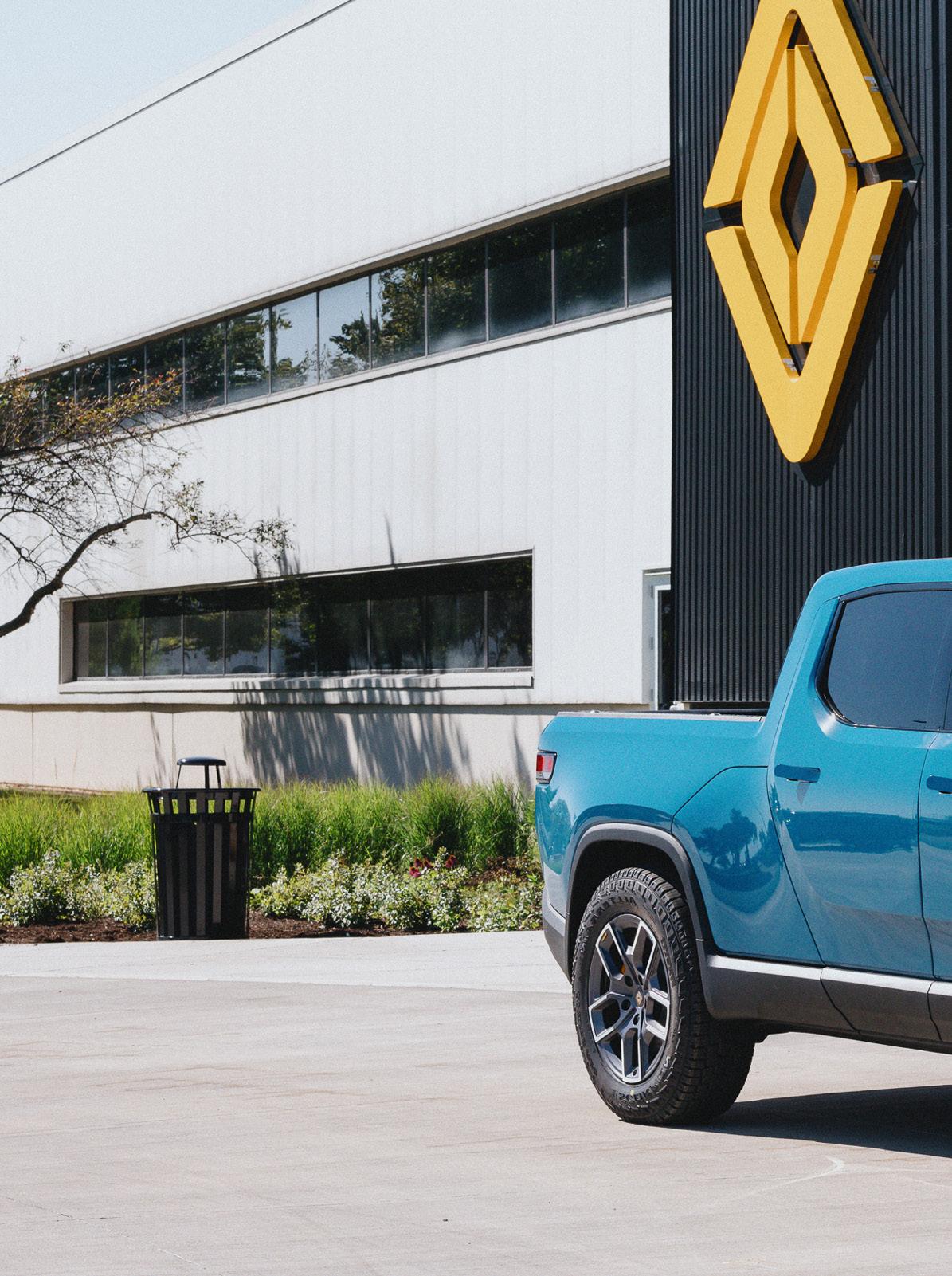 PRODUCED BY: MIKE SADR
PRODUCED BY: MIKE SADR

ELECTRIC VEHICLE ADVENTURE DRIVEN BY PROCUREMENT 42 [Jan 2023] EVMAGAZINE.COM
SUSTAINABLE
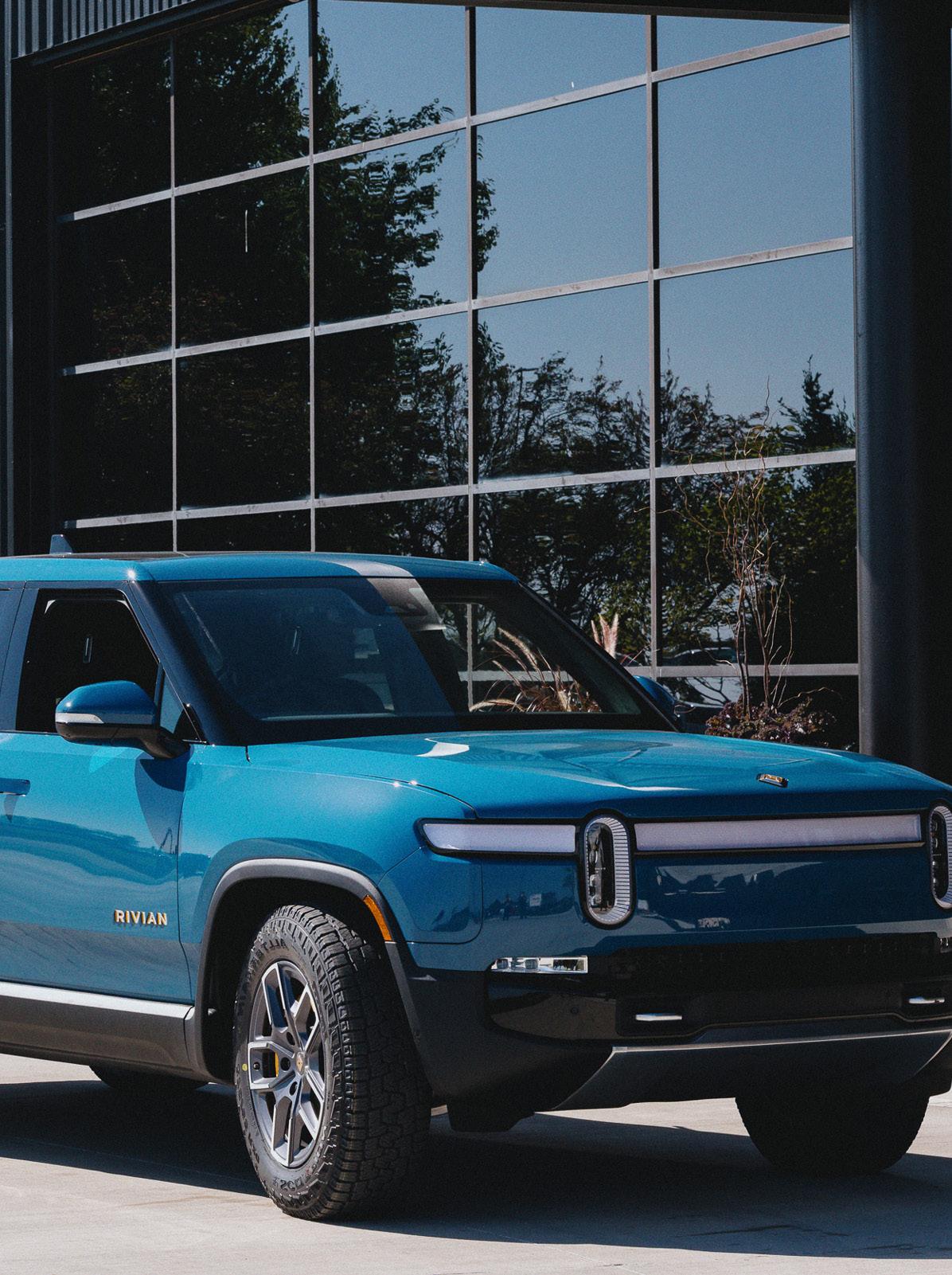
EVMAGAZINE.COM [Jan 2023] 43

Anyone harbouring a passion for adventure and sustainability will no doubt have heard of the company leading the market for electrified pickup trucks.
Not only does Rivian boast sustainability credentials across its entire business, it’s also a business built with the planet at the forefront of all its activities. Yet, while there are many exciting aspects to highlight, the critical element of Rivian’s story is the “design and development of categorydefining electric vehicles”, in the words of the company’s Director of Indirect Purchasing, Brad Hood.
We often see the company through the consumer lens. Thousands evangelise the clean, robust, unique style of the Rivian R1T and R1S—its pioneering EVs, the pinnacle of the environmentally and socially responsible business.
Founded in 2009, the Rivian story began with a vision for sustainable mobility. As an automotive enthusiast himself, the company’s founder, RJ Scaringe, saw that the two things he lived for—cars and nature— were not compatible in the long-term. This conclusion formed the very basis of the company, which holds an integral place in the electrification of automotive.

Brad Hood, Director of Indirect Purchasing at Rivian, on the benefits of a ‘blank canvas’ and how the EV manufacturer implements sustainable procurement
EVMAGAZINE.COM [Jan 2023] 45 RIVIAN AUTOMOTIVE
Procurement drives a sustainable electric vehicle adventure
BRAD HOOD DIRECTOR OF INDIRECT PURCHASING RIVIAN
“He created a product that was a more sustainable alternative to the fossil-fuelburning carried out by internal combustion engine vehicles. He really wanted to facilitate a transition to more neutral energy transportation, not only for our generation, but for our kids', kids’, kids,” says Hood.
“It's a multi-generational purpose that goes beyond any one of us, which is what drives the overall culture at Rivian: we're here for something bigger than ourselves.”
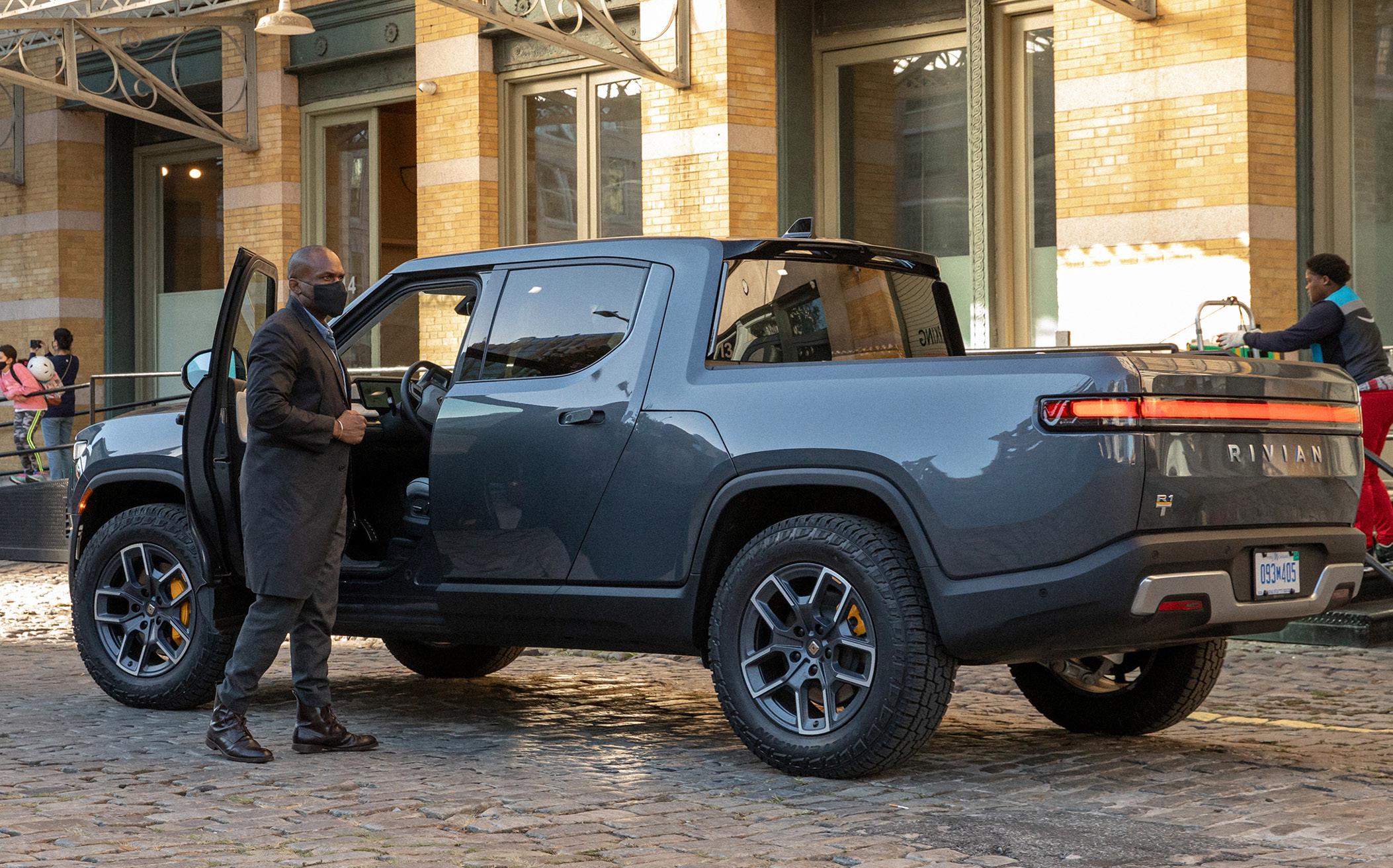
Of course, there’s more to Rivian vehicles than the fact they run on electric propulsion. The company prides itself on sustainable sourcing and leveraging a circular system, right from the design stage. Its batteries can be easily removed for either recycling or ‘second life’ applications. When it comes to the interiors, vegan leather and other animal-free materials are used, with mid-life repairability in mind.
Beyond the product itself, sourcing also involves the unique procurement of oceanharvested plastics for its dunnage containers and other packaging solutions. Such actions earned the company the 2022 Excellence and Reusable Packaging award from the Reusable Packaging Association.
WE ARE WORKING
AN E-SOURCING EVENT OR AN AUCTION, WE CAN LEVERAGE THESE TEMPLATES”
“IF
ON
46 [Jan 2023] EVMAGAZINE.COM RIVIAN AUTOMOTIVE
“We use the most sustainable products we can and when we went public, 1% of the company went to the Rivian Forever Fund,” says Hood.
“We think about how to operate responsibly within the plant. When we began the conversion of the old Mitsubishi plant to the new Rivian plant, we used some of the old steel to make tables, a mezzanine—and we even repurposed old robots as a door holder for the conference room.
“We reused things, and maybe went above and beyond. Instead of scrapping it, instead of getting rid of those materials, we thought, ‘how can we repurpose that and reuse them?’.”
INDIRECT PROCUREMENT PROVIDES THE OPERATIONAL FOUNDATIONS
As a new entrant to the automotive industry in 2009, Rivian was built with sustainability in mind. And being a new business gave the company a competitive edge to not only grow, but advance the use of new technologies and lean processes.
Hood explains that when he joined the organisation in 2018, the procurement function was significantly smaller than it is today, but this has allowed the company to take an approach that is driven by technology.
“When I joined, there were 500, 600 employees. There were about three people within our department,” Hood says. “Now, the total company size is more than 20 times that.”
“At the beginning, we had a shell of a manufacturing plant. Now, we're fully operational, building three different vehicles with multiple different variations in Normal, Illinois.”
BRAD HOOD
TITLE: DIRECTOR OF INDIRECT PURCHASING
INDUSTRY: MOTOR VEHICLE MANUFACTURING
LOCATION: DETROIT, USA
Brad shifted careers from manufacturing and production planning to procurement after graduating from Western Michigan University with a major in Integrated Supply Chain Management. After spending most of his procurement career in consulting, he joined Rivian at the tail-end of their stealth mode in 2018 to help build their procurement department. Rivian has experienced tremendous growth since then, which includes the indirect procurement team that Brad leads. This has proved both Rivian and Brad the opportunity to grow the procurement organisation in the same manner as Rivian talks about designing the vehicles, from a blank

EXECUTIVE BIO
10,000+ Number of employees 2009 Year founded RIVIAN AUTOMOTIVE
PROVIDING RETURNABLE PACKAGING SOLUTIONS
Essex Weld Solutions is a global company servicing customers across North America.
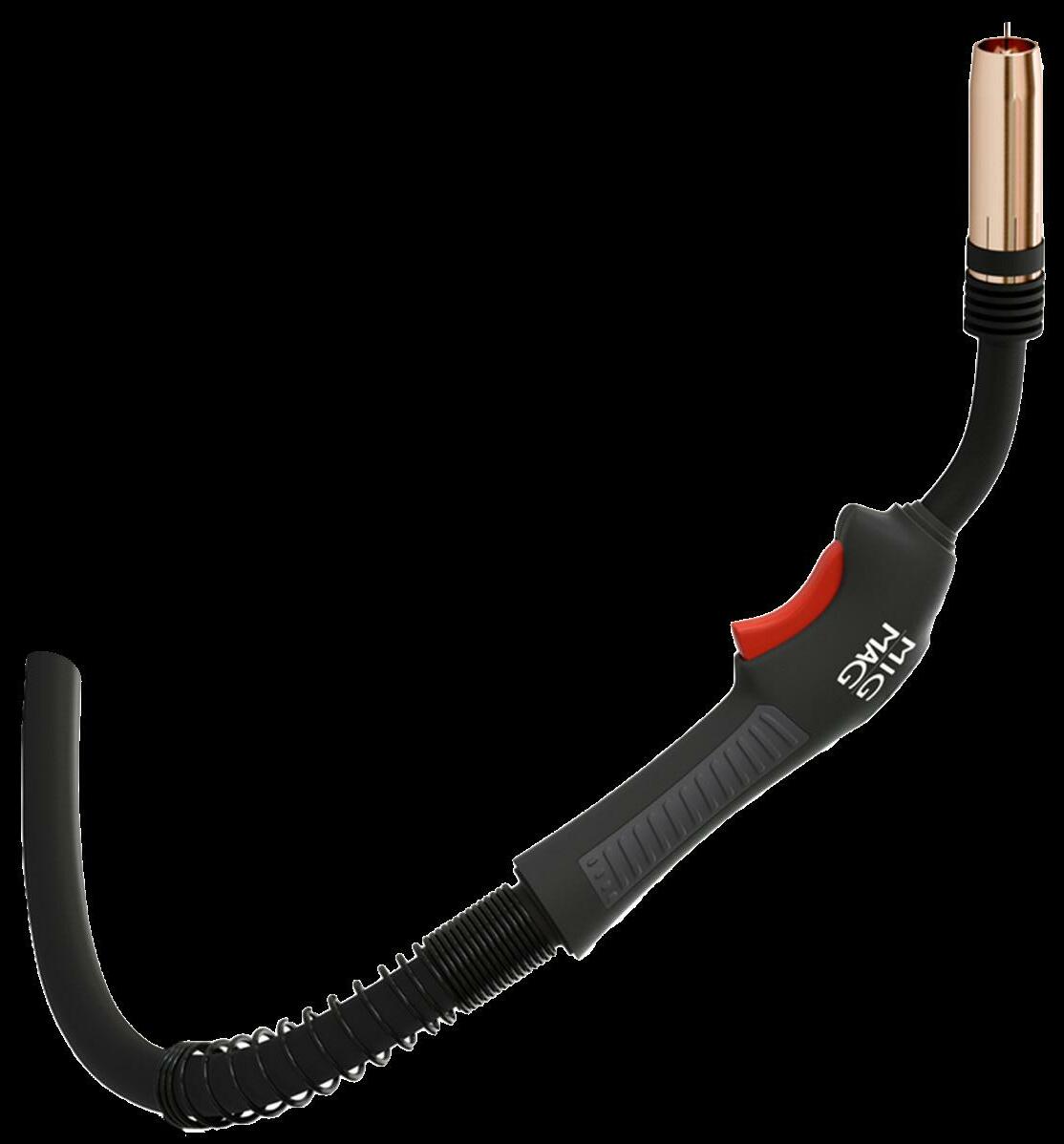

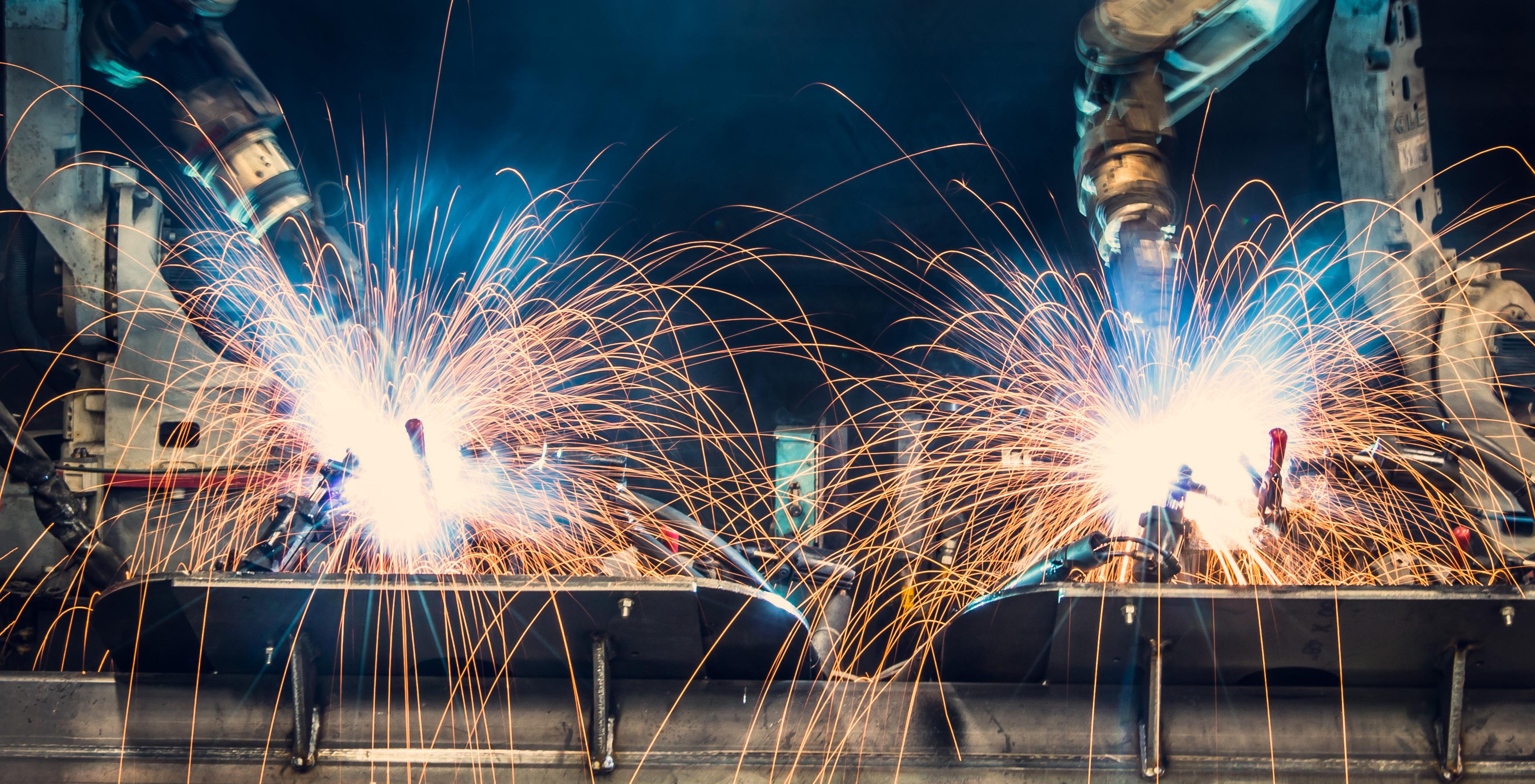
Our focus is the development and global supply of custom and standard automotive racking products. Essex Weld Solutions is a “Full Service Manufacturer” of custom automotive containers from bins to racks. We offer Designs, Prototypes, and high-volume production. This ensures superior quality control, something our customers expect and deserve.
LEARN MORE


FULL SERVICE CUSTOM RACK MANUFACTURER

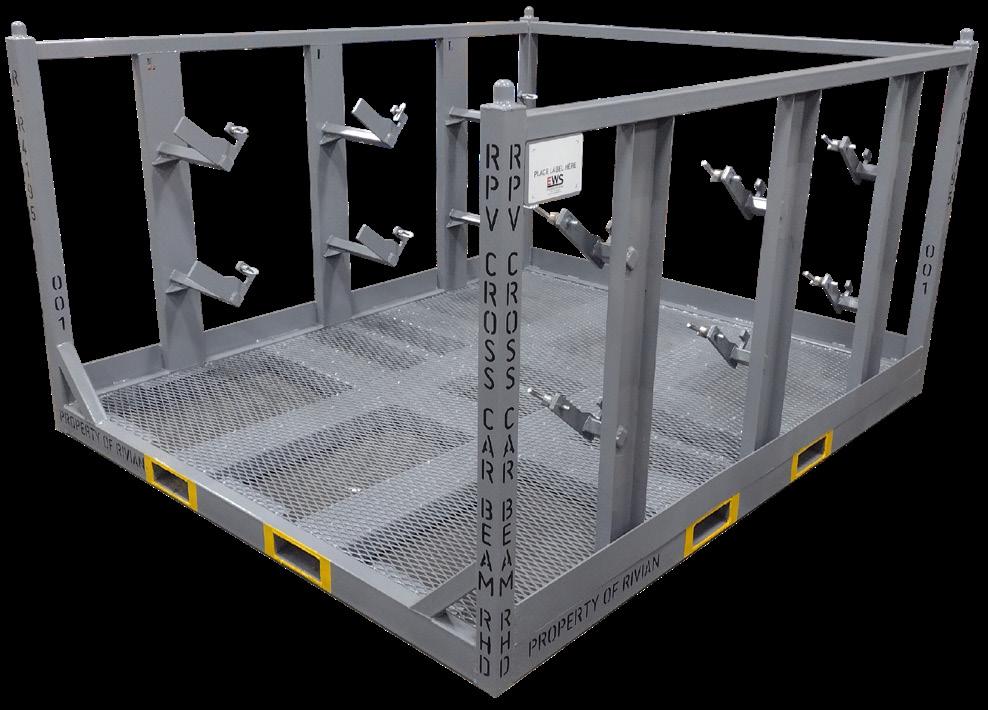
Essex Weld Solutions began with a handful of customers and a production plant in Essex, Ontario. From the start, people were our strength. We have selected a team with a focus on integrity and trust, which is the foundation that we have built our reputation on. Keeping our customers’ needs at the center of every decision is what has led us to strive for excellence in everything we do. These values have been instilled in all our team members ensuring we all work together towards these goals.

Twenty years later, we have expanded to multiple locations across three countries. Our Canadian plants include Leamington and Essex, Ontario. We also have American plants in Laurens, South Carolina and Warren, Michigan as well as one plant in Durango, Mexico. All locations boast on-site engineering and full production capabilities so that we can provide in-house concepting, designing, prototyping, and large-scale production allowing us to be a one stop shop for our customers’ projects.
Over one-hundred years of combined experience has taught us that investing in the latest manufacturing technology is necessary to provide top quality products. Our plate and tube lasers, break presses, robotic welders, and full powder coat system allow us to maintain high standards across all locations. Our manufacturing process is monitored from concept to delivery using

our own ERP system, Edata+, with real time inventory levels, production status, and barcode tracking labels. This enables us to maintain inventory of common materials at all locations and efficiently control quality and delivery timing.
Our innovative approach to the everevolving world of manufacturing means we never stop improving the service we provide our customers. As manufacturing shifts to a greater integration of robotic production lines, we have developed a Metrology team that exclusively handles the precise quality control required for those projects. These continuous improvement efforts allow us to expand our capabilities so that we can better serve our existing customers, and reach out to new ones, as their needs change, especially as the shift to Electric Vehicles continues.
THE STORY BEHIND SUSTAINABILITY
Rivian entered the automotive industry at an interesting period. The company was very much undergoing its formation when major carmakers first started thinking about EVs, which, at the time, were seen as a ‘nice-to-have’.
With a passion for automotive and a desire to protect nature in all its glory, Rivian’s CEO, RJ Scaringe, set about building his dream: a vehicle with no limits and an adventurous edge that would allow drivers to explore harmlessly, reinvigorating their love for the environment.
The company first piqued interest with its two EV models. The R1T, its pickup truck model, and the R1S, which leverages the same great technology in an SUV body. In 2022, the company reached a major milestone with the announcement of it supplying electric delivery vans to Amazon—the initial quantity being 10,000, with potential for the e-commerce giant to expand this to 100,000.
Rivian cultivating a business on what was seemingly a blank canvas meant that the company worked through many challenges in its indirect procurement function to ensure that it remained true to its roots.


The solutions adopted by the company were pivotal. They allowed the team to focus on more hands-on tasks, alleviating the need for human input in the day-to-day processes.
“We had the opportunity to build an organisation that is truly best-in-class, from the ground up. We don't have to change any old behaviours; we can create new ones, and in the right manner, too. Balancing the two of those meant knowing
50 [Jan 2023] EVMAGAZINE.COM RIVIAN AUTOMOTIVE
what we needed to do daily versus what was required to build a foundation for the future.
“This was the biggest challenge, balancing the short-term and long-term needs. There are so many day-to-day requirements, but we must be able to balance the day-to-day work, while building the foundation of the organisation we desire to build.”
Another major challenge that wreaked havoc on all supply chains—and inevitably affected Rivian—was the COVID-19 pandemic, which meant navigating a remote-working environment while scaling and taking on new team members across the globe.
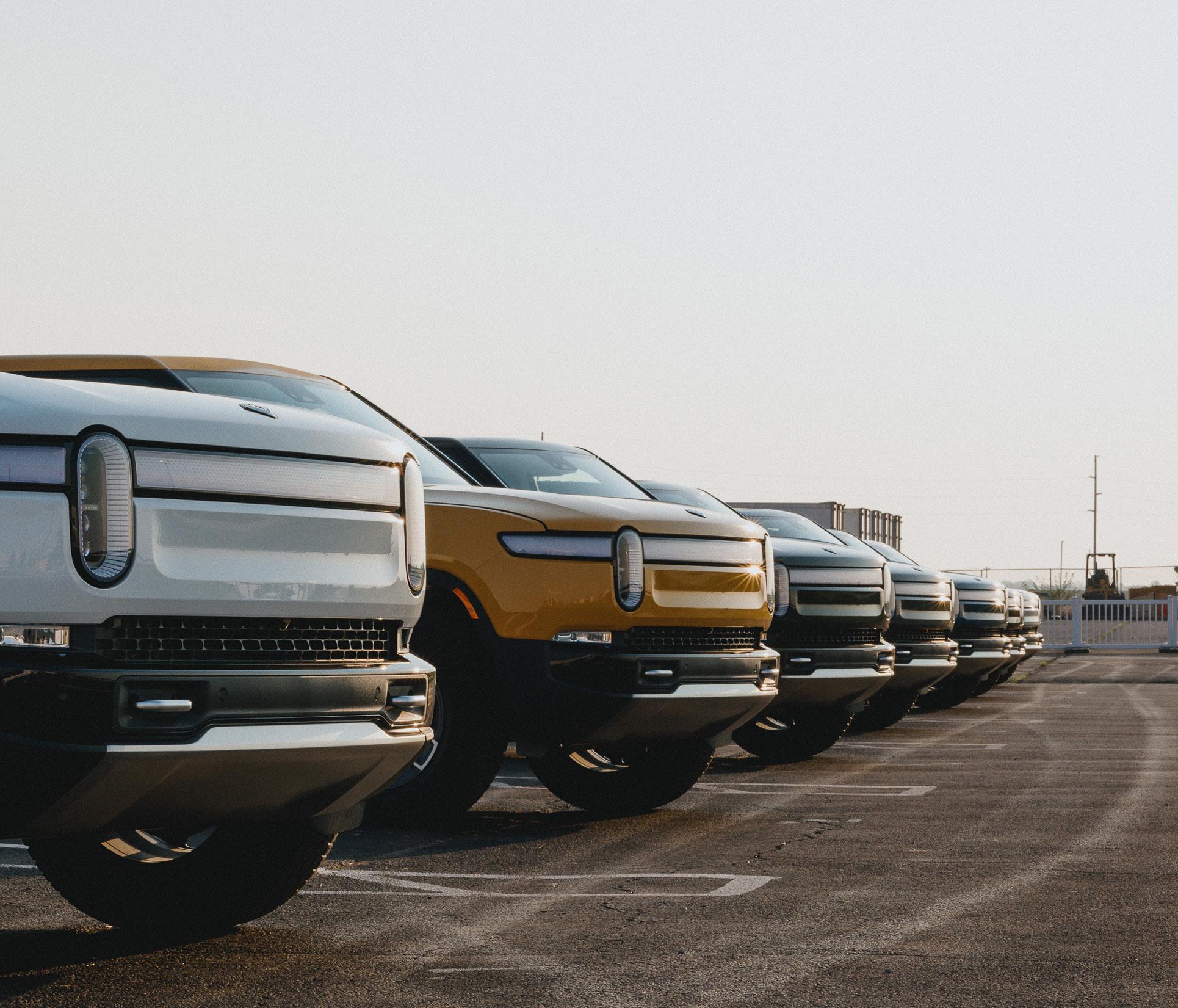
FULLY OPERATIONAL, BUILDING THREE DIFFERENT VEHICLES WITH MULTIPLE DIFFERENT VARIATIONS DOWN IN NORMAL, ILLINOIS” BRAD HOOD DIRECTOR OF INDIRECT PURCHASING RIVIAN EVMAGAZINE.COM [Jan 2023] 51
“WE'RE

Intelligent tech needs ingenious humans
With data, automation, and AI, we help organizations transform and build value across the board. Explore how people and companies are reimagining supply chain networks at accenture.com
Let there be change
These trying times meant the company had to adapt to onboarding and training the team online, without knowing when new starters would come into contact with their colleagues.

As a result of these challenges, the company adopted ‘category cards’ to create ease in the purchasing process. This is just one of the ways in which the company streamlines the onboarding process, automating indirect procurement processes to allow a smaller team to manage more purchases.

54 [Jan 2023] EVMAGAZINE.COM RIVIAN AUTOMOTIVE
A MULTI-GENERATIONAL PURPOSE THAT GOES
CULTURE AT RIVIAN”

we can leverage these templates. “Automatically, a quantitative proposal comes in and we can analyse that based on our previous price paid, other proposals, market intelligence,” says Hood.
“When you log in, you see the category, you select that category, and it gives you a brief description to tell you if you can buy it from a catalogue—so we can drive more spend to a catalogue—or it gives you a direction to reach out to a purchasing manager or supplier,” Hood explains.
“That way, we can touch more spend with a smaller team, increasing the addressability of the spend and continuing to educate the rest of the organisation to drive spend to our preferred buying channels.”
Further sourcing platforms used by the company provide further standardisation of indirect procurement processes. This includes supplier negotiation preparation, which can largely be templated—as Hood explains.
“If we are working on an e-sourcing event or an auction,
“We can look at that pretty quickly and find any outliers, identify where the best quantitative values are and work with our stakeholders as we incorporate the qualitative aspects. These tools really allow us to work faster.”
While businesses would often apply the term ‘digital transformation’ to their operations, it seems Rivian is beyond this, ensuring that technology is embedded into all processes from the earliest possible stage as part of its strategic approach to growth.

“IT'S
BEYOND ANY ONE OF US, WHICH IS WHAT DRIVES THE OVERALL
A Tour of the Rivian Plant | Go behind the scenes with founder RJ Scaringe
EVMAGAZINE.COM [Jan 2023] 55 RIVIAN AUTOMOTIVE
BRAD HOOD DIRECTOR OF INDIRECT PURCHASING RIVIAN

“It can standardise things and reduce errors but, for us, it allows us to actually promote and enrich the daily operations of those working in data-entry roles. They've now gone into more category management roles and supporting student sourcing, as well as those roles where we can marry technology and experience,” Hood explains.
LEVERAGING PARTNERSHIPS TO INTEGRATE MORE TECHNOLOGY
As the company looks to ramp up the production of EVs, technology will become an integral component in allowing the organisation to scale its operations and meet demand.
The company will continue to add value to its services sustainably, with
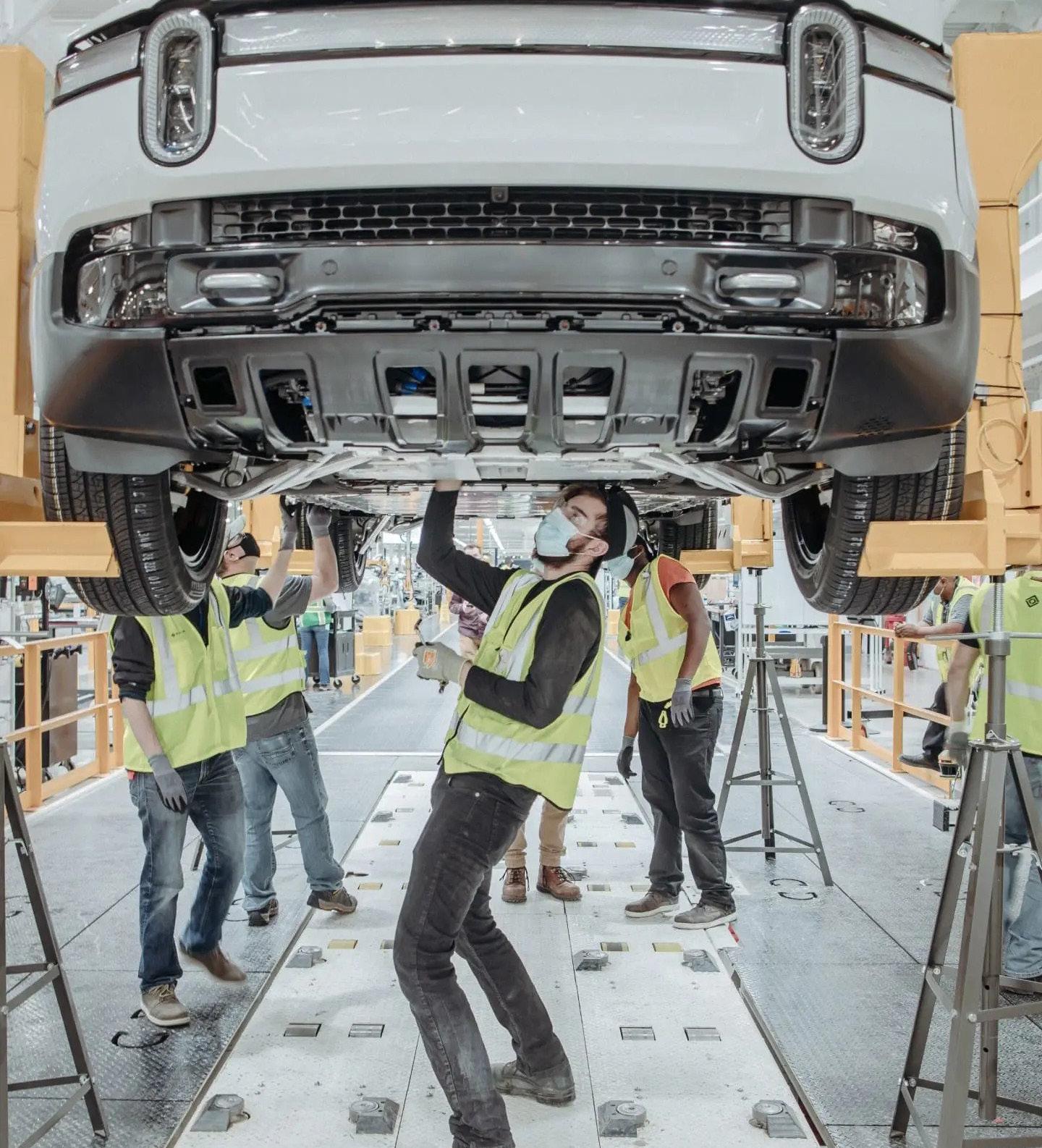
EVMAGAZINE.COM [Jan 2023] 57 RIVIAN AUTOMOTIVE
BRAD HOOD DIRECTOR

USE THE MOST SUSTAINABLE PRODUCTS WE CAN AND TRY TO BE MORE SUSTAINABLE WITH THE MATERIALS OF THE VEHICLES”
“WE
OF INDIRECT PURCHASING
58 [Jan 2023] EVMAGAZINE.COM RIVIAN AUTOMOTIVE
RIVIAN
sourcing playing an integral role in reducing emissions down the supply chain. As the company expands its own charging network, technology will allow personnel more time to explore renewable energy sourcing, making sure that Rivian customers are charging up with clean energy.
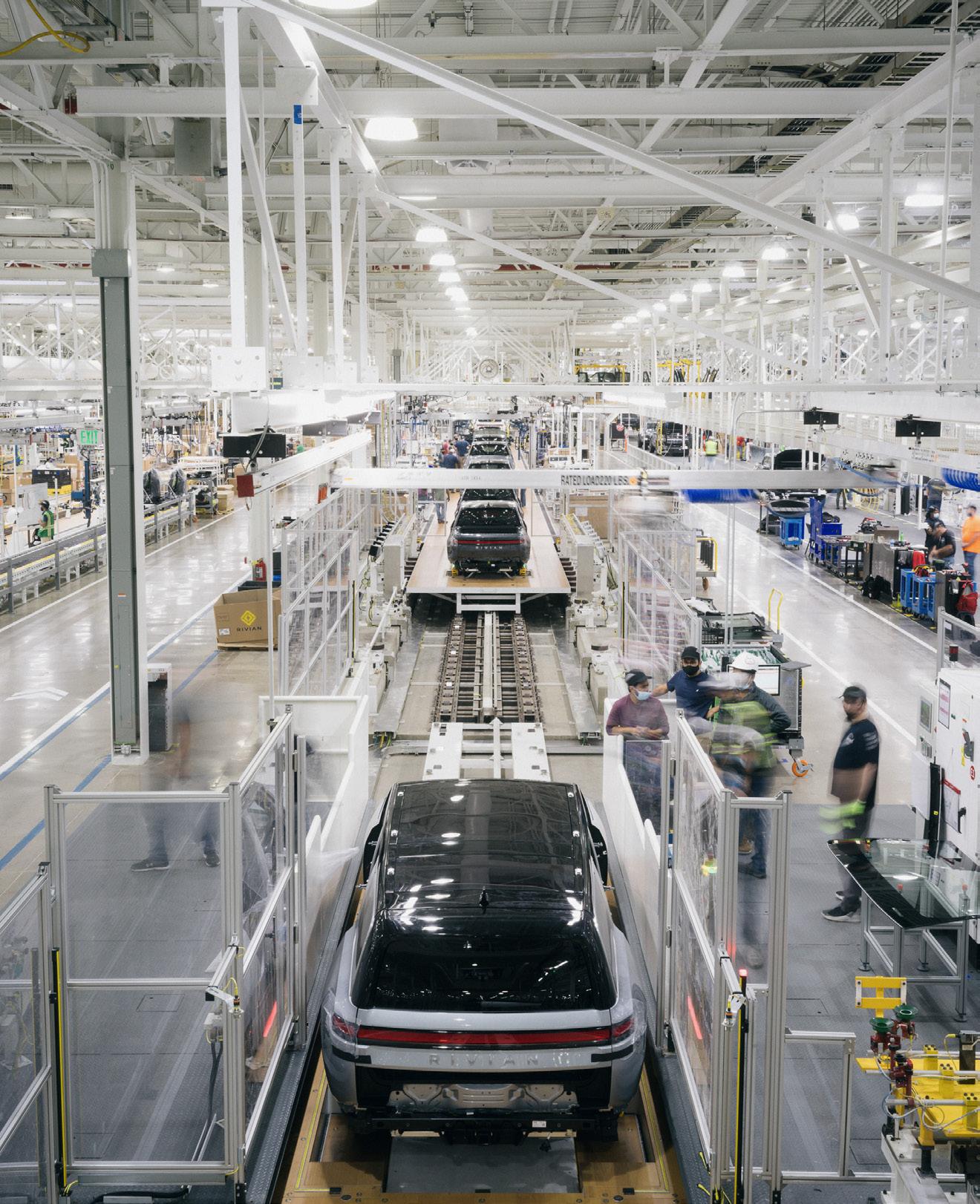

Meeting its strategy for success hinges on its use of data in the procurement functions to standardise processes and focus on saving costs, time, and limiting negative
climate impact—with the overarching aim of eliminating it. As such, the procurement team will look at supplier spend and consider whether its dollars are going towards the desired suppliers.
While much of the technology adoption and integration is carried out in-house, Hood explains that technology partners will be leveraged by Rivian to meet demands unique to its processes.
Hood says: “We understand what we want to do in theory—on a whiteboard—but how do we integrate that into the actual software that’s more commonplace?”
In trying to answer this question, the company has been able to push technologies to their absolute limits, which is a benefit to Rivian, but also the partner that supplies that solution—making Rivian a testbed ripe for procurement solutions.
EVMAGAZINE.COM [Jan 2023] 59
HINGES ON CHARGING & INFRASTRUCTURE
One of the key factors shaping EV adoption is charging infrastructure and consumers’ ability to charge their cars at home and at retail shopping centres

LIFE WITH EVS HINGES ON CHARGING INFRASTRUCTURE 60 [Jan 2023] EVMAGAZINE.COM

FEA TURED CAR: AUDI Q4 50 E-TR ON QUATTRO
The charging dilemma is a rollercoaster ride of sorts. At one end of the track, everything seems to be flowing in favour of electrification, and at the other, external forces like increasing energy prices throw a theoretical spanner in the works.
The fact of the matter is, charging is still a pain point for drivers that would like to consider switching to an electric vehicle (EV). According to the European Association of Electromobility (AVERE), access to charging infrastructure is a trend that matches the increased consumer interest in electrification.
The organisation also cites the EAST-E project, showing the mindset shift in eastern European countries once they have gained an understanding of the charging solutions that are available to them. In Slovakia, this rose from 45% to 64% of the population. In the Czech Republic, this rose significantly from 25% to 48%.
Beyond the price point, it’s significantly easier to get a hold of an EV these days; the factor that affects this the most is one that must navigate external forces, such as the available grid infrastructure and accessibility to sustainable energy sources, which have knock-on effects in the charging landscape. This is partly due to accessibility and those that live in under-developed countries, or even dwell in inner-city apartments, are finding this tricky.
“Today’s charging experience is unfortunately not where it needs to be,” says Tanya Sinclair, Senior Director of Policy for Europe at ChargePoint.

“The future of electric mobility is reliant on making EV adoption an accessible option for all—at home, work and in public.
“A major barrier to this right now is the lack of access to charging infrastructure for those in hard-to-reach areas. We need to see a continued investment from the government if widespread EV adoption is to become a reality.”
62 [Jan 2023] EVMAGAZINE.COM
SHOPS MUST CATER FOR EV CHARGING NEEDS
The most feasible option for drivers in hardto-reach areas in Europe is to power up at their nearest charging station, similar to the process that consumers with internal combustion engine (ICE) vehicles have been doing for decades.
Supermarket chains have inherited the duty of providing ample charging stations for their customers to make owning an EV much easier. Alternatively, we’re seeing more and more charging points popping up in public multi-storey car parks and shopping centres to cater for the needs of EV drivers.
This could perhaps be a method for the high-street to claw back some of its losses post-pandemic, after the industry was hit hard by the global shutdown and repeat lockdowns as a result—not to mention the increased emphasis on ecommerce.
Offering charging for the public will act as a selling point now, but is destined to become a ‘must-have’ in the future, and the retail and lifestyle outlets that fall behind in adopting public charging options are leaving themselves exposed in the future.
A great example of the trend comes when we look at Shop & Charge, a collaboration between the automotive giant Stellantis, BeCharge (a Plenitude business), and Carrefour Italia.

EVS NOW OUTNUMBERING CHARGERS SIGNIFICANTLY, WE HAVE TO REMOVE LOGISTICAL BARRIERS TO GENERAL ADOPTION IN THE RIGHT WAY” TANY A SINCLAIR SENIOR DIRECTOR, POLICY, EUROPE AT C HARGEPOINT EVMAGAZINE.COM [Jan 2023] 63 CHARGING & INFRASTRUCTURE
“WITH
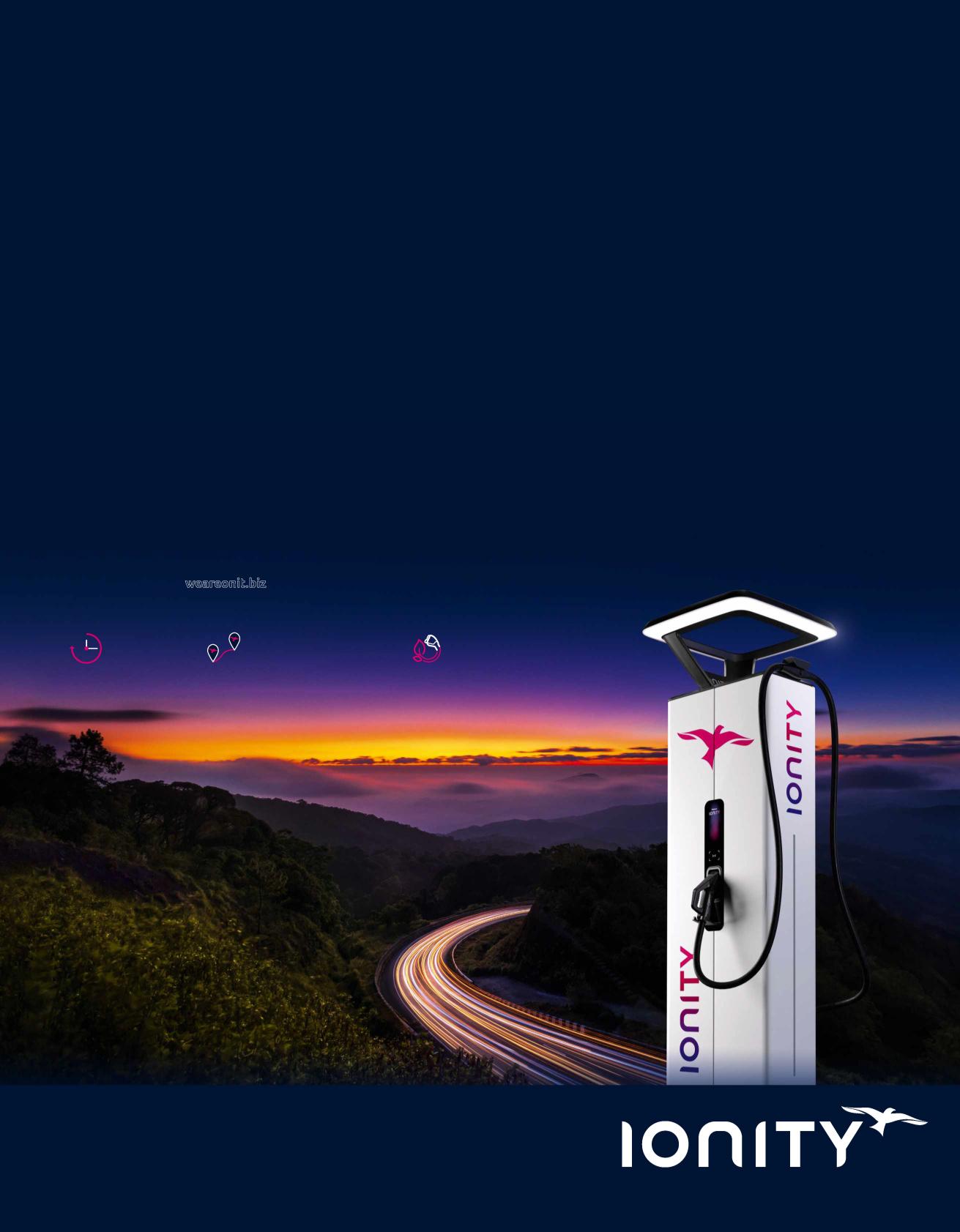
Ì Ó Ì Ê Û Ù Ð Ê Û Ù È Ý Ì Ó � È Ê Ù Ö Ú Ú Ì Ü Ù Ö × Ì � Ê È Ù É Ö Õ ± Õ Ì Ü Û Ù È Ó � There should be no borders when it comes to electric travel That’s why IONITY operates charging stations along European motorways that are open to electric vehicles of any brand With several charging points at each location With ultra-fast charging stations that recharge your vehicle’s batteries for the next stretch of your journey in the shortest time possible And with electricity generated exclusively from renewable energy sources So, you are not only travelling emission-free: the journey really is carbon-neutral Find out more here: weareonit.biz O V E R 1 , 6 0 0 C H A R G I N G P O I N T S I N 2 4 C O U N T R I E S 1 0 0 % R E N E W A B L E E N E R G Y Ü ÓÛ Ù È ÍÈ Ú Û C H A R G I N G W E A R E O N I T. Ì Õ È É Ó Ð Õ Î Ì Ó Ì Ê Û Ù Ð Ê Û Ù È Ý Ì Ó Í Ö Ù Ì Ý Ì Ù à Ö Õ Ì �
Offering charging solutions in places where drivers are likely to spend more time—ie the retail environment—is proving to be a much-desired solution. The project was launched in 2020 and has seen around 1,500 customers across Carrefour’s Italian outlets consume 70,000 kilowatt-hours of energy, eliminating the equivalent of almost 60 tonnes of carbon emissions.
To take this a step further, the Tesco supermarket chain in the UK once offered free charging to EV drivers, which is a selling point in itself, but later shows the effects of an energy crisis as it begins to charge, albeit competitive rates, for electricity from EV hubs. This shows the unfortunate constraints that organisations face in developing the charging landscape further.
MAKING HOME CHARGING AVAILABLE TO HARD-TOREACH INDIVIDUALS
If not charging at the supermarket or as part of their weekend shopping sprees, consumers also demand better solutions for charging at home. Of course, the most popular of all solutions for a lot of consumers is the home charging port, which is working its way into the construction process of homebuilders.
But, if you live in an apartment without a parking space, the ability to charge becomes a lot more difficult.
“A large number of households in the UK lack access to off-street parking; this number rises even further within large cities, like London,” says Sinclair.

EVMAGAZINE.COM [Jan 2023] 65
CHARGING & INFRASTRUCTURE
“TODAY’S CHARGING EXPERIENCE IS UNFORTUNATELY NOT WHERE IT NEEDS TO BE”
TANY A SINCLAIR SENIOR DIRECTOR, POLICY, EUROPE AT C HARGEPOINT
As the EV industry expands, the lag is expected among parts of the populace in built-up areas, as they already struggle for spaces to park cars, let alone charge them. As a result, customers will look to public changing facilities as the primary solution for keeping their EVs on the road.
“With EVs now outnumbering chargers significantly, we have to remove logistical barriers to general adoption in the right way. If drivers have access to charging wherever their car is parked —at the supermarket, the gym or at work —the demand for public charging is greatly reduced.
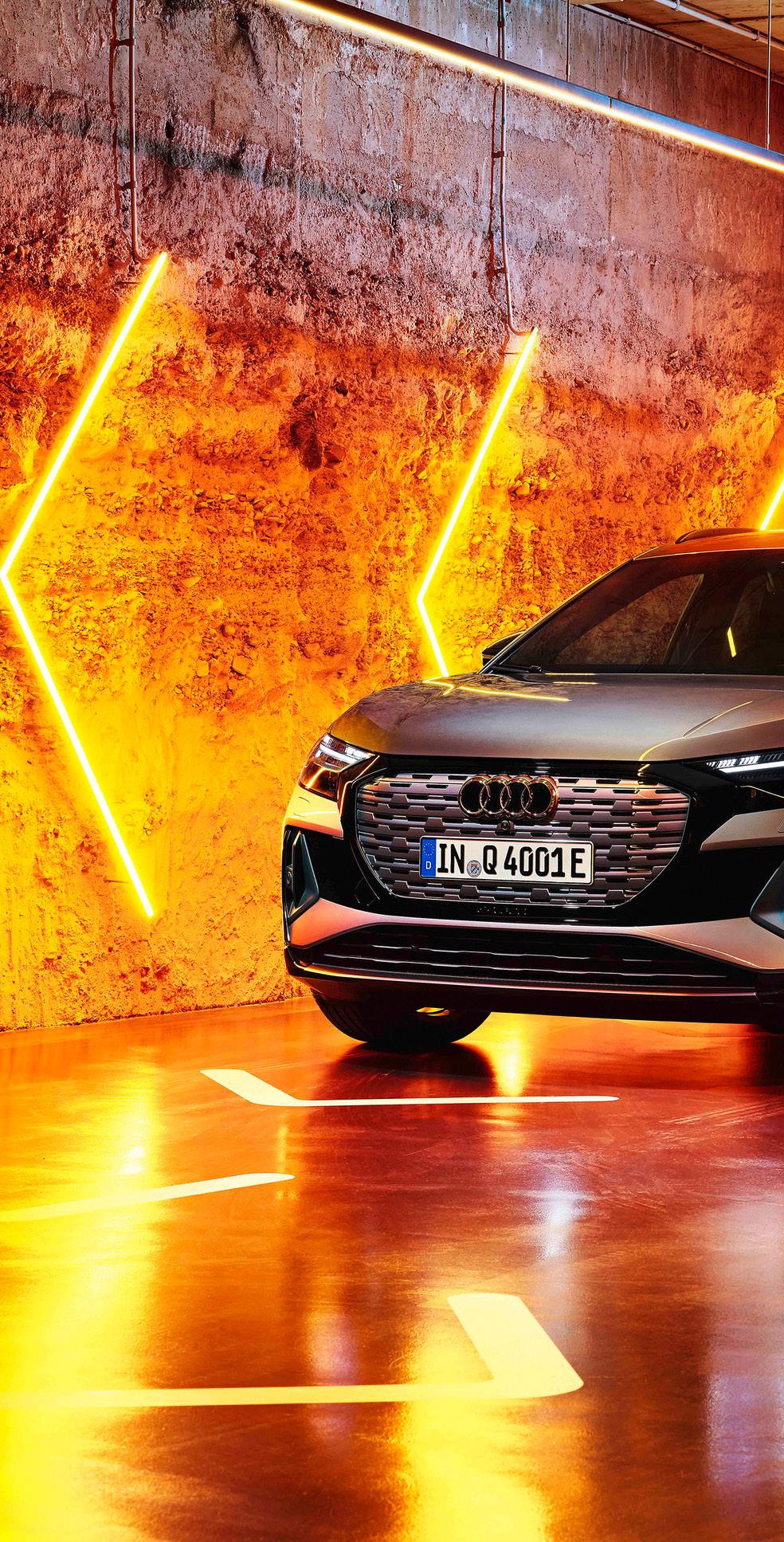
66 [Jan 2023] EVMAGAZINE.COM
CHARGING & INFRASTRUCTURE
“ChargePoint is working tirelessly to provide charging solutions in these types of locations across the country.”
The initiatives and partnerships adopted by the likes of Carrefour Italia and Tesco—but also clients of ChargePoint in the US—shows that organisations are seeing these trends and coming up with ways to cater EV owners.
In the future, it’s likely that we’ll be delving into further options for EV charging, such as on-street charging solutions, which may even be embedded into existing infrastructure like street lamps.
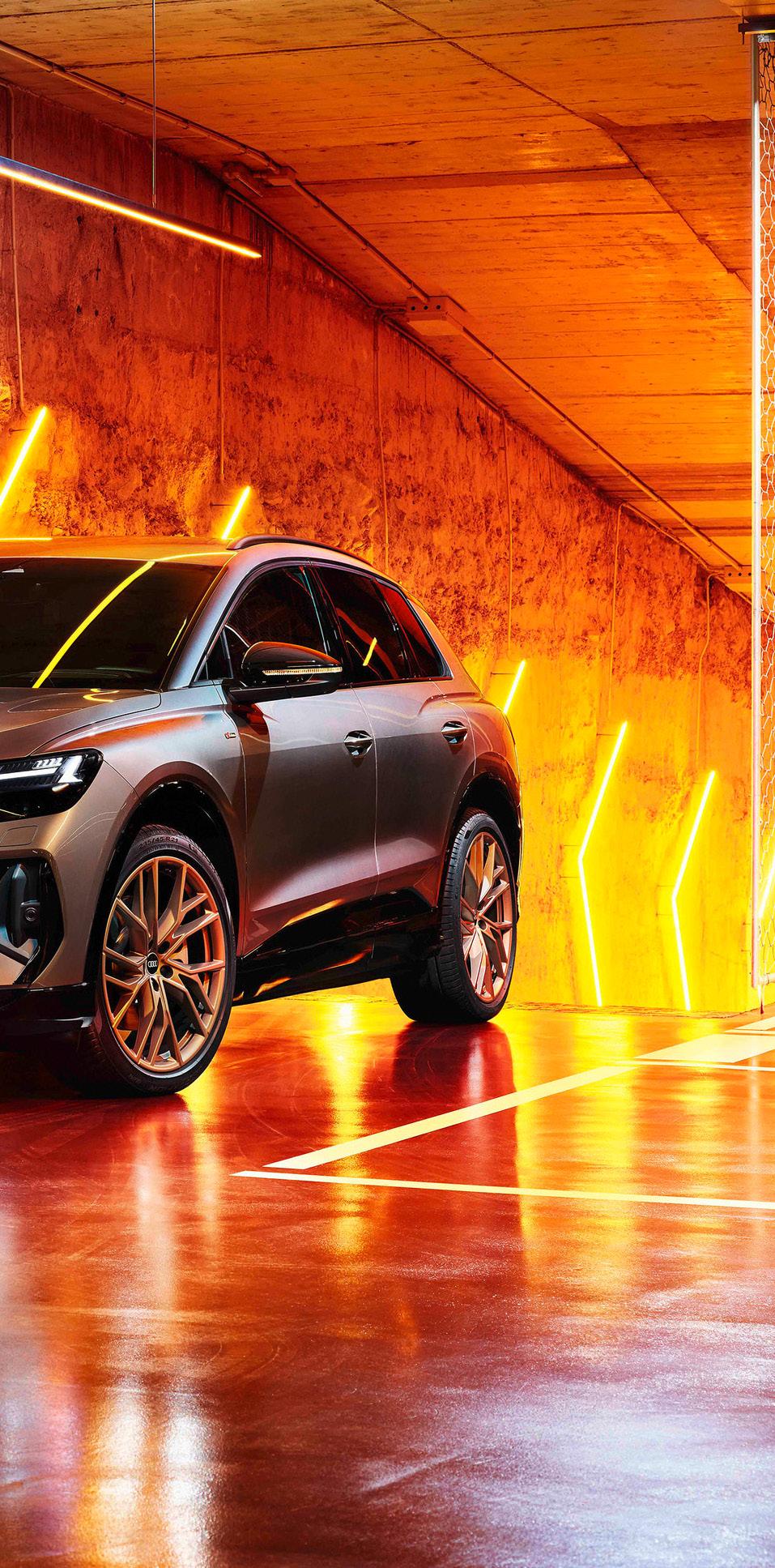
EVMAGAZINE.COM [Jan 2023] 67


EVMAGAZINE.COM [Jan 2023] 69
& COMMERCIAL
FLEET
Connecting cities to cities and cities to towns, trains are becoming faster, more advanced, and are already leveraging electrification technologies to transport large numbers of passengers on a daily basis. Connecting cities across the globe, trains are becoming the critical links between both national and international destinations.
To ensure that climate change doesn’t reach its peak, switching 91% of road vehicles that contribute to global emissions is a crucial step—and, in the UK alone, this makes up around 27% of the share of vehicles producing greenhouse gas (GHG) emissions.
of energy and sustainability technology solutions, public transportation is one of the most effective mobility solutions to decarbonise towns and cities in the long-term.
“The benefit of electrifying mobility services is that it will pave the way for the use of clean renewable energy in the future, not only shifting power generation away from fossil fuels, but also improving the stability and security of the nation’s energy,” says Lakruwani Herath-Culley, External Communications and Government Affairs Lead at Siemens.

Electrification isn’t just a task for the automotive manufacturers.
70 [Jan 2023] EVMAGAZINE.COM
Siemens is contributing to a sustainable future, supporting adoption of electric rail
where electrification is key, electric rail transport is a major part of the global decarbonisation strategy.
“Globally, there is a push for cleaner energy production. Countries like Denmark are building massive train electrification plans, while others like Egypt are working for new, cleaner, more effective rail networks,” says Herath-Culley.
“There is no doubt that technologies developed and constructed in locations like Chippenham, UK, will benefit the rest of the world.”

“ALTERNATIVE TRANSPORTATION OPTIONS, SUCH AS NEW TRAMWAYS OR MORE ENVIRONMENTALLYFRIENDLY TRACTION LIKE HYDROGEN, CAN BE IMPLEMENTED” LAKRUWANI HERA TH-CULLEY, EXTERNAL COMM UNICATIONS AND GOVERNME NT AFFAIRS LEAD AT SIEMENS EVMAGAZINE.COM [Jan 2023] 71 FLEET & COMMERCIAL

COST CLOUDS NECESSITY FOR RAIL ELECTRIFICATION
The challenges are somewhat similar when it comes to decarbonising the rail network, whether in a national or international setting. Rail development will improve connections between cities, but require ample investments to do so.
Despite its obvious benefits, electricity alone may not be the optimal solution in creating a more sustainable network. Currently less than half the network is electrified in the UK, and in less-developed geographies, the demand for more innovative rail is much more apparent.
“Siemens Mobility has implemented and planned new technologies in infrastructure and traction, such as battery and hydrogen trains,” says Herath-Culley.
She also explains that there’s potential for other solutions to be incorporated into the mix.
“Alternative transportation options, such as new tramways or more environmentallyfriendly traction like hydrogen, can be implemented to make sure that these places are not left behind,” she says.
“An excellent illustration of this is Scotland's plan to decarbonise its railways by 2035, which offers SMO UKI the chance to put its cutting-edge technologies, such hydrogen and battery trains, into practice.”
“The Sicat SX technology, which is now operational on portions of the Scottish network, is one alternative that could help open the door for a more effective and affordable decarbonisation programme in Scotland.”
Not just a key technology solution provider, Siemens presents many groundbreaking solutions for sustainable applications. From vertical growth to electric mobility, the company is dedicated to developing a sustainable future through innovation.
In 2022, the company showcased a whole host of technologies to support manufacturers, charging station applications, efficient distribution of power across the build environment, and much more. The team held its first ever Siemens Transform conference, which presented the best of its technologies while also sharing insights from major players in the industry.
Siemens Mobility is working on some exciting projects to decarbonise mobility, from the rail network to the road. Automation also plays a key role in ensuring that transportation systems remain efficient while also providing commuters with the necessary public offerings to go about their daily lives, both economically and in an environmentally-friendly manner.
Such solutions include high-speed and intercity trains, trams and light rail, locomotives, as well as the components and digital systems to operate them.
EVMAGAZINE.COM [Jan 2023] 73 FLEET & COMMERCIAL
SHAPING WORLD TRANSPORTATION WIT H ELECTRIC

“THE BENEFIT OF ELECTRIFYING MOBILITY SERVICES IS THAT IT WILL PAVE THE WAY FOR THE USE OF CLEAN RENEWABLE ENERGY IN THE FUTURE” LAKRUWANI HERA TH-CULLEY, EXTERNAL COMM UNICATIONS AND GOVERNME NT AFFAIRS LEAD AT SIEMENS
Despite these solutions’ place in the transportation sector, the ability to provide transport solutions for the masses comes down to cost.
“Even though not everything needs to be electrified, it is crucial to offer affordable and effective transportation options for everyone.”
The cost to consumers, but also authorities, is considered a major challenge of rail electrification. The short-term cost certainly outweighs the long-term issues resulting from a hesitant approach, but Herath-Culley explains how the UK faces political challenges when making the switch.

“Since only 42% of the UK’s tracks are currently electrified, diesel engines continue to provide most of the network’s traction power,” Herath-Culley says.
“In the short run, electrification may prove to be expensive. This can sometimes be attributed to expensive civil engineering projects in difficult geographic locations and inefficient manufacturing processes, which frequently need the creation of business cases from an economic perspective.”
EVMAGAZINE.COM [Jan 2023] 75 FLEET & COMMERCIAL
THE SUSTAINABLE
MOBILITY SERVICE

Urban living is changing and organisations have found an innovative way to transport individuals sustainably: using electric scooters

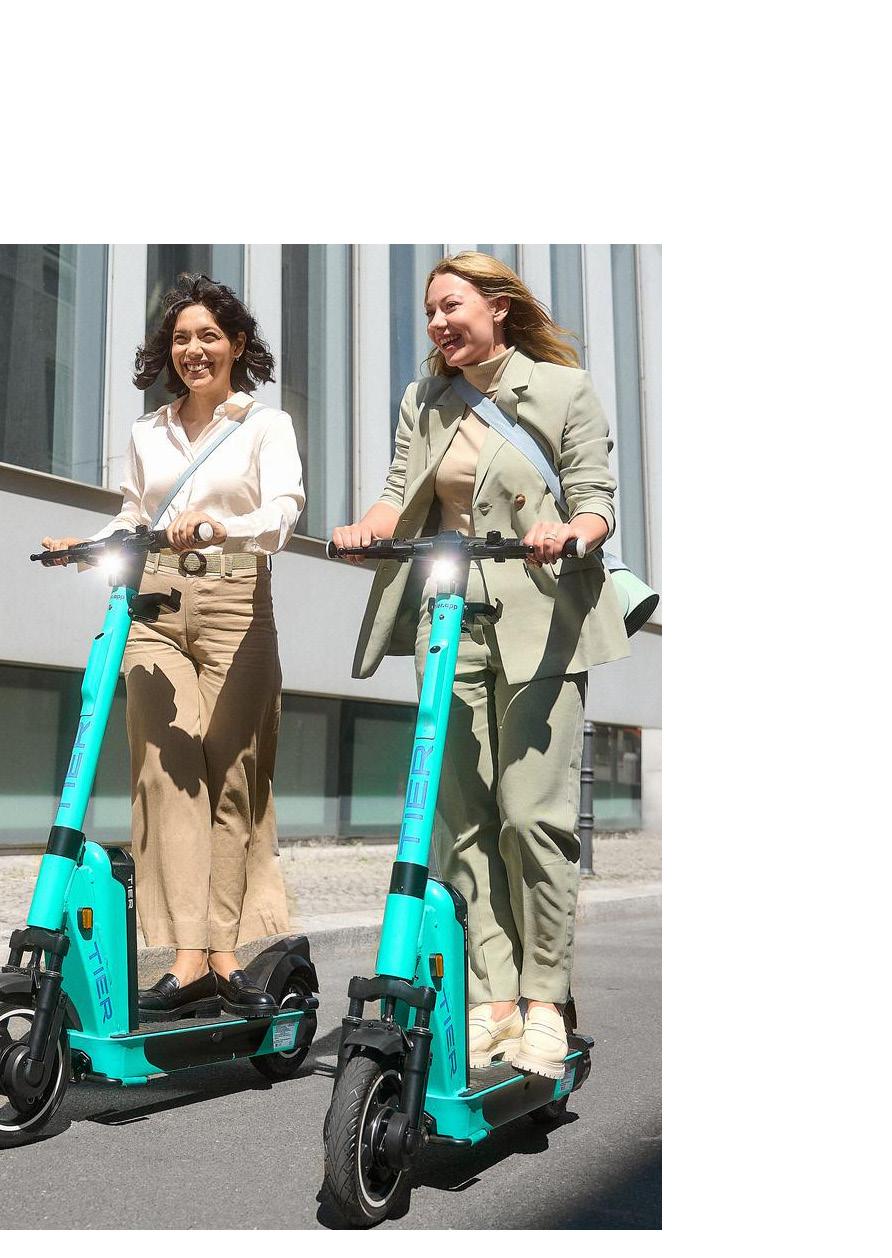
EVMAGAZINE.COM [Jan 2023] 77 MOBILITY
The majority of people living in cities these days will have experienced electrification benefits through the growing e-scooter initiative. In recent years, there has been an influx of new micro-mobility solutions that not only provide great decarbonisation efforts, but also allow ease of movement for city residents.
For the Gen Z population, now entering into the world of work or building their careers, e-scooters have become the norm, particularly across areas of the world where micro-mobility is now widespread across Europe, the Middle East, and the Americas. The sheer fact that we can't remember some of the most well-visited cities before micromobility appeared shows how rapid the pace of change has become.
At first, micro-mobility seemed like a novelty, allowing travellers to work their way round a city in an exciting new way. But as the industry evolves, it’s becoming a movement that’s here for the long-term, thanks to undeniable benefits.
MICRO-MOBILITY REPRESENTS A MINDSET SHIFT
According to research by Grandview, the global e-scooter market was estimated at a combined value of US$20.78bn in 2021, and there have only been more applications since that period. As a result of a 78% compound annual growth rate, the industry is expected to develop much further between now and the 2030 climate change deadline for electric vehicles (EVs).
Electric transportation is a response from governments to decarbonise their cities, and one of the most effective ways to do that is to eliminate cars from the equation—for the most part. Alternatively, public transport is more in demand with more electric buses produced for innercity transit, but the more noticeable change is micro-mobility, which is being used by commuters, fun-lovers, and delivery drivers alike, as well as anyone who needs to get somewhere in a pinch. What cities need are solutions that challenge the norm, as those are the initiatives that facilitate a shift in not just sentiments, but livelihood, too.
JESS HALL HEAD OF CITIES UKI,TIE R MOBILITY
It’s more common these days to go against the grain, and that’s exactly what businesses in the micro-mobility sector have done. Tapping into a new method of transport has ultimately transformed the lives of many and created lasting change in the way consumers use transportation.
“THE KEY INDUSTRY TRENDS AT THE MOMENT ARE ABOUT CREATING A SERVICE THAT IS ABLE TO SUPPORT OPERATIONS IN THE LONG-TERM”
78 [Jan 2023] EVMAGAZINE.COM MOBILITY


PLATFORMS ARE ENABLING THIS BY BRINGING TOGETHER DIFFERENT TYPES OF MOBILITY AND MAKING IT EASIER FOR PEOPLE TO PLAN”
MATTHE W PENCHARZ HEAD OF PUBLIC POLICY FOR UK, IRELAND & THE NE THERLANDS, VOI TECHNOLOGY
the last mile. By reclaiming road space from the car, we can reduce traffic and pollution to make cities more liveable.”
The ability to facilitate such a shift in mobility plays into the hands of companies like TIER Mobility, Voi, and Bird, who wish to change the course of climate change while addressing the need to transport a much larger population.
THE E-SCOOTER INTEGRATES INTO MOBILITY-AS-A-SERVICE
There is something in common with many of the latest and greatest transportation options used today—technology. Specifically, app-based mobility. It seems that more commuting methods have become integrated with applications to provide consumers with what can be best described as ‘mobility-as-a-service (MaaS)’.

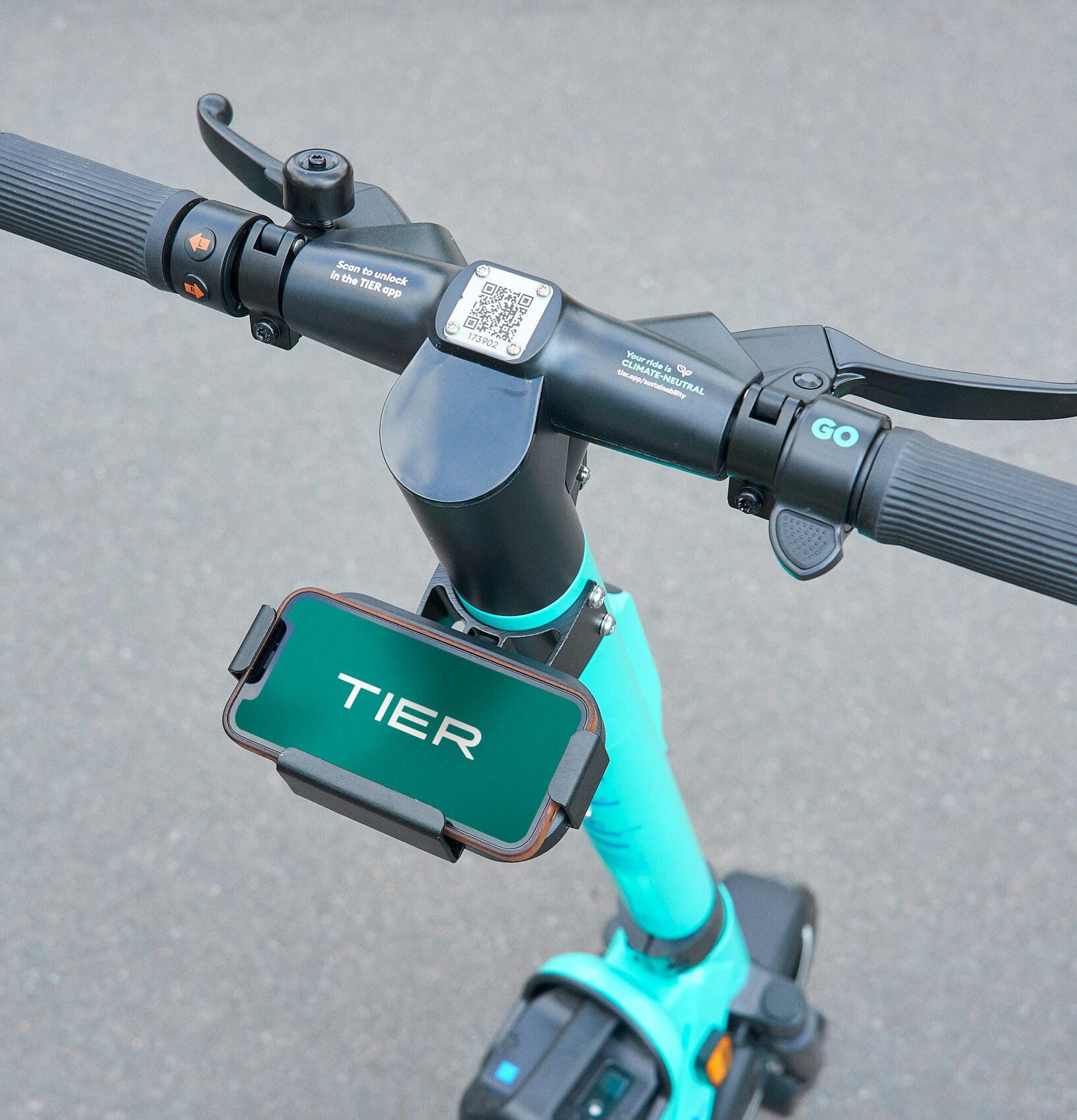
As a collective, the idea behind e-scooters, e-bikes, and e-mopeds is to transform mobility by defiance of convention; a method that will transition the world from heavily-polluting cars. “Our urban areas have been designed around the car for decades, at the expense of developing transport systems that put people first,” says Jess Hall, Head of Cities UKI, TIER Mobility.
“Our aim with shared micro-mobility is to offer a sustainable alternative to today’s reliance on personal cars by expanding the reach of existing public transport networks and offering a personal mobility solution for
“MAAS
MOBILITY
“MaaS is an extremely broad term, encompassing everything from ride hailing to both docked and dockless shared micromobility services. But at its core, MaaS removes the need for the consumer to own their own personal form of transport,” says Hall, as she sums up the term in the best possible way.
Although micro-mobility was far from the only driving force in influencing MaaS, Hall explains that it’s meeting the demand for multi-modal journeys.
“I wouldn’t say that e-scooters influenced the demand for MaaS so much as shared that micro-mobility has proven to be the answer to consumer demand for accessible, sustainable, and affordable personal mobility for shorter journeys,” says Hall.
From another brand in this space, Matthew Pencharz, Head of Public Policy for UK, Ireland & the Netherlands at Voi Technology, adds to this: ”Shared e-scooters have
What e-scooters represent is, as mentioned, a change in mindset, which is the first step for any e-mobility industry that looks to grow purely through sustainable influence, and by meeting the developing needs of a growing population.
Nevertheless, the industry continues to rise, and further concerns around e-scooters will shape how businesses adapt their products and services—one of these is the safety aspect of publicly-used e-scooters. “The key industry trends at the moment are about creating a service that is able to support operations in the long-term,” says Hall. “There’s some ongoing dialogue with local authorities on what a successful “OUR
delivered a sustainable ‘last-mile solution’. Instead of just jumping in a private car, you can use an e-scooter to travel to the train station or bus stop, and use public transport for the rest of your journey.
“MaaS platforms are enabling this by bringing together different types of mobility and making it easier for people to plan, pay and access these services. Over a third of our trips are taken in conjunction with public transport, a number that will only increase as more MaaS platforms are launched.”
URBAN AREAS HAVE BEEN DESIGNED AROUND THE CAR FOR DECADES, AT THE EXPENSE OF DEVELOPING TRANSPORT SYSTEMS THAT PUT PEOPLE FIRST” JESS HALL HEAD OF CITIES UKI, TIE R MOBILITY 82 [Jan 2023] EVMAGAZINE.COM MOBILITY
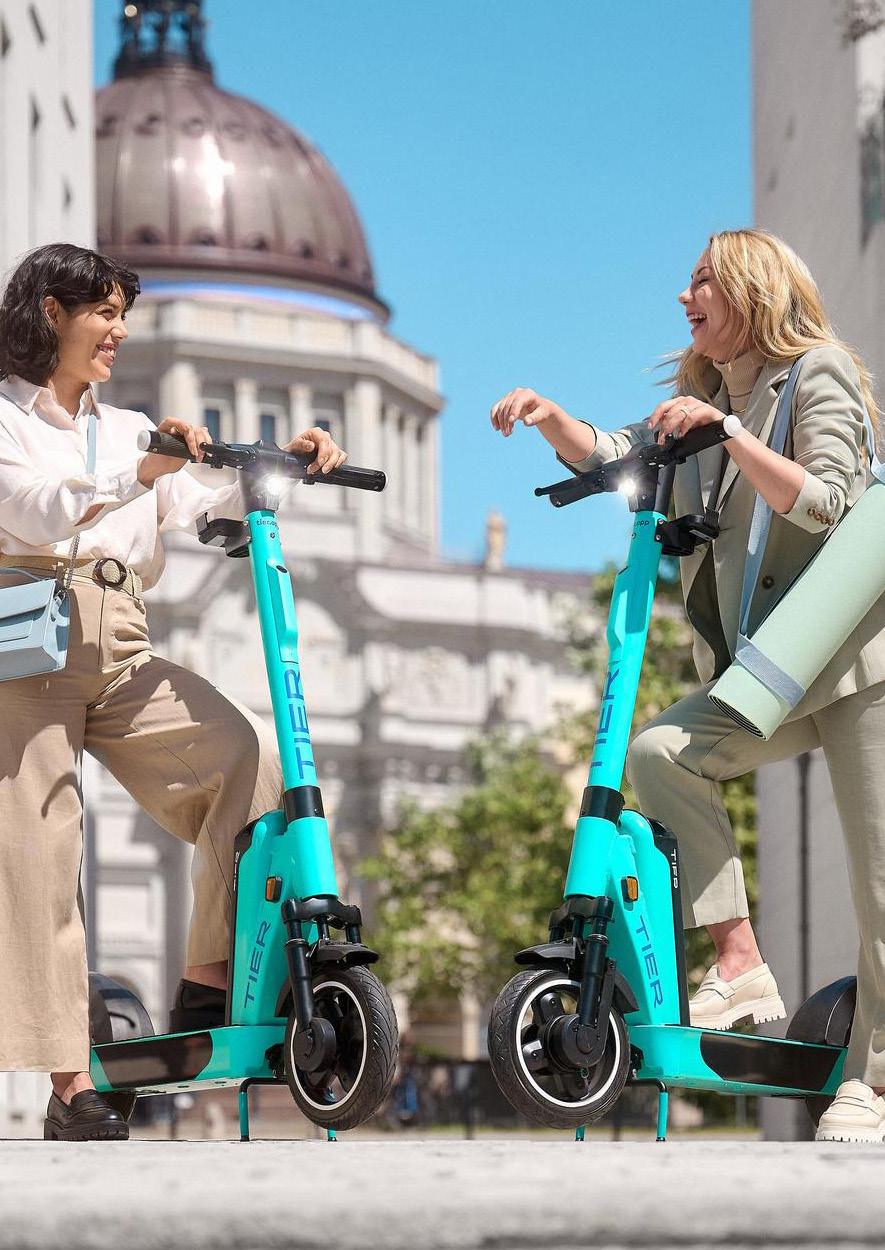
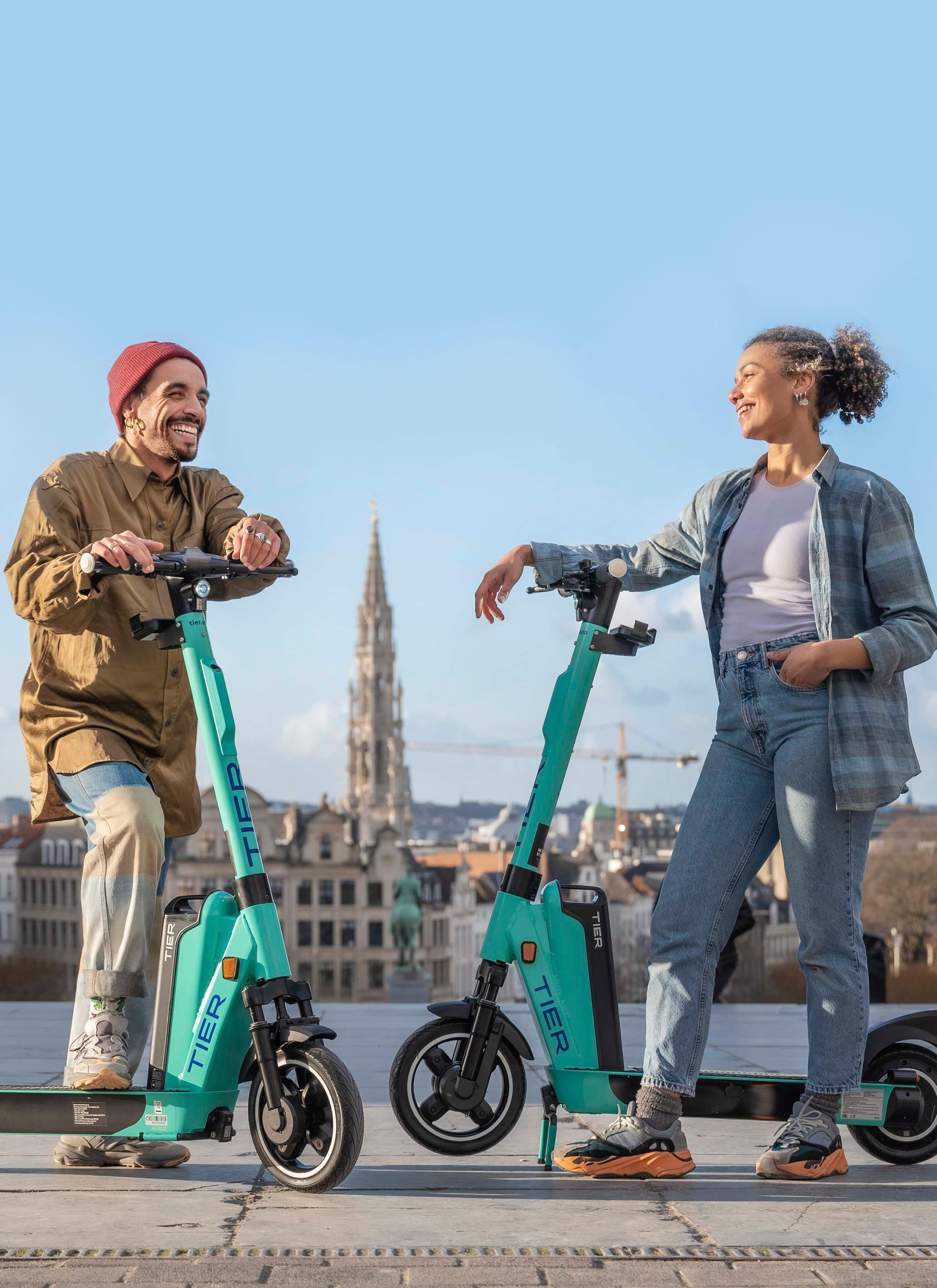
84 [Jan 2023] EVMAGAZINE.COM
TIER MOBILITY: A GLOBAL MICRO-MOBILIT Y OPERATOR
Operating in 560 cities across 33 countries globally, TIER Mobility has a rather special sustainability focus, which is driven by circularity and the ability to support individuals to travel sustainably around cities.
Offering a dedicated app that allows consumers to log in safely and securely, the company allows driver’s licence holders to use its services on demand, creating a network of e-scooters that are maintained, easily accessible, and convenient.
The company is also dedicated to circularity. A critical part of the company’s operating model is repairs and maintenance, which, for a publiclyused micro-mobility service, allows TIER
Mobility to monitor the condition of its products and ensure that the replacement of parts is carried out successfully while also managing the recycling of old components.
Committed to emissions reduction, TIER Mobility is focused on reaching net-zero; currently, however, it’s operating on a carbonneutral basis, eliminating emissions from its supply chain while strategically offsetting any remaining greenhouse gases (GHGs) that aren’t covered in the process.
TIER Mobility also offers docked pedal bikes and electric bikes through its Nextbike brand, which is currently in operation across the EMEA region.
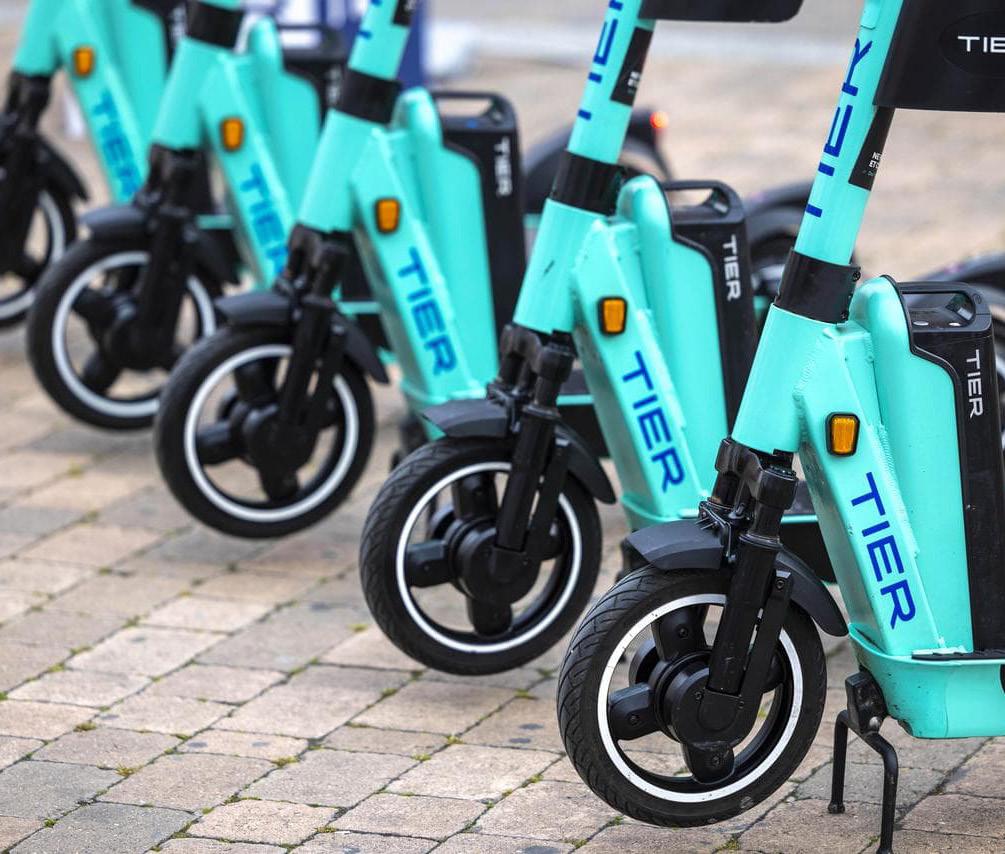
service looks like and educating what tools are at our disposal to make services safe.”
Pencharz also explains how safety and convenience, as well as climate positivity, are shaping the demand for the industry. “Innovation in vehicle development and technology, including improving safety features and parking solutions as well as developing new models, is critical to creating a service that people want and use,” says Pencharz.
“Outside of the industry, concerns about sustainability and the cost-of-living crisis are encouraging people to explore using micromobility. In the UK and Ireland, we’re looking forward to the legalisation of e-scooters, with more schemes launching across towns and cities outside of the current areas.”
As the e-scooter movement grows, companies like TIER Mobility will look to develop a universal sound for e-scooters.
As Hall says: “This is in response to concerns raised by organisations and charities for the visually impaired around how quick, but silent, e-scooters are.”
MOBILITY

TOP TEN


EVMAGAZINE.COM [Jan 2023] 87
From HGVs to last-mile logistics, these 10 companies are electrifying commercial vehicles and bringing groundbreaking solutions to the global supply chain COMPANIES ELECTRIFYING COMMERCIAL VEHICLES
CLOUD-ENABLED LOGISTICS FOR LEADERS
#10 GENERAL MOTORS
While passenger EVs are critical to General Motors’ (GM’s) transition to zero-emissions, the company also owns BrightDrop, a business that delivers innovative, safe, and efficient logistics solutions.

The company has already shared its expertise with big names in the industry, particularly in the US, as it supplies its BrightDrop Zevo 400s and 600s to Walmart and FedEx for first and last-mile deliveries, leveraging cloud-based software. The EV was first released at the Consumer Electronics Show in Las Vegas in January 2021 and has since received US$800mn investment from GM.

88 [Jan 2023] EVMAGAZINE.COM
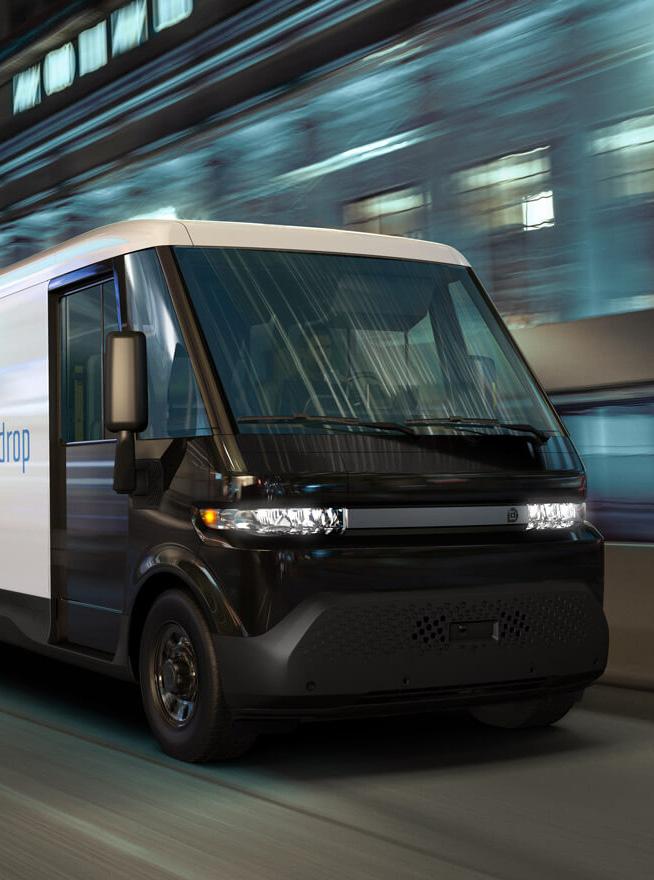
TOP TEN
A POPULAR CHOICE FOR COMMERCIAL
9
FORD MOTOR GROUP
The company that pioneered cost-effective mass production, Ford Motor Group made an announcement in 2022 for muchneeded innovation in battery capacity. The firm expects its EV compound annual growth rate to reach 90% through 2026— which is more than double the predicted growth in the global industry.
As one of the top choices for commercial vehicles, Ford has seen significant growth of its EV range as the Mustang Mach-E continues to fulfil a high demand. When it comes to electric delivery vans, the E-Transit was received by its first customer in early-2022, and was the best-selling option of the year, reaching 4,387 sales through September-2022.
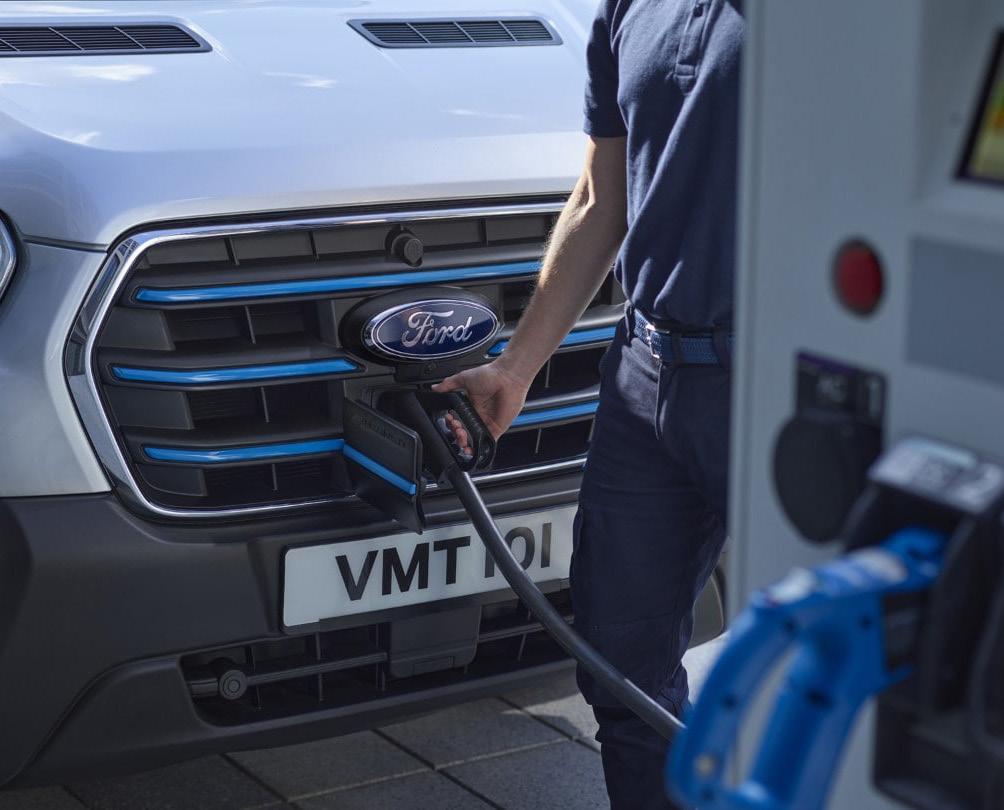
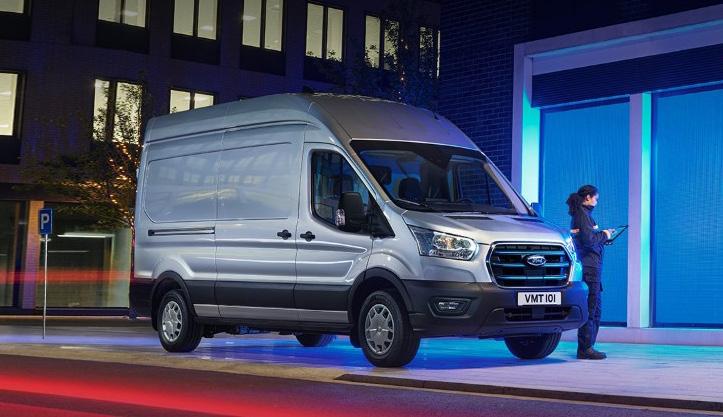
#
WATCH
90 [Jan 2023] EVMAGAZINE.COM TOP TEN
ELECTRIFYING THE LAST-MILE FLEET
#8
RIVIAN
The pure-play manufacturer is placed in a unique position as an all-electric business that sells vehicles in the commercial and consumer vehicle brackets. While we all know of the Rivian R1T and R1S models, it’s the company’s delivery van that was snatched up by leading online retailer Amazon.

Rivian has developed EVs, software, and charging infrastructure to ensure customers the best possible operating experience and cost-effective BEV adoption. The aim of this Rivian Ecosystem is to scale electrification efforts in a simpler way, which is all encompassed in its Rivian FleetOS offering—a proprietary platform that maximises efficiency, integration, and safety.
WATCH

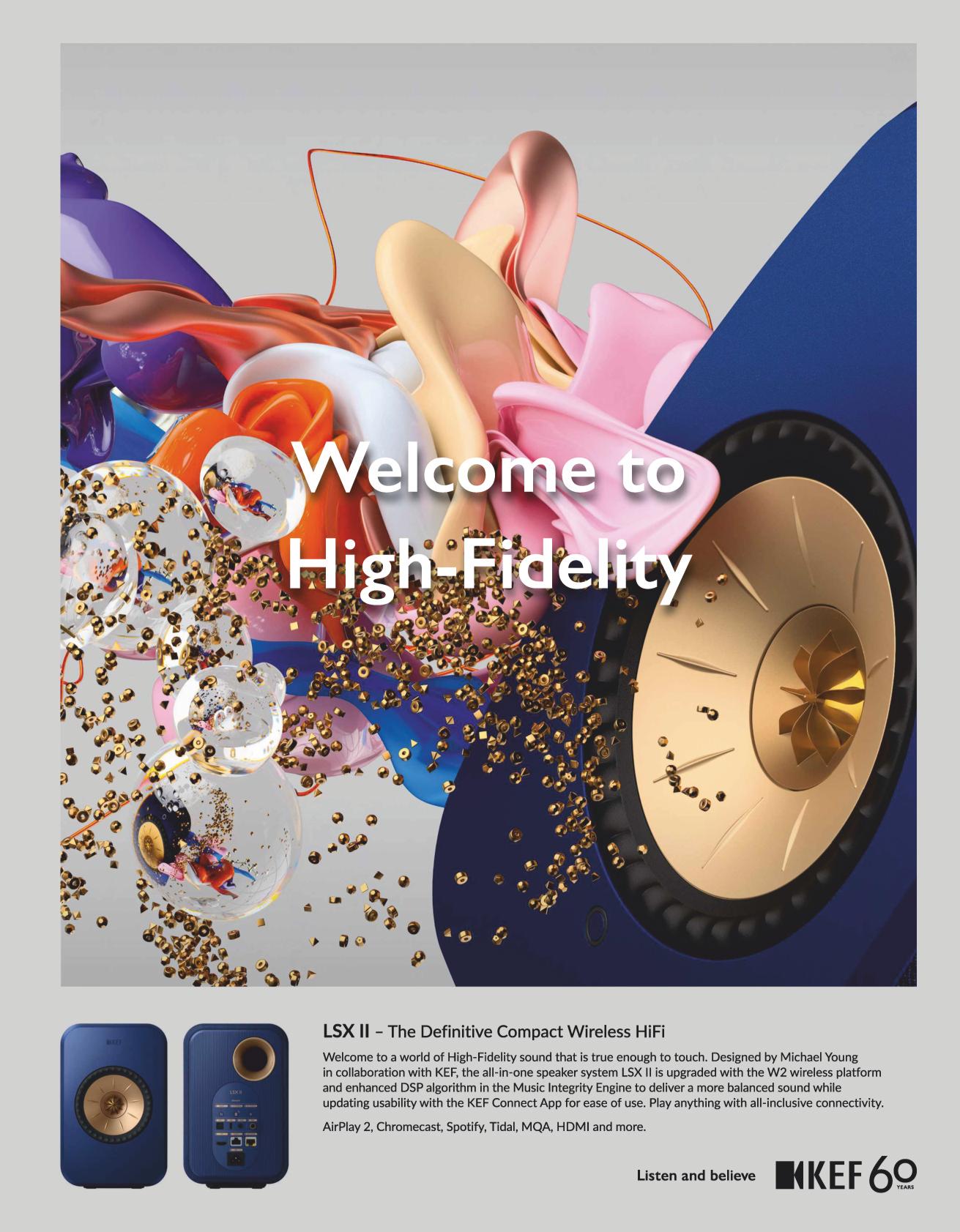
AN OG, RELIABLE BRAND
DAF TRUCKS

Well-known for its reliability in the ICE industry, DAF Trucks is a leader in the trucking world and has big plans to electrify its range as a solution for the future. The company is moving forward with a new vehicle range, which will comprise solely of all-electric vehicles.
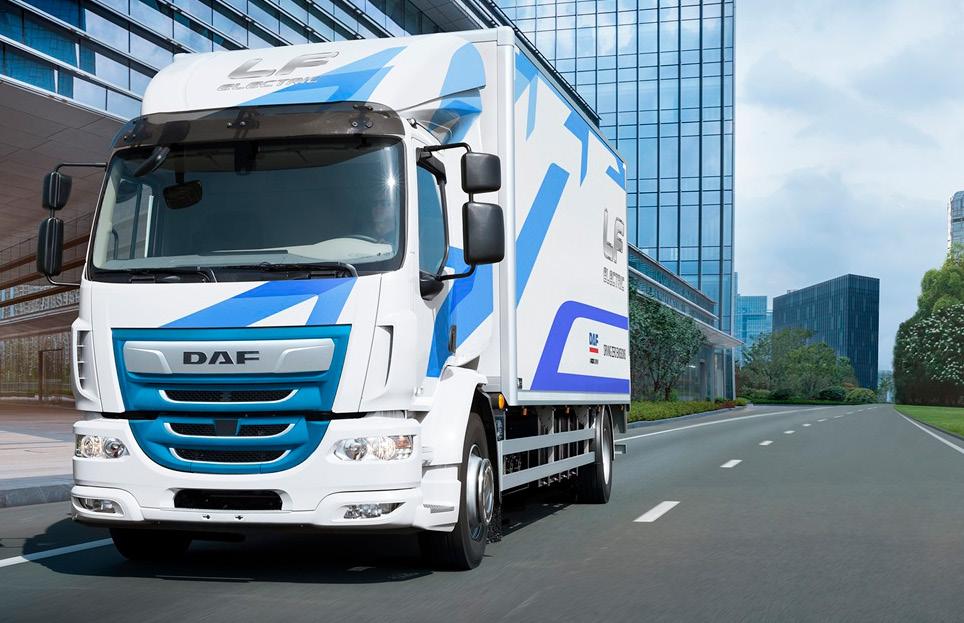
The DAF LF Electric is capable of driving 280km/ charge—subject to driver behaviour, outdoor temperature, load, and topography, of course— with a 282KW/h battery that can be charged from 20% to 80% in around 6.5 hours (or faster if using a rapid charger).

WATCH #7
TOP TEN
TESLA
Of course, the company pioneering a bold, powerful, and efficient electric HGV is Tesla. In 2022, the company released the Tesla Semi with a 500-mile range and charging speed of 400 miles in 30 minutes.

The long-awaited Semi was subject to similar issues faced by automakers as supply chain disruptions hindered the production progress. Nevertheless, as one of the original players in the EV game, Tesla expects to dominate the market through unwavering commitment and a final product performance that rivals the ICE industry.

#
6
UNRIVALLED ELECTRIC PERFORMANCE
94 [Jan 2023] EVMAGAZINE.COM TOP TEN
WATCH
#5
PURE ELECTRIC IS NOT ENOUGH NIKOLA MOTOR
Pioneering zero-emission trucking solutions, Nikola Motor occupies the heavy-goods vehicle market, but is disrupting the conventional methods of innovation. Leveraging both batteryelectric technology and fuel-cell, the company delivers solely sustainable solutions, inclusive of its TRE BEV battery-electric vehicle (BEV) and its two fuel-cell-driven semi trucks, the TWO FCEV and the TRE FCEV—the latter available in late 2023.
Nikola Motor is committed to pushing the boundaries and taking risks while showing the value of simplicity. The company believes that both fully-electric and hydrogen fuel-cell vehicles are both integral to the decarbonisation process.
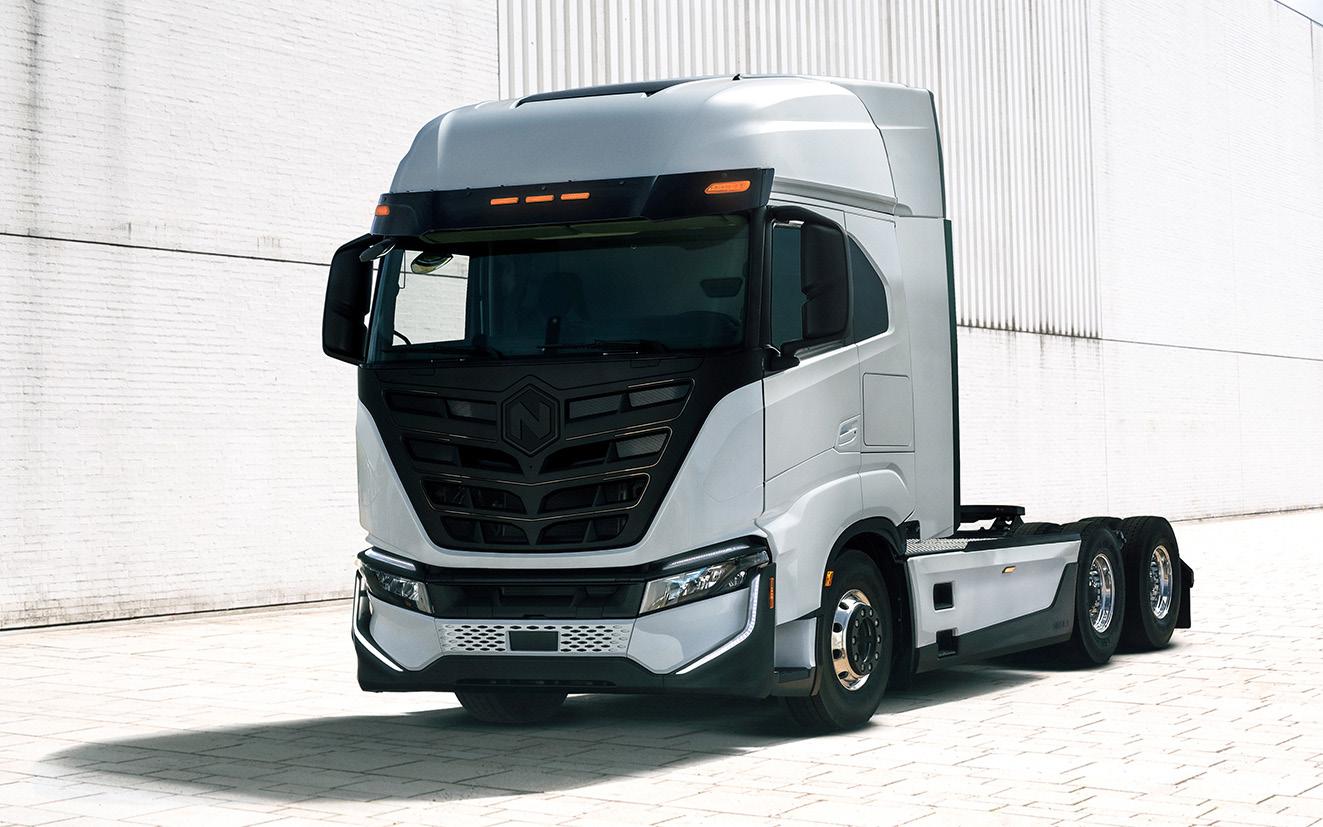
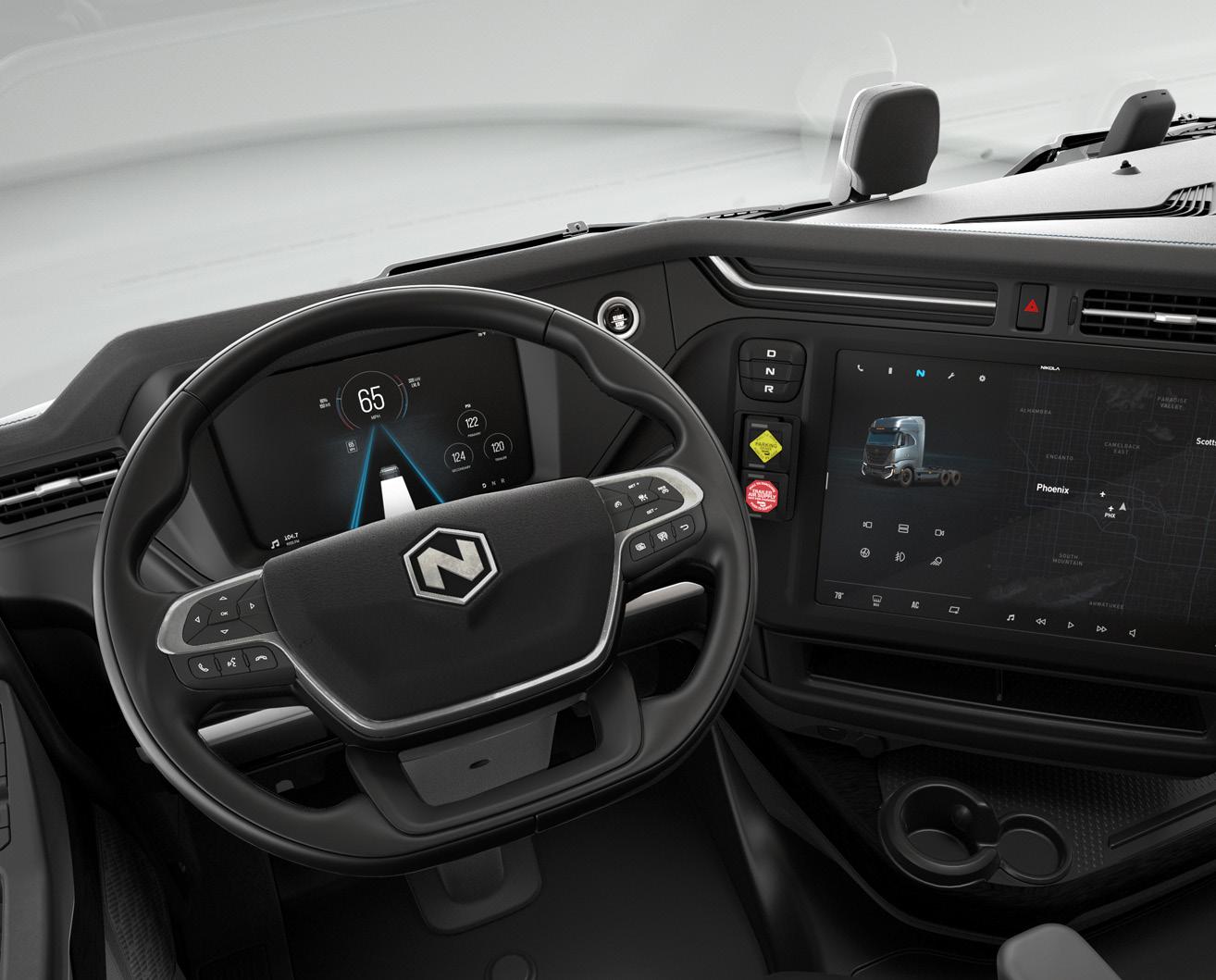
WATCH
A
Competing with Tesla in the passenger EV market, BYD is also a solid contributor of commercials as it develops electrified buses and trucks for industry. In 2020, the company had its sights set on the shorthaul goods industry, but since then, offerings have expanded to incorporate trucks, public and school buses, and the latest research and development project, the Skyrail.

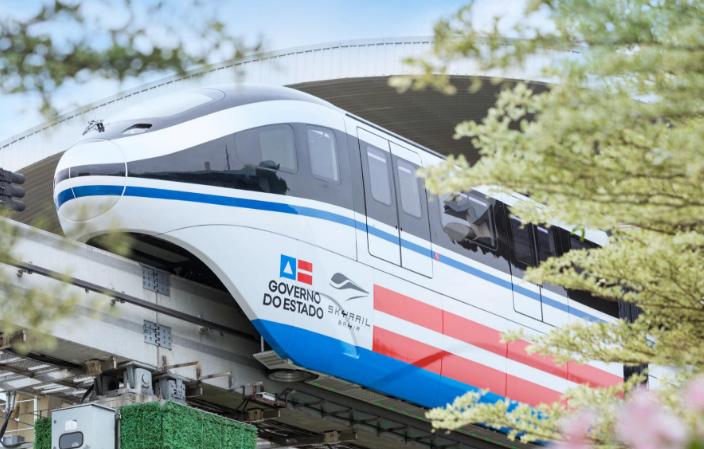
#4
BYD WATCH TOP TEN
BRINGING
COMPETITIVE STREAK
#3
ELECTRIFYING A NEW WORLD TRATON GROUP
Traton Group owns Scania, MAN, Volkswagen (VW) Truck, Navistar, and Rio. While partnering with Daimler AG and Volvo Group for truck electrification, the company is undergoing analysis of its brands, notably MAN, to determine the most cost-effective way to electrify the logistics’ industry.
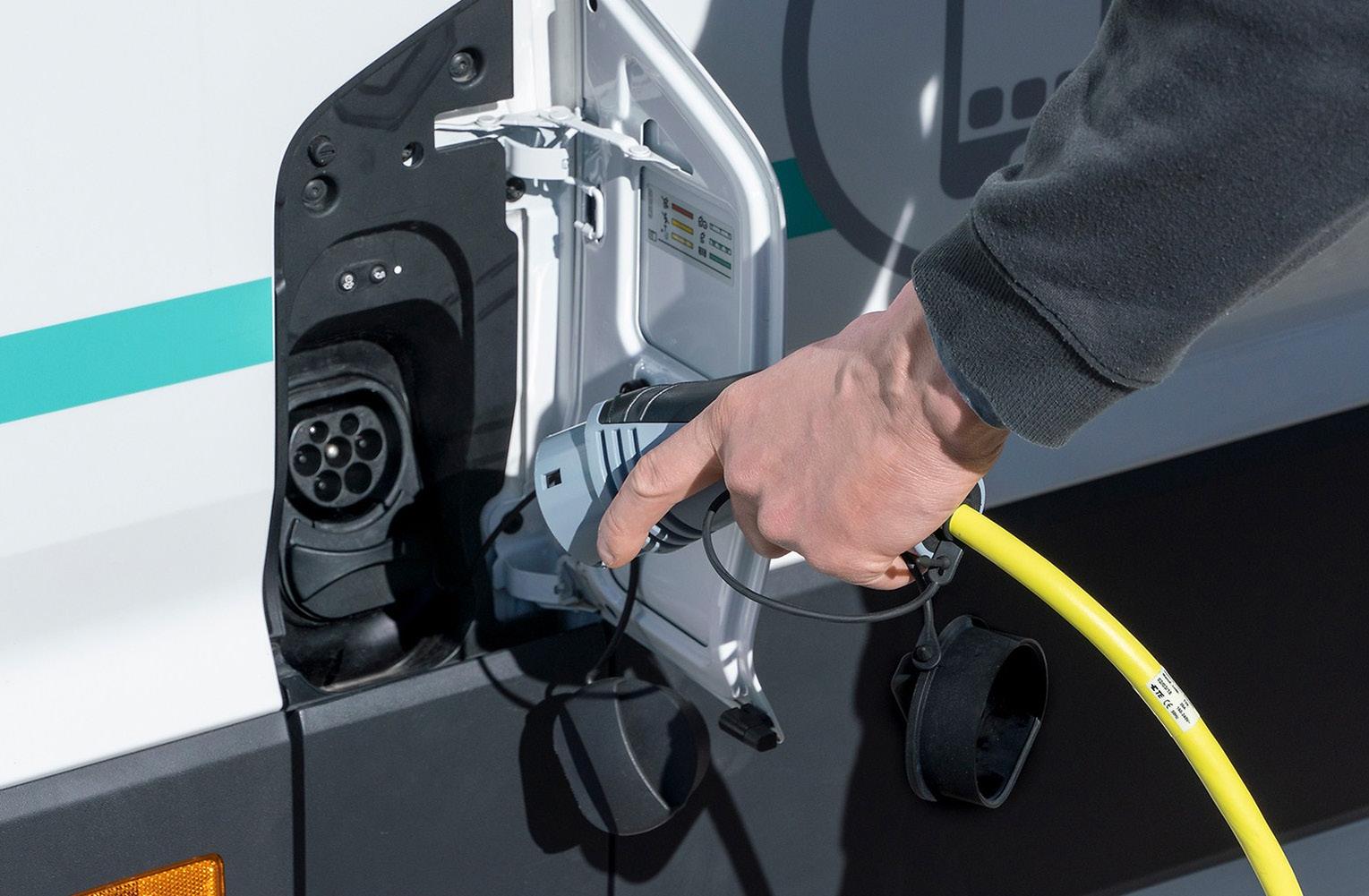
The company is also in the process of developing an electric VW Truck, which is to take point in South America to carry out short-haul delivery journeys.

EVMAGAZINE.COM [Jan 2023] 97
WATCH
2
DEVELOPING A LONG-TERM PARTNERSHIP DAIMLER AG
WATCH
As the owner of Mercedes-Benz, Daimler AG has a critical role to play, becoming part of a trio of businesses venturing into a joint electrification partnership.
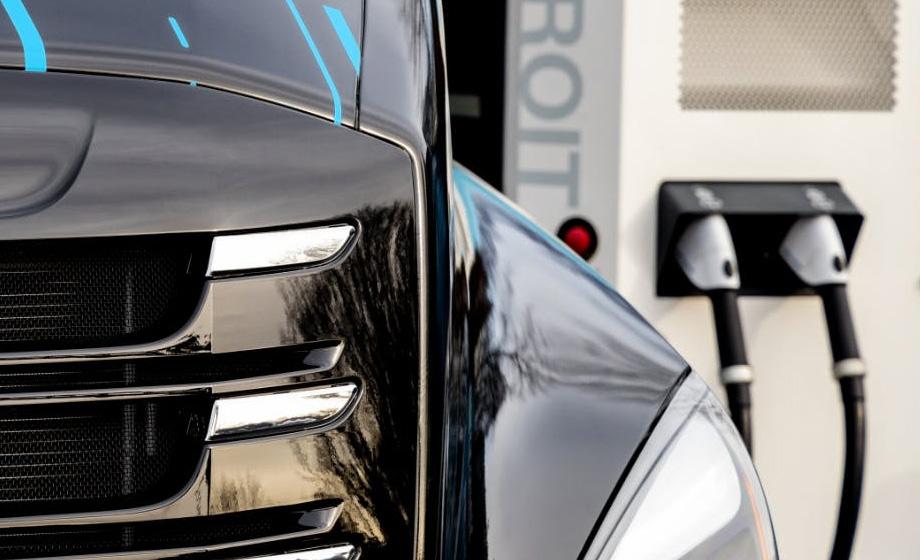
The German automaker is one of the largest truck manufacturers in the world and, in 2018, it announced its all-electric 18-wheeler, called the Freightliner eCascadia. The truck was designed to support port operations and regional haulage via a battery range of 250 miles. The company also distributes another truck, called the Freightliner eM2 106, which achieves a 230-mile range and is used for local distribution networks.

#
98 [Jan 2023] EVMAGAZINE.COM
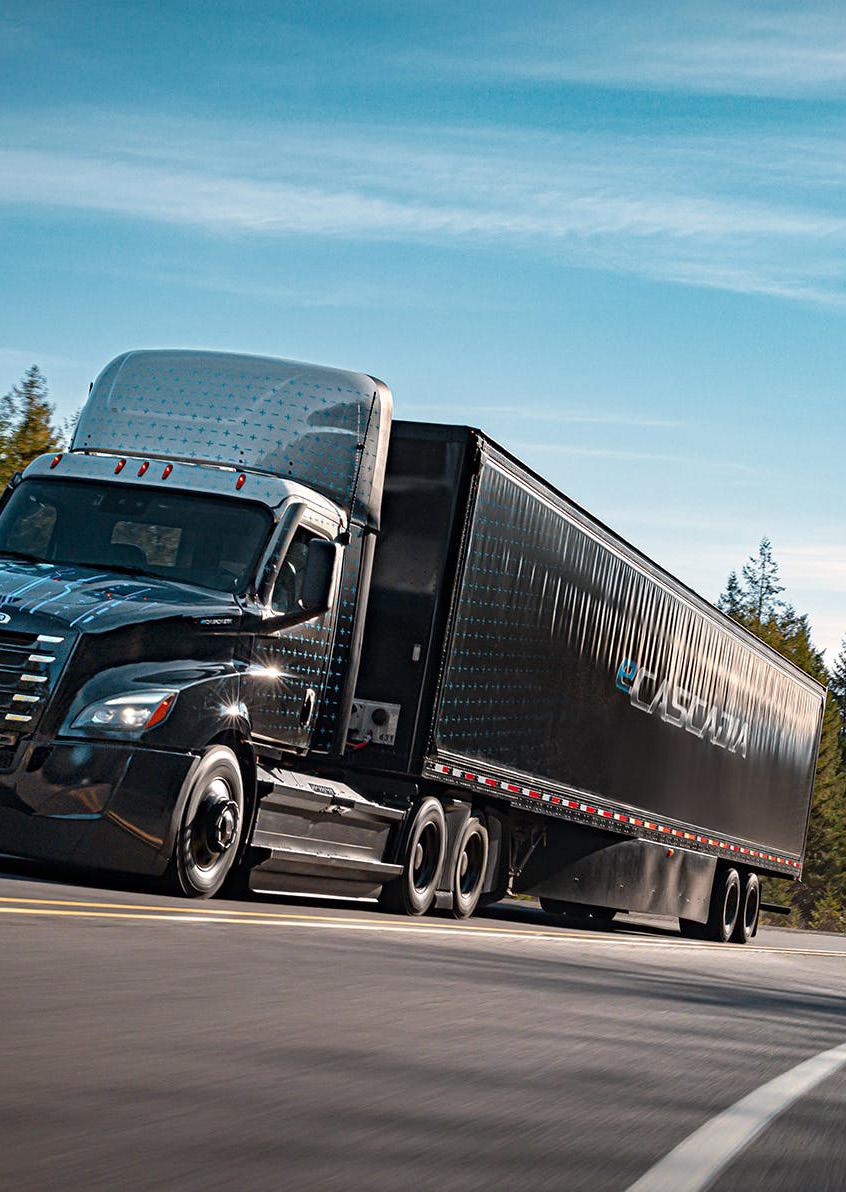
TOP TEN
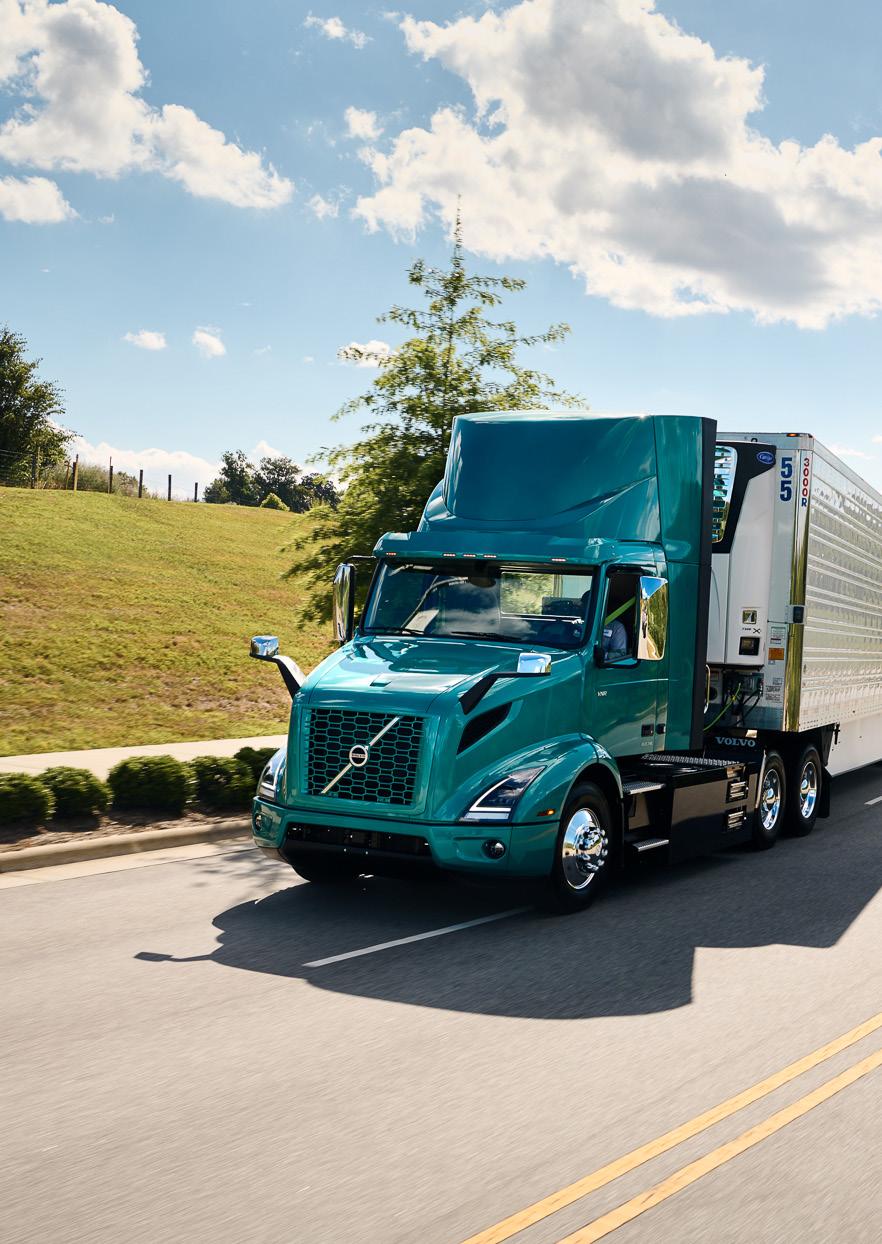
TOP TEN
As a major stakeholder in the three-way partnership with Daimler AG and Traton Group, Volvo Group has already developed electrified utility vehicles for the North American market. Known as the VNR Electric, its truck is intended for regional use.
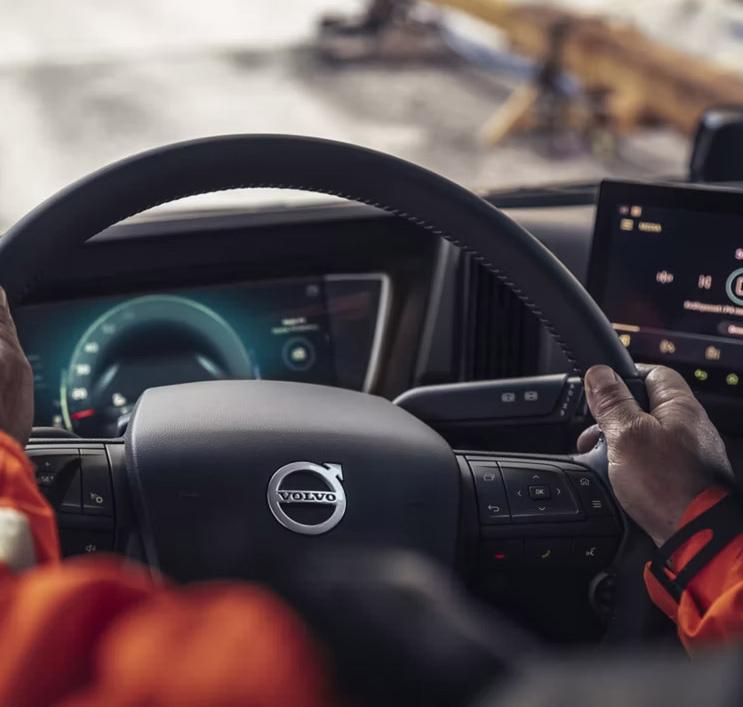
Since 2019, the truck has been tested on the roads, but now businesses are securing their orders. One of them is Maersk, which placed an order for 110 VNR Electric trucks in March 2022 to add to its previous order of 16.

#
1
WATCH A MULTI-INDUSTRY PLAYER
EVMAGAZINE.COM [Jan 2023] 101
VOLVO GROUP


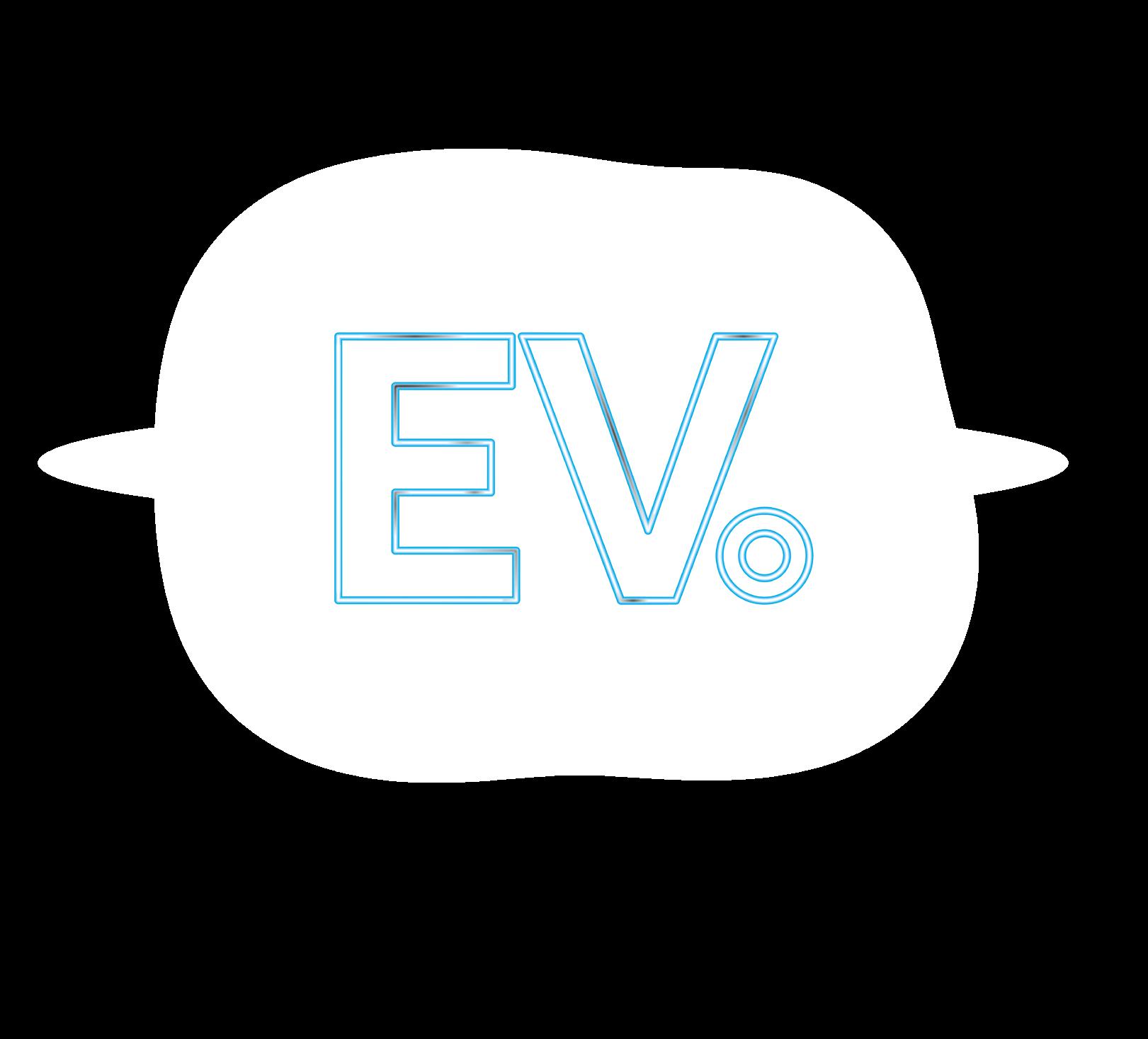
PRESENTS: THE FUTURE OF EV 2ND FEB 2023 6:55-8:20PM STREAMED LIVE FROM L ONDON TRANSPORT MUSEUM SPONSORED BY
Electrification is inevitable and business is a major part of it.
Electric vehicles have quickly become part of the wider push for e-mobility, particularly as countries looks to become more sustainable through transport innovation.
More and more people are turning to electric vehicles as a sustainable and eco-friendly alternative to traditional fossil-fuel-powered cars, of which businesses are to thank for the current infrastructure, automobiles, and technology advancements that we see today.

To celebrate this exciting shift towards e-mobility, EV Magazine will host an exclusive live show at the London Transport Museum on the 2nd February 2023.
This event will feature insights via keynote sessions and panel discussions to create a comprehensive view of the entire e-mobility process, from conceptualisation and sourcing through to the circular economy and transport longevity.


Attendees will have the opportunity to attend online or in-person (with limited availability). The event promises to be a great opportunity to not only learn about the EV industry, but also connect with like-minded individuals and businesses who are passionate about sustainability and the future of transportation.
Don't miss out on this exciting event and the opportunity to gain insights about the future of electric vehicles and e-mobility from some of the most influential people leading the industry.

Join us online or in-person and be a part of the movement towards a more sustainable future.

EVS ARE HERE, SO WHAT’S NEXT? GET YOUR TICKETS SPEAKERS INCLUDE: RODI BASSO CEO E1 SERIES ALEX GILBERT HEAD OF ENERGY & ELECTRIFICATION TRANSPORT FOR LONDON SARA SLOMA DIRECTOR, FUTURE FLEET PAYTHRU
CLARKE CHIEF VEHICLE OFFICER GRIDSERVE
NADA FOUNDER & CEO AEHRA EVMAGAZINE.COM [Jan 2023] 103
SAM
HAZIM










REGISTER FREE NOW DISCOVER THE FUTURE OF EV 2ND FEB 2023 | 6:55-8:20PM GMT LIVE VIRTUAL EVENT STREAMED FROM LONDON TRANSPORT MUSEUM RODI BASSO CEO E1 SERIES SARA SLOMAN CHIEF STRATEGY OFFICER PAYTHRU HAZIM NADA FOUNDER & CEO AEHRA SAM CLARKE CHIEF VEHICLE OFFICER GRIDSERVE ALEX GILBERT HEAD OF ENERGY & ELECTRIFICATION TRANSPORT FOR LONDON SPONSORED BY SPEAKERS INCLUDE:







 tom.swallow@bizclikmedia.com
tom.swallow@bizclikmedia.com










































 BY TOM SWALLOW
BY TOM SWALLOW














 TAG HEUER PORSCHE
TAG HEUER PORSCHE
















 PRODUCED BY: MIKE SADR
PRODUCED BY: MIKE SADR





























































































